
Cats On Liveaboard Sailboats - A Complete Guide

Last Updated by
Daniel Wade
June 15, 2022
Cats are fun, safe, and friendly companions to countless liveaboard sailors. Caring for a cat on a sailboat can also be easy.
Cats can live safely and comfortably aboard sailboats with proper space, ventilation, climate control, and safety precautions. Most cities and marinas allow cats aboard, and they’re easy to care for if you take a few extra measures.
In this article, we’ll cover everything you need to know about living aboard a sailboat with a cat (or two). We’ll go over the best breeds for sailboats, essential cat safety measures, indoor and outdoor cats, toys and entertainment, and how to keep your cabin clean.
We sourced the information for this article primarily from the tips of liveaboard cat owners. We also researched cat breeds and behavior, along with which cats are best suited for long-term living aboard a sailboat.
Table of contents

Can You Keep a Cat on a Sailboat?
Yes! Cats are some of the best pets to have aboard sailboats. They generally require less attention in terms of exercise than dogs, and many cats can acclimate easily to living on a sailboat. Cats offer great company, and they’ve been kept on boats and ships for decades.
That said, there are several unique challenges that cat owners face while living aboard a sailboat. We’ll go over the best supplies and strategies soon, but first, we’ll cover the rules and legality of keeping cats in liveaboard sailboats.
Marina Rules and Pet Regulations
The most likely issue you’ll run into is the marina itself. Some marinas that allow liveaboards have strict pet policies. These are instituted primarily for sanitation reasons, and violating the rules can get you kicked out.
Liveaboard slips are hard to come by these days, so it’s best to abide by the marina’s policies. Be sure to contact your chosen marina and make sure you’ll be allowed to keep a cat on board. Some marinas have policies strictly for dogs or outdoor cats, so you may be off the hook.
Local Pet Ordinances
Local ordinances apply in just a few situations. First, some communities set limits on how many pets can occupy a residence. These limits are usually based on square footage, which is where liveaboards usually run into trouble.
For example, a city or county may specify that you can only keep one pet per 100 square feet of interior space. These rules may or may not apply to mobile dwellings (such as RVs and boats), so it’s best to check first. Regardless, most standard cruising sailboats can only comfortably (and hygienically) harbor one or two pets at a time.
How Many Cats Can You Keep on a Sailboat?
This question depends entirely on your cleaning capabilities and the size of your sailboat. A 30-foot sailboat cabin gets awfully cramped with two or three cats aboard, not to mention the litter box problem. Multiple cats using a litter box in a well-sealed fiberglass tube isn’t a good situation.
As a general rule, it’s best to start with one cat regardless of the size of your boat. That way, you can get acclimated to taking care of a cat on a boat before taking on additional pets. For vessels under 40 feet in length, two cats is a reasonable limit.
Benefits of Liveaboard Cats
There are numerous benefits to living aboard a sailboat with a cat! The first and most common benefit is the companionship of having your pet aboard. It can greatly enhance the atmosphere by adding comfort and a real sense of ‘home’ in the very utilitarian environment of a sailboat cabin.
Additionally, cats are a great way to keep pests from occupying your vessel. Many sailors leave the hatches open during the summer, and sailboats are a five-star destination for mice and other disease-riddled rodents. Cats are humanity’s oldest and most effective pest control system.
Cats also provide a great opportunity to bond with other liveaboards. From arranging playdates to sharing common experiences, keeping a cat or two aboard your sailboat is sure to add an extra layer of quality to your experience.
Indoor or Outdoor Cats: Which are Best for Sailboats?
The indoor/outdoor cat debate has raged between homeowners for decades, and the question is even more important to consider as a liveaboard.
The primary issue here is that cats are difficult to keep contained aboard a boat. Sailboats have lots of large openings for people to move in and out of. Hatches and portlights present ample opportunity for cats to ‘escape’ and run off up the dock. Having an outdoor cat somewhat negates the issue, as they’re free to come and go as they please.
Outdoor cats are the easiest to deal with if you like opening up your boat frequently, and it frees up deck space for your cat to relax and exercise in your presence. However, outdoor cats can bring in ticks and fleas, which can rapidly overrun a confined space like a sailboat cabin.
Indoor cats eliminate the tick and flea issue, but you’ll have to keep a much closer eye on them. Some cats naturally won’t stray off the boat, so there’s a possible solution. And yes, it’s entirely possible to keep a cat from escaping a sailboat if some precautions are taken.
Which Cat Breeds are Best for Liveaboard Sailboats?
Believe it or not, there are several cat breeds that are adapted for life on the water. It’s no guarantee that your cat will swim like a Golden Retriever, but many breeds are known for their affinity for water.
The best cat breeds for sailboats are the American Bobtail, the Maine Coon, the Manx, the Japanese Bobtail, the Norwegian Forest Cat, the Turkish Angora, the American Shorthair, the Turkish Van, and most varieties of Bengal cats.
How to ‘Cat-Proof’ Your Sailboat
Cat-proofing your sailboat is essential if you’re planning to have one aboard. Cat-proofing refers to steps you should take to protect your cat from getting into areas where it shouldn’t be.
First, make sure to seal off any open access to the bilge. Sailboat bilges are often wet, unsanitary, and confined—which is just asking for trouble. Additionally, make sure your cat can’t get into the engine compartment or anywhere fuel and oil are stored.
Make sure to enclose access to electrical panels and wiring, as cats are known to chew up or destroy essential wiring and systems. Also, they can give themselves an unpleasant shock from rubbing against or biting into the wrong wires.
All other spaces on your sailboat should be safe for cats, as long as they’re accessible and open. Make sure to keep cupboards closed, and consider adding netting over deep cubbies to prevent your cat from getting stuck or trapped behind a panel or bulkhead.
Liveaboard Cat Safety
Keeping your cat safe aboard your sailboat can be easy. The main concerns are temperature, water, and the environment. Below, we’ll go over how to keep your pet safe and comfortable in the unique environment of a liveaboard sailboat.
Can Cats Swim?
Many cats can swim to some extent, but they usually don’t like it. Any cat owner who’s tried to give their cat a bath can attest to this fact. However, cats can be acclimated to the water with some patience and routine practice.
Lifejackets for Cats
It’s a good idea to spend time in the water with your cat, as you want to be sure it can swim if it falls overboard. Using a specialized cat life jacket is a great way to start. These lifejackets are also useful in an emergency.
Leashes and Harnesses
Having a leash and a good cat harness is a great way to safely let your cat enjoy the deck space of a sailboat. Many liveaboards attach a leash to the deck rail or a stay wire. A leash and harness essentially double the amount of space your cat has to hang out.
If it’s long enough, it’ll allow your cat to explore and hang out on the deck without running away. Just be sure to keep it untangled from lines and rigging. Don’t attach a leash to a collar, as it can be hazardous if your cat tries to jump off the boat or gets snagged in the rigging.
You can also incorporate a lifejacket into a leash system, which is especially helpful when making an offshore passage or getting underway. It’s a great and inexpensive upgrade for you and your cat.
Climate and Temperature
When it comes to temperature, the same rules that apply to cars also apply to sailboats. Never let your boat get too hot with your cat inside. Make sure the vessel is well ventilated, heated, and air-conditioned if possible. Sailboat cabins can get extremely hot quite fast. Remember, if you’re sweating, your cat could be overheating much worse.
Cats on Sailboats: Sanitation
Nobody likes to think about sanitation, but it’ll be the only thing on your mind if your boat isn’t cat-friendly. Small spaces can be soiled rapidly, especially with an animal onboard. However, you don’t have to resign yourself to a dirty space when you have a liveaboard cat.
Litter and Litter Boxes
Choosing the right litter and litter box is essential to maintaining a clean and disease-free sailboat cabin for you and your cat. Cat waste is noxious and must be contained effectively.
Don’t skimp on litter quality! Deodorants in cheap litter only mask the smell for a short time (if at all), so it’s best to find a product with odor-killing abilities. The best way to do that is to purchase high-quality anti-odor cat litter (the pricey stuff) and a partially-enclosed litter box.
Food and Water
Food and water are pretty self-explanatory aboard a sailboat, but it requires spatial consideration. You can still feed your high-quality cat food as long as there’s enough room aboard to store sufficient supplies. Additionally, you’ll need an anti-spill water bowl to prevent your floating home from rolling and spilling water everywhere.
Hair Control
Most cats shed, and cat hair isn’t the best addition to your upholstery. Thankfully, cat hair and other allergens can be controlled effectively with proper ventilation and cleaning tools. A simple dustbuster is sufficient for cleaning furniture and scooping up stray chunks of litter.
Ventilation
Keep that air moving! Cats need fresh air, and so do humans who live in confined spaces with cats. It’s easy to ensure your sailboat has adequate ventilation. Simply install a few solar-powered deck vents and crack a porthole. Additional passive ventilation (like a wind scoop) can be a lifesaver on hot and stagnant days.
Waste Disposal
You’ll probably have to clean the litter box about twice as often when living aboard a sailboat. The most important thing to remember is to get the waste off the boat as soon as possible.
Avoid flushing it down the toilet, as litter can expand and ruin pipes and septic tanks. Instead, bag it and take it to the marina dumpster. If you perform this task once every day or two, you’ll be in great shape.
Cat Toys for Liveaboard Sailboats
Keeping your cat entertained is pretty simple on a sailboat. Most liveaboard cat owners have a wide array of typical small cat toys. You could let your cat scratch up the furniture freely, though it’s better to find a place to add (or build) a scratching post.
Some sailors turn the bottom of a wooden bulkhead into a scratching post by stapling a sheet of thick cat carpet around the base. Other possible scratching post locations include the base of the mast, the centerboard trunk (if you have one), and the base of a table.
Related Articles
I've personally had thousands of questions about sailing and sailboats over the years. As I learn and experience sailing, and the community, I share the answers that work and make sense to me, here on Life of Sailing.
by this author
Most Recent

What Does "Sailing By The Lee" Mean?
October 3, 2023

The Best Sailing Schools And Programs: Reviews & Ratings
September 26, 2023
Important Legal Info
Lifeofsailing.com is a participant in the Amazon Services LLC Associates Program, an affiliate advertising program designed to provide a means for sites to earn advertising fees by advertising and linking to Amazon. This site also participates in other affiliate programs and is compensated for referring traffic and business to these companies.
Similar Posts

How To Choose The Right Sailing Instructor
August 16, 2023

Cost To Sail Around The World
May 16, 2023

Small Sailboat Sizes: A Complete Guide
October 30, 2022
Popular Posts

Best Liveaboard Catamaran Sailboats
December 28, 2023

Can a Novice Sail Around the World?
Elizabeth O'Malley

4 Best Electric Outboard Motors

How Long Did It Take The Vikings To Sail To England?

10 Best Sailboat Brands (And Why)
December 20, 2023

7 Best Places To Liveaboard A Sailboat
Get the best sailing content.
Top Rated Posts
Lifeofsailing.com is a participant in the Amazon Services LLC Associates Program, an affiliate advertising program designed to provide a means for sites to earn advertising fees by advertising and linking to Amazon. This site also participates in other affiliate programs and is compensated for referring traffic and business to these companies. (866) 342-SAIL
© 2024 Life of Sailing Email: [email protected] Address: 11816 Inwood Rd #3024 Dallas, TX 75244 Disclaimer Privacy Policy

Cat on a Boat 101: How to Sail and Live Aboard with Cats

As an Amazon Associate, we earn from qualifying purchases. We also earn from other affiliate websites. See our full disclaimer .
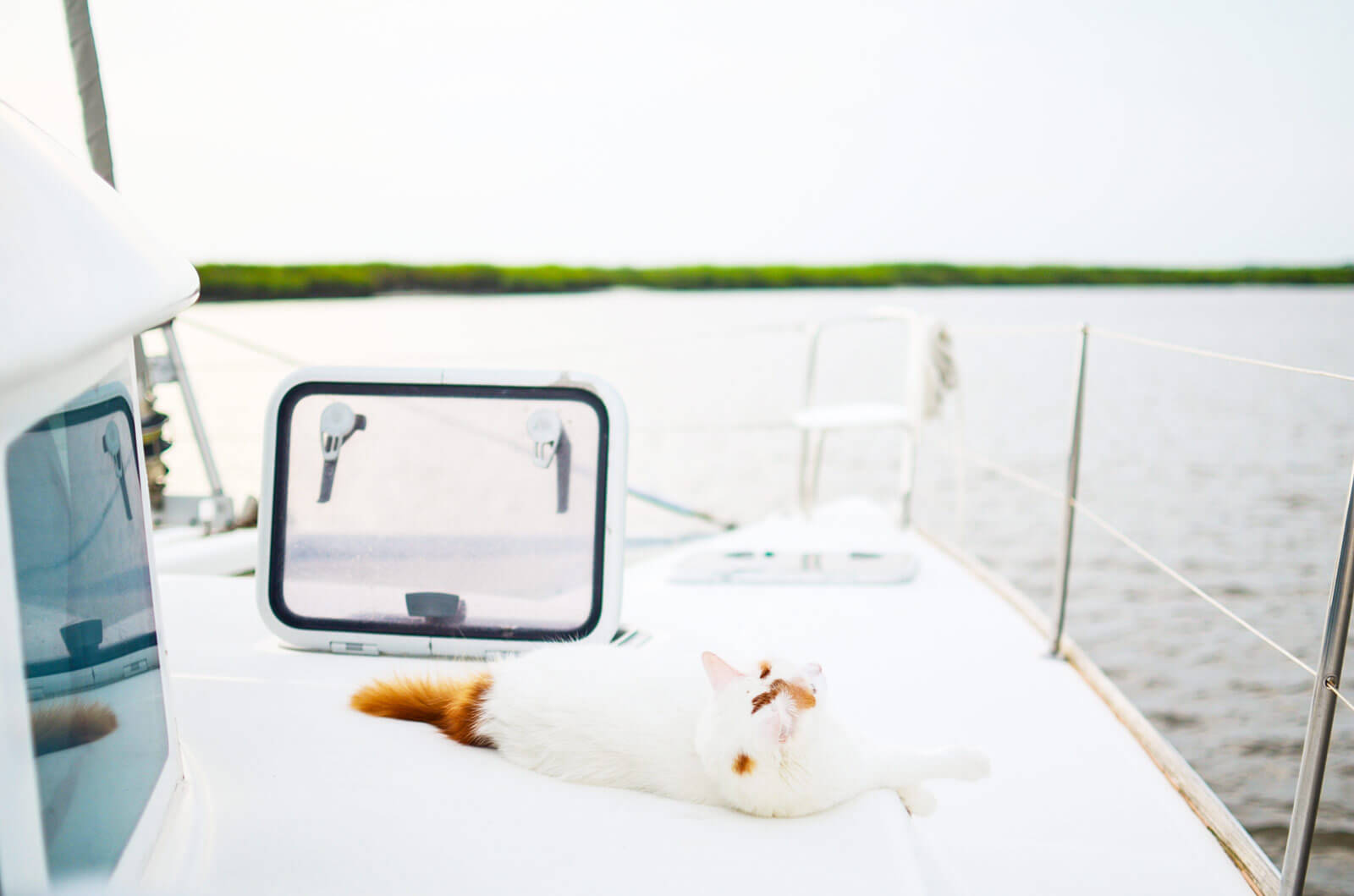
At first glance, having a cat on a liveaboard boat may seem like a lot of work and maybe not even possible. However, with patience and preparation having a cat on board can be a wonderful experience for both you and your feline first mate.
We’ll help you get started with prepping your boat for your cat’s arrival, finding gear you might need for your new liveaboard kitty, and how to keep your cat safe and healthy on board.
Getting Started with Your Boat Cat
Are you wondering if you can take a cat on a boat? I’m happy to report it is possible to turn your everyday house cat into a full-blown adventurous sailing cat.
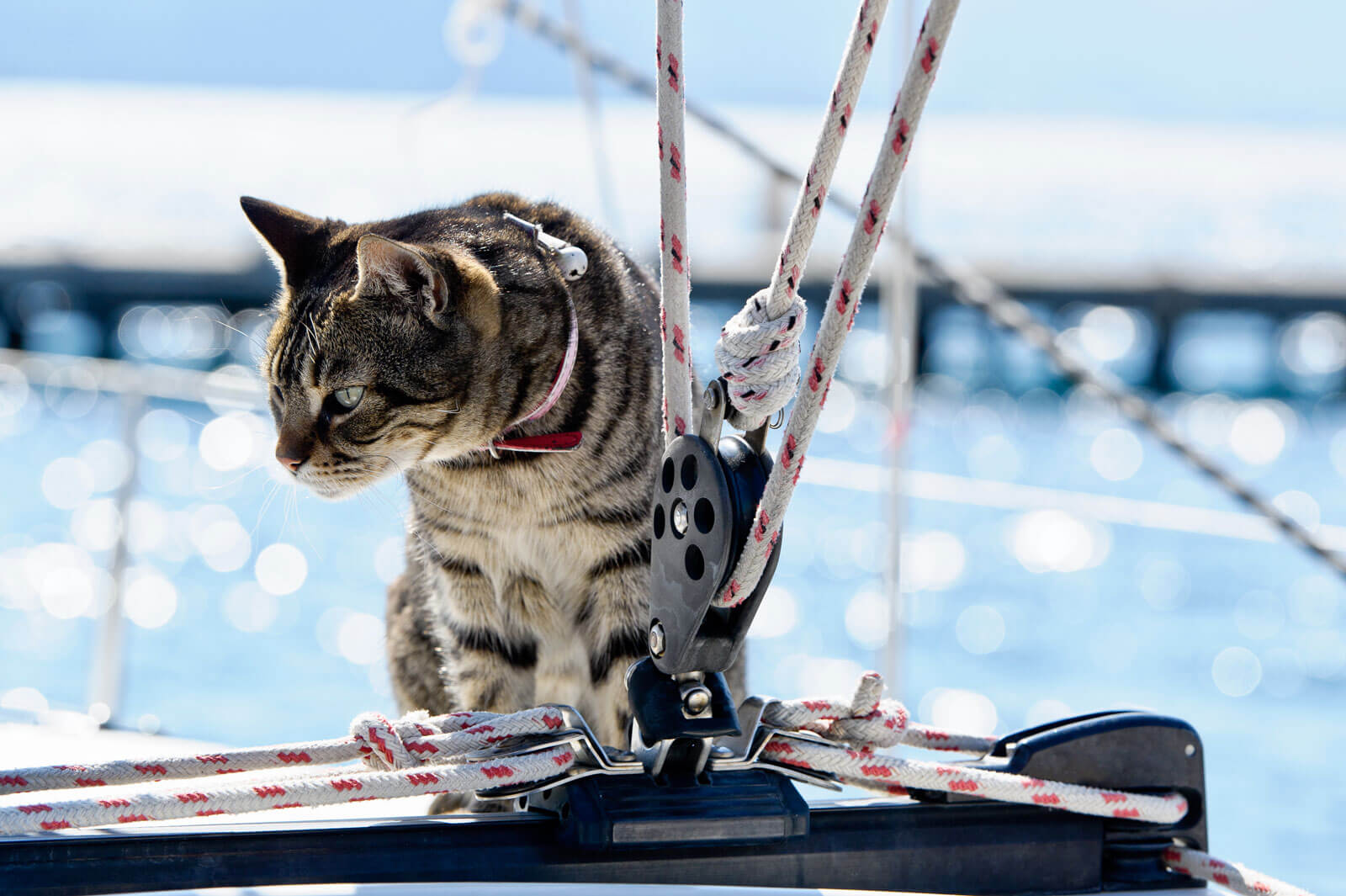
Some kitties may take to boat life quicker than others, but eventually, most cats can become happy liveaboard boat cats with the right approach.
Introducing Your Cat to the Boat
We introduced our cat to our 38-foot sailing catamaran by having short visits (2-4 hours) while the boat was at the dock. We would work on the boat, and Augustus would come along and hang out. Once we moved onboard, he already felt comfortable in the space.
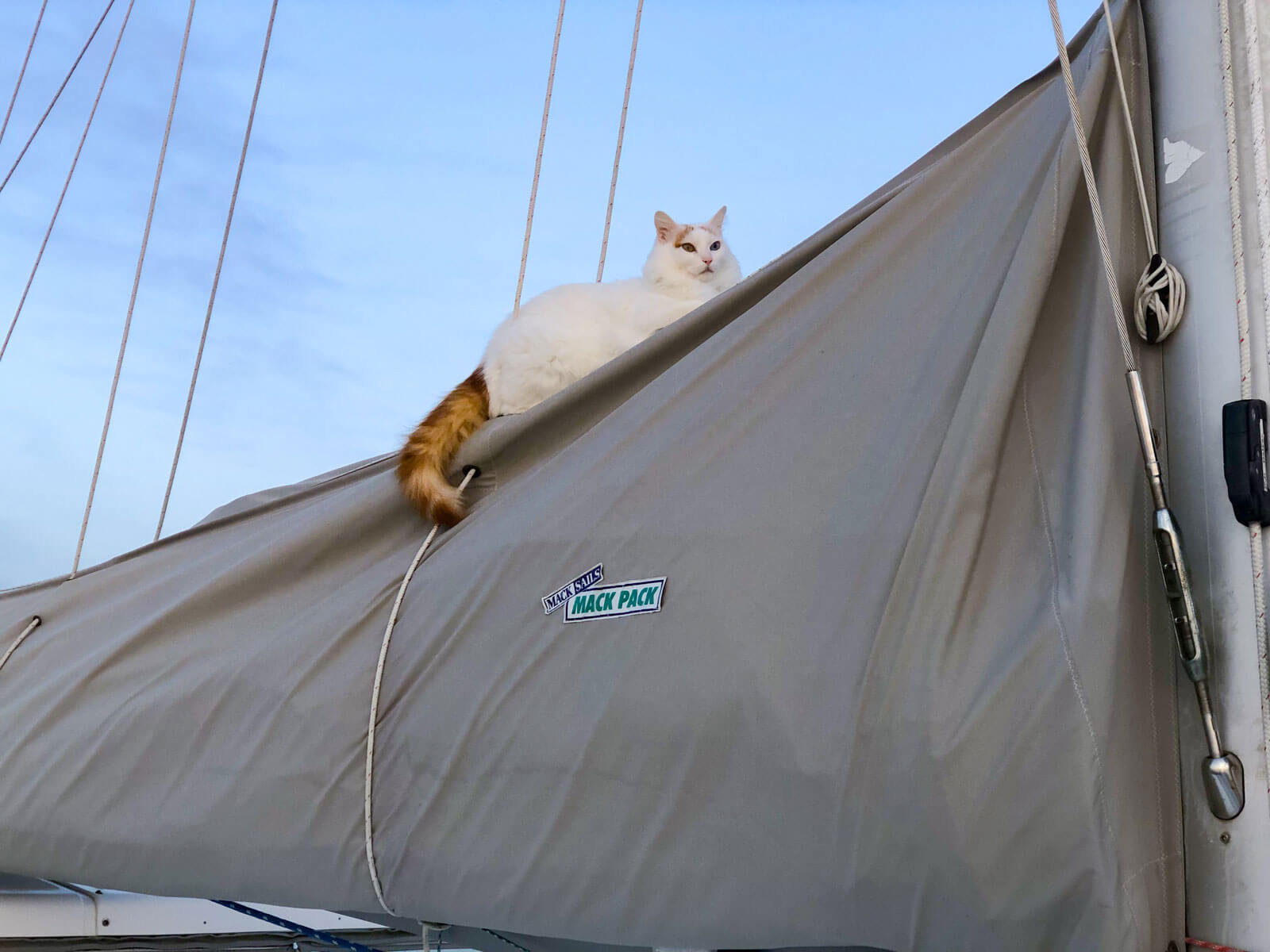
We would occasionally run the engines and let him get used to the sound. When we finally left the dock, he was still getting used to the engines and would find a spot down in the V-berth to hide. The more we traveled, the more comfortable Augustus became. He eventually started coming up on the bridgedeck, sitting in the windows and sometimes popping into the cockpit in calm seas.
No matter how accustomed your cat becomes to the boat, everyone is uncomfortable in rough conditions. Allow your cat some space since they might feel queasy.
Cat Proofing Your Boat
Cats are notably mischievous. If you don’t keep your wits about you, this can be a problem on a boat!
Any time we open a hole under a settee or open up a wall, Augustus is right there to see what’s happening.
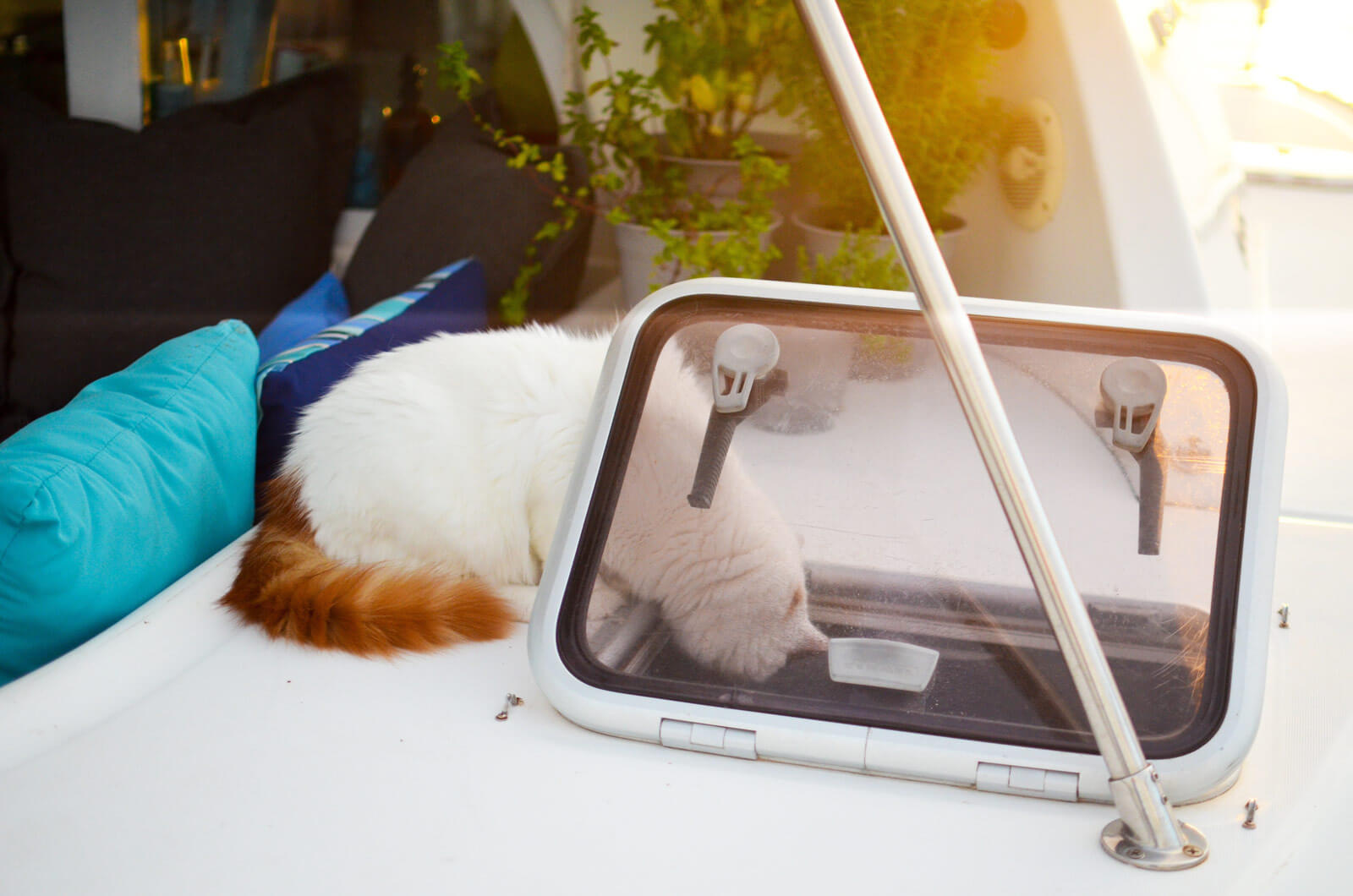
Augustus has been stuck in the bilge for the better part of a day AND locked in a berth all night because the door swung closed. One time he even climbed through the settee in the bridgedeck and managed to pop out in an access hole under the bathroom sink in the starboard hull. The moral of the story – if you need to run a wire, get a cat!
But seriously – with a cat aboard, don’t leave any hole accessible. No matter how small, no matter how short a period.
Cats and Seasickness
Many cats are like humans. They feel sick for the first day or so on the water, and then they start to feel better.
Signs of seasickness in cats:
- licking lips a lot
- uneasy demeanor
Fresh air is as essential to them as it is to us. Getting them in the cockpit might help, but don’t push it if they are scared.
Most cats will find a spot to ride out the queasy feeling.
You can get anti-nausea medications from a vet for severe circumstances as a last resort.
Cruising with a Cat in Hot Climates
A question we often get is how do you keep your cat cool when sailing in hot climates.
Here are a few tips to keep your cat cool on hot days.
- wet bottom of paws, nose, and ears if the cat becomes overheated
- use wind scoops for airflow and leave hatches open with screens in to keep your cat inside but the air moving (we often use this setup on anchor when we go to shore)
Cat Food On Board
If you’re cruising on your boat, you’ll probably want to stock up on cat food just as you would other essential food items.
When we buy cat food, we get an 18-pound bag of dry food along with many cases of wet food.
To keep your cat’s dry food fresh, it must be in a sealed container. You don’t want moisture or any critters getting into that precious kitty food supply. Also, you don’t want your cat turning up their nose at stale kitty food halfway through the supply.

We use the Vault pet food storage container to keep cat food fresh and love it!
We also use a smaller container such as this one for daily feedings, so we aren’t constantly opening the long-term food storage container. This method helps keep the cat’s food freshest. We have never had any contamination with this system.
You might also want to consider a kitty food mat to ensure food and water bowls stay in place when underway. We like this mat from CatGuru . This works on a catamaran, but you might need to store the bowls when underway on a monohull.
Suggested Cat Food Products
Cat food and storage products we love for living on a boat.

PRO TIP: We like Chewy.com for ordering pet food on the go in the US. They offer 1-3 day shipping on orders over $50. You can order a few days ahead and have it shipped to a marina along your route.
The litter box.
Managing a litter box is always a complex task, and it is especially challenging in a small space such as a boat.
Boats are usually in motion, don’t always offer an easy way to dispose of waste, and can be very humid.
Here are a few ideas for handling these obstacles.
- Invest in a top entry litter box to contain the litter
- Use a Litter Genie to store cat waste until you can dispose of it (it works just like a diaper genie)
- Find a location for the litter box that will have the least amount of humidity
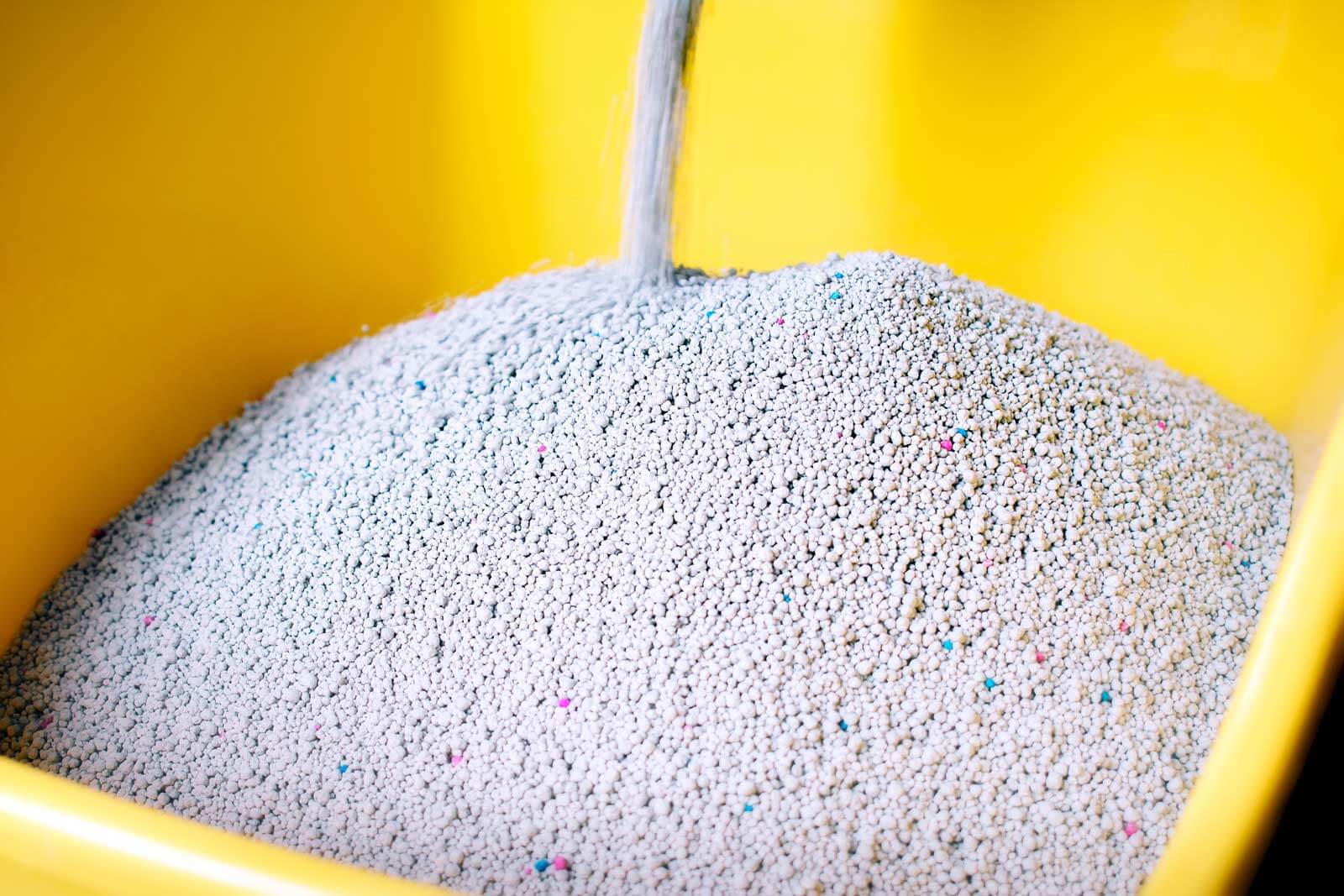
Choosing a Litter
There doesn’t seem to be a perfect litter choice for cats on a boat. Every option has pros and cons. Below is the litter we use and another popular option from cruisers. Both of these options let you avoid carrying hundreds of pounds of litter around on your boat if you are cruising in remote waters.
- Breeze Cat Litter System – Boat owners seem to really like the Breeze Cat litter box. When the cat does its business, the pee falls through the box onto a pee pad below. The poop is scooped. Because the urine is separated, the litter pellets in the top of the box last a lot longer than the average litter. There are concerns about the price of the pee pads and the litter pellets. We’ve heard of cat owners who have bought 3rd party pads and have found ways to wash and reuse the pellets. There is a ton of information on this system if you search the Gatos Del Mar Facebook group .
- Pretty Litter – We have been using Pretty Litter for four years now. It’s nice because it lets you know if your cat has any health issues within the urinary tract. This synthetic litter is non-clumping, soaks up pee, and allows you to scoop the poop. It minimizes the amount of waste we add to the Litter Genie since it is non-clumping. However, it works by soaking up urine, which is not great for a humid environment and doesn’t last as long on a boat.
Suggested Cat Litter Products
Durable and long-lasting litter products we love for boat life.
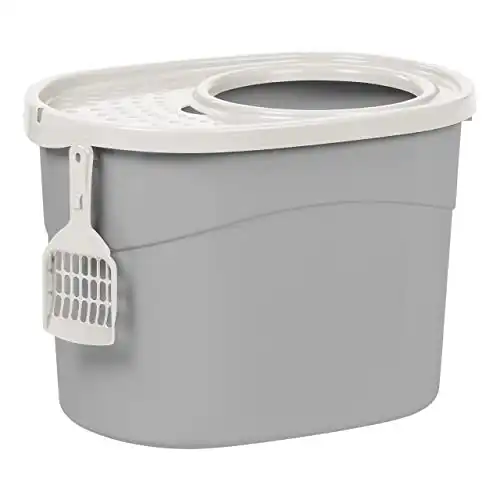
NOTE: Some boat owners toilet train their cats to avoid dealing with a litter box onboard. Training can be a long process that requires patience, but it might be worth the effort, especially if you have a young cat who is eager to learn.
Gear for cats on boats.
Boat and sailing cats need a few more pieces of gear than the average cat. Here are some items to help your kitty stay safe while still enjoying themselves on a boat.
Life Jackets for Cats
So when should your cat wear a life jacket? Short answer – it’s totally up to you.
Watch your cat closely in their first few months aboard. They will be finding their rhythm and testing their limits. This is the time when our cat took his first dip in the ‘drink’ (and he was without his cat life jacket). I would suggest putting the life jacket on your cat more often upfront until your cat becomes more familiar with boat life. Once they start getting their bearings, you can choose to put it on them less.
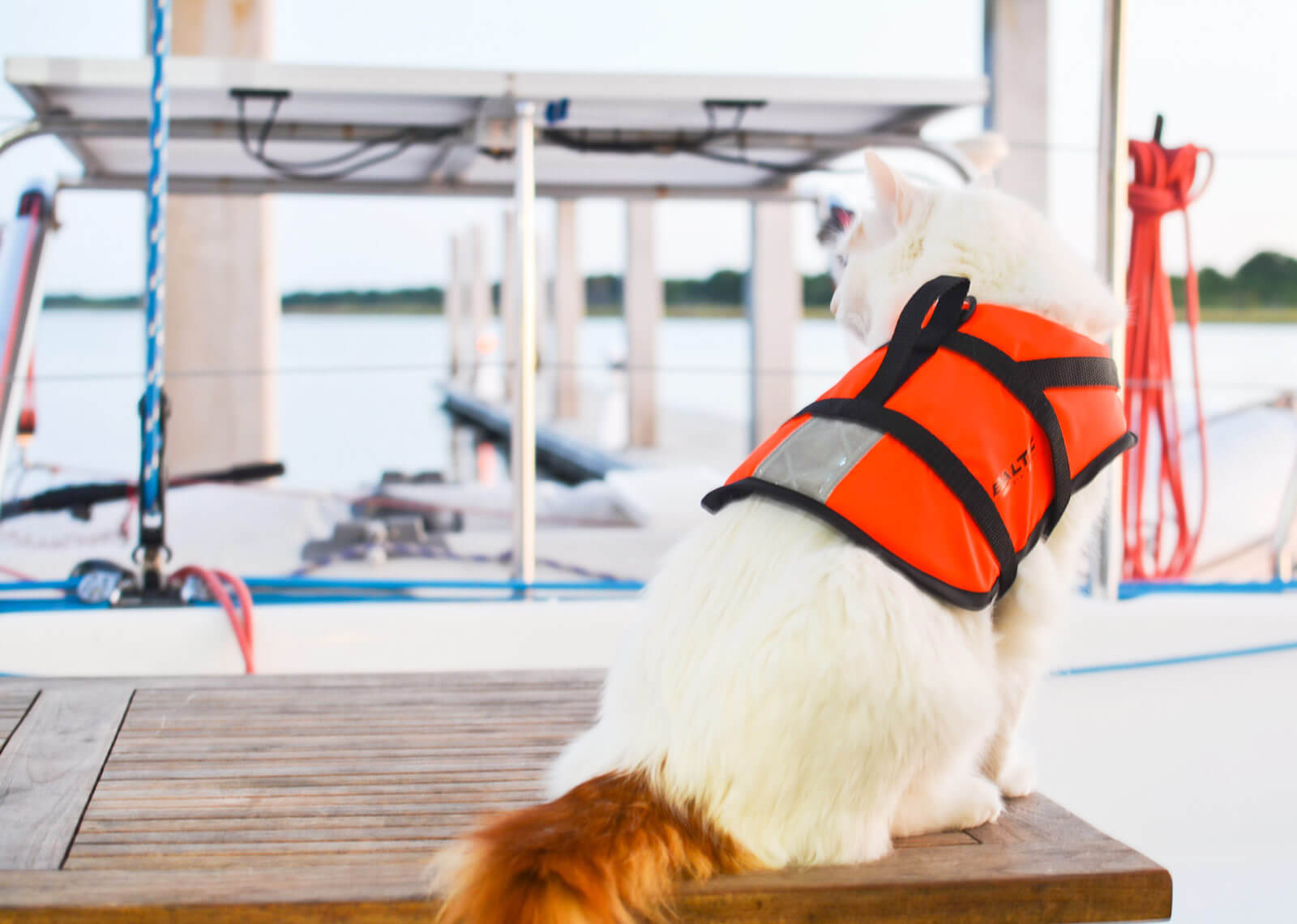
Can Cats Swim?
Most cats can swim. They just don’t particularly want to. Many cruisers will train their cat to climb a rope on the side of the boat if they fall over. Augustus could easily climb up on the sugar scoop of our catamaran in calm water, and that’s just what he did when he fell in at the dock.
PRO TIP: If your cat does fall in the water, make sure you bathe them. Marina water is especially dirty and can contain diesel fuel and “other things” that might come out of a boat. You don’t want them licking themselves without first getting a bath.
Cat life vest suggestions.
Cat life jackets are pretty hard to come by. Below are a few life vests designed specifically for cats that come highly recommended in the cat owner boating community.
Baltic Maja Pet Buoyancy Aid – A cat-specific life jacket with a smaller neck opening than what you see with most dog-designed jackets. It also has an extra strap underneath for more support.
Lyra Cat FFD (Feline Flotation Device) – A cat-specific life jacket similar to the Baltic but also has a built-in harness for extra comfort. This jacket was designed and tested by a sailing cat owner.
SurferCat Life Jackets – Another life jacket made just for cats. This one is designed by a pro wakeboarder who wanted something for their cat that is very minimal and built with performance and mobility in mind.
Cat Backpack or Carrier
You’ll want a way to transport your furry feline if you are living aboard.
We love our backpack carrier because it makes moving Augustus around in this lifestyle easier.
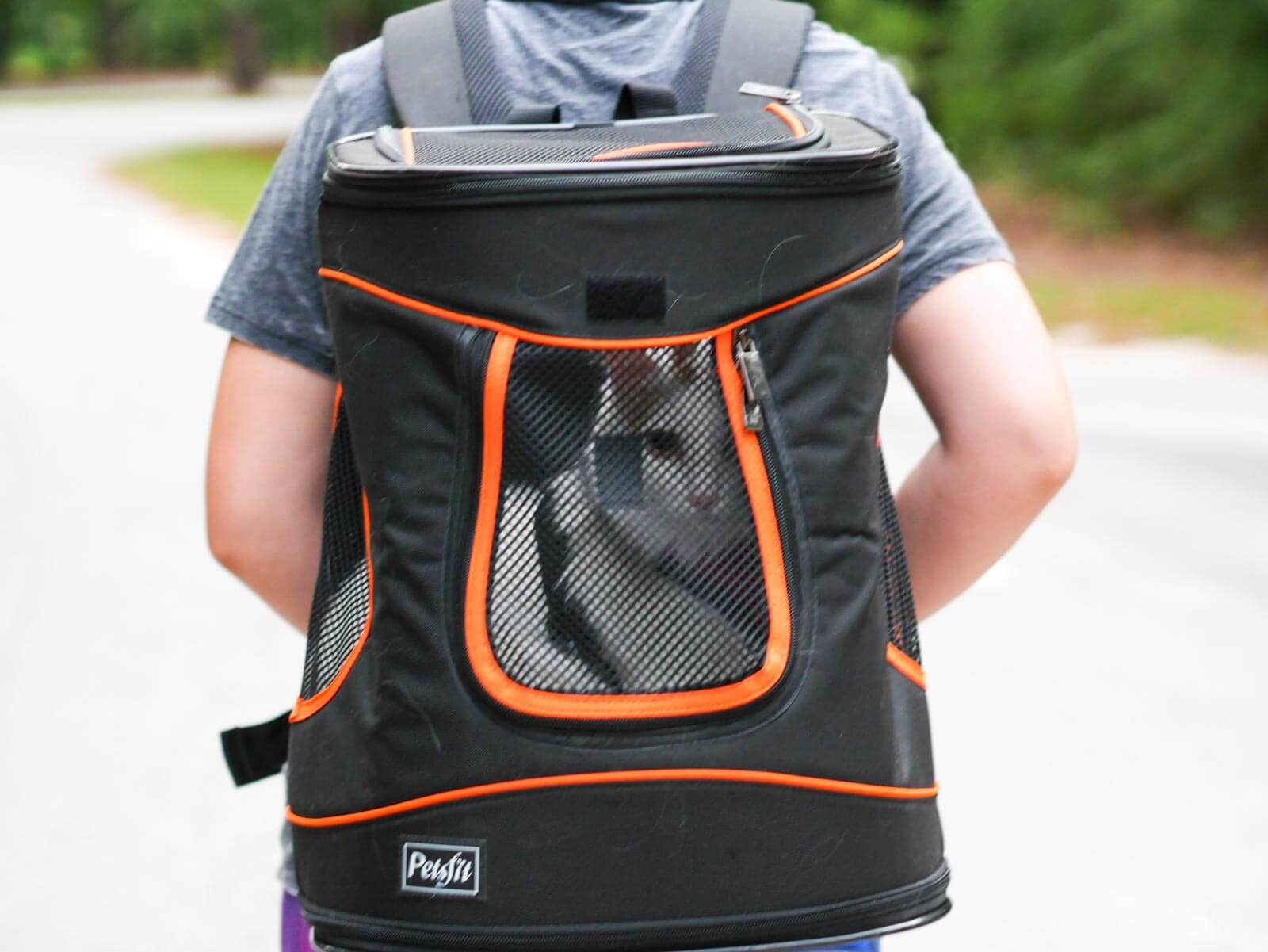
The backpack offers hands-free carrying on and off the boat. It’s a stable and safe carrier for our cat, whether we have to cab, walk, or bike to a vet or other location.
They even have backpacks that expand for comfort traveling in a vehicle. Search cat backpacks on Amazon here.
Harness and Leash
Harness training your cat is one of the best things you can do to make your and your cat’s new life easier on a boat.
It will allow you the freedom to take your cat for walks at the marina or dinghy them to shore for land time.
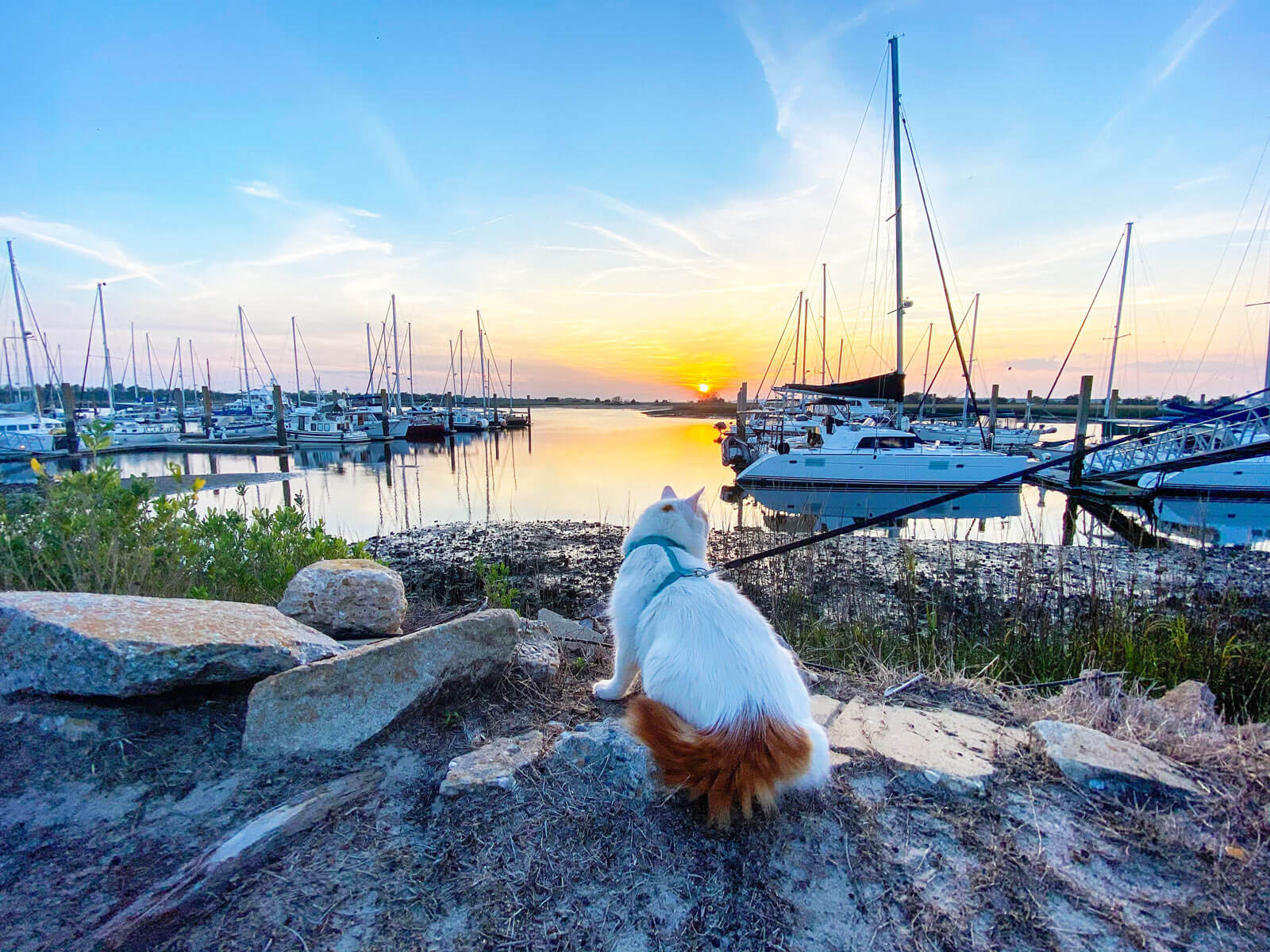
Once your cat is harness trained, don’t let your cat on deck or off the boat without a harness. This approach can keep your cat from darting out the door, and they will associate the harness with time outside.
We’ve used many different harnesses over the years. Here are a couple of our favorites:

PRO TIP: Make sure whatever harness you choose as an adjustable neck for the best fit.
Cat trackers.
A tracking device is another good idea when you have a cat that wanders off the boat in a marina or one that you take ashore.
The longer our stay in a marina, the more comfortable Augustus becomes venturing off the boat. Occasionally, he might slip by us and wander up the dock (or onto another boat) without anyone noticing.
Trackers are great for quickly locating your kitty on the dock or even finding them if they wander away from the marina.
Here are a couple of trackers we have used and our reviews of each.

The Tile Pro is a Bluetooth tracker that is intended to track things like your keys, but we found it was an affordable option that worked well to track our cat. We attached it to the D-ring on the cat’s harness. The Pro version has a 400-foot range.
- Inexpensive compared to other trackers
- Small and lightweight compared to most trackers
- Water-resistant
- The battery is easily replaced after months of use
- Within range, you can 'ring' the Tile to locate your cat
- Out of the 400-foot range, there is no tracking
- No directional tracking (you get status updates (‘moderate’ or ‘strong’ signal), but you can’t tell in which direction
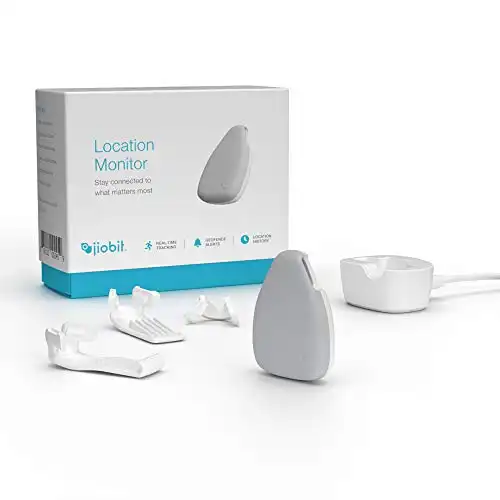
The Jiobit is a tracking device designed to track pets, children, and/or seniors. This device uses Bluetooth, Wifi, and a required cellular data plan to track the person or pet the most accurately while conserving battery life.
- Track at any distance with the data connection
- Live tracking mode to view cat’s movement in real-time
- Can alert you when your cat leaves a designated area
- Small size compared to other GPS trackers
- Requires a monthly data plan
- Needs charging once a week (on average)
- Live tracking mode will drain the battery quickly
- Data plan will not work outside of the U.S.
- Will scratch easily if you don’t purchase the optional cover/sleeve
PRO TIP: As a backup, we have Augustus microchipped (this is required to check into some countries). We also attach a pet ID tag to his harness with our phone numbers. We have also seen cat owners that have their contact and/or boat information embroidered into the harness. There are shops on ETSY that will do this for you.
Vet & pet health.
Pet care can be a little tricky when you are traveling often. Especially on the water.
Here are a couple of tips to ensure your cat is taken care of.
- Always keep a good account of your cat’s health records. We keep a digital file so we can both easily access them. This way, when we visit a new vet, it’s easy to give them all the information they need.
- If you have pet insurance, make sure you are covered in the area you are traveling.
- Talk to your vet about putting together a kitty first aid kit
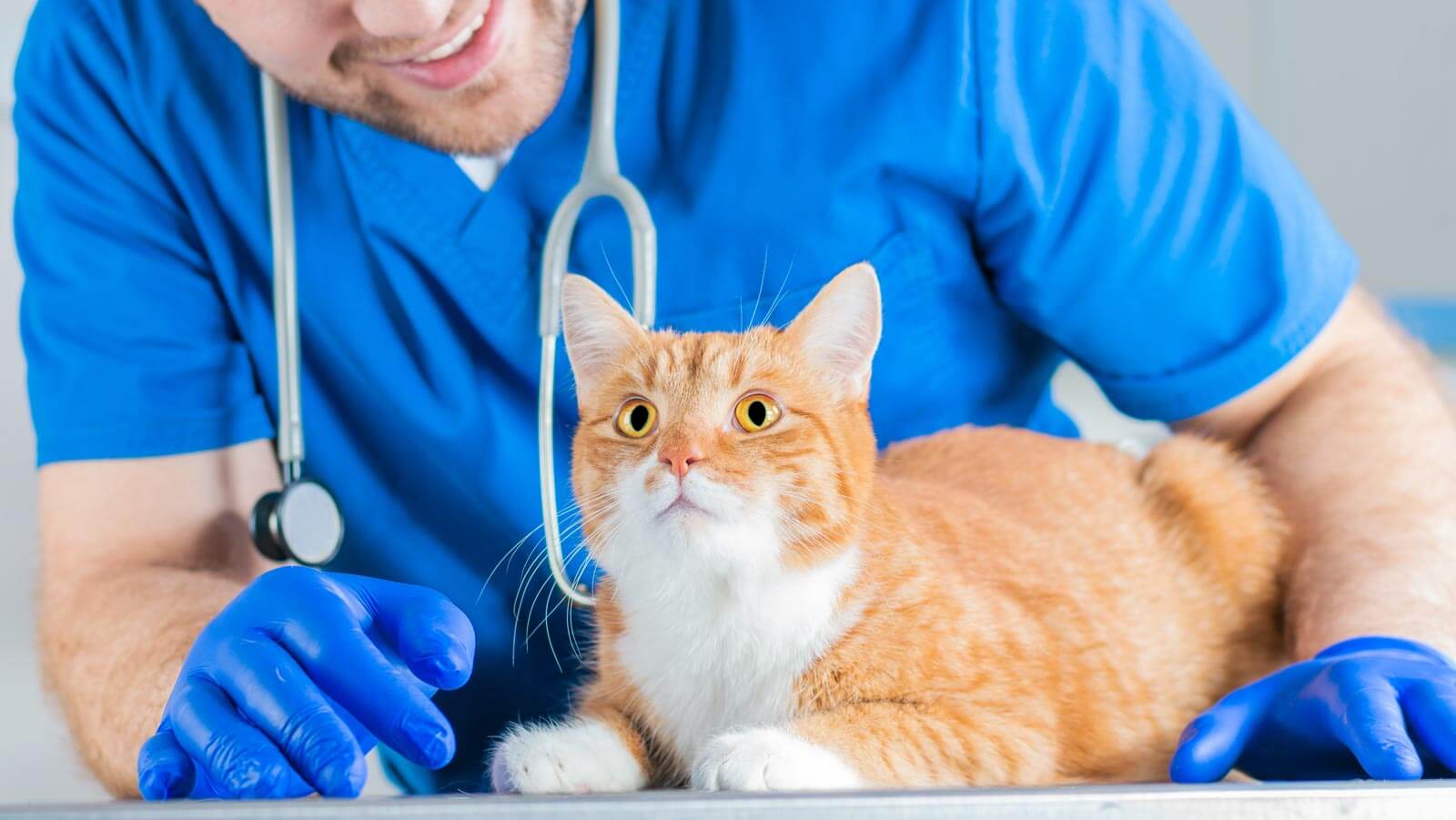
Traveling to Different Countries with Your Cat
If you are planning to travel to different countries on your boat, you’ll need to check each country’s requirements for cats.
Many countries will require a health certificate to enter the country. If you are going for a health certificate, you need an appointment for just the health certificate. The appointment can’t also be for a checkup or other issue. Most countries will also require a 1-year rabies shot (instead of a 3-year), FVPR, and possibly the feline leukemia vaccine.
Check noonsite.com for details on cat check-in requirements for different countries.
More Resources for Living Aboard with Cats
Luckily, there are quite a few people out there sailing with cats! You can find more information when you know where to look.
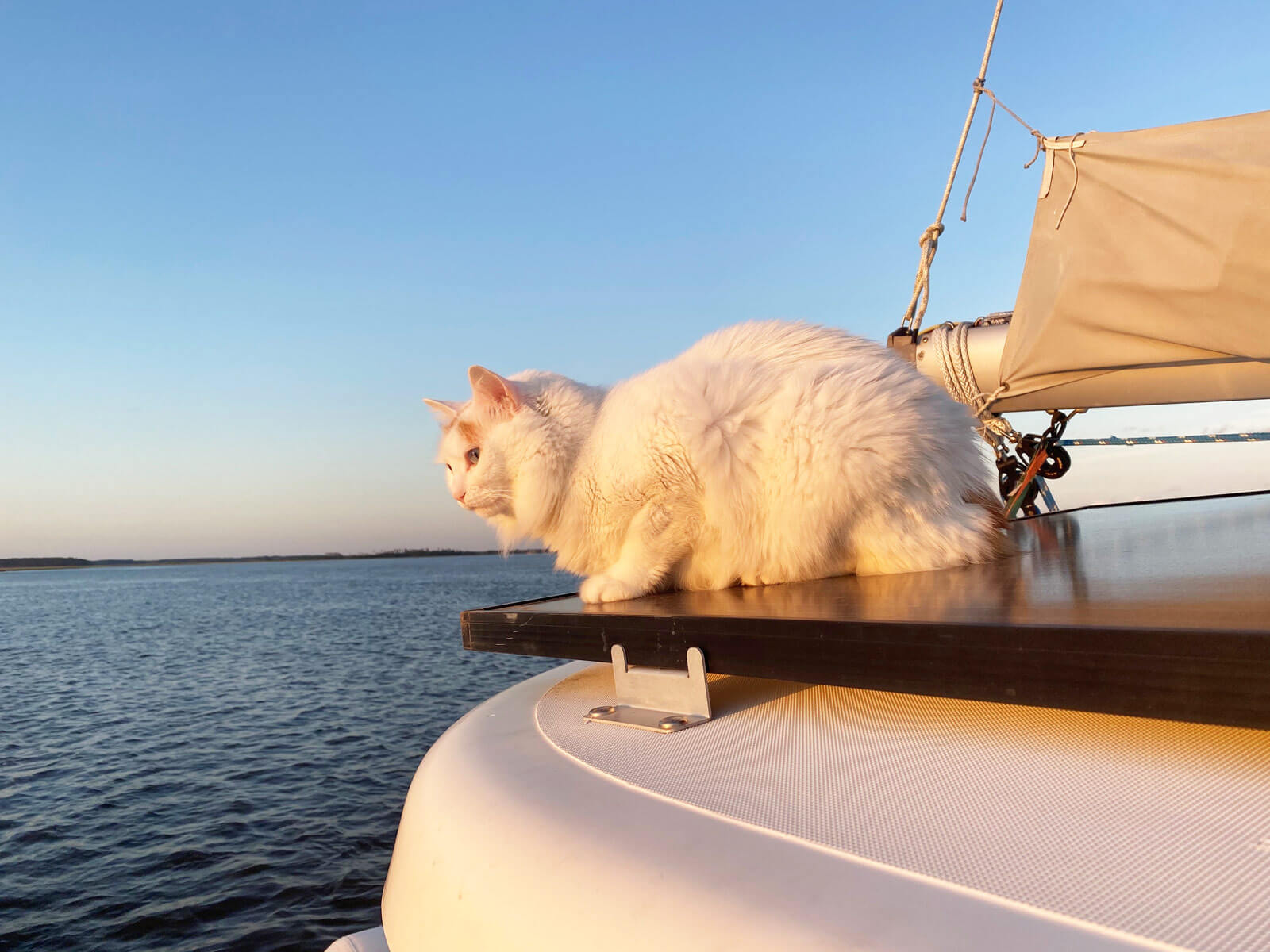
- As mentioned earlier, the Facebook group Gatos del Mar has a ton of great information about living on a boat with a cat. You can search this group for answers or ask questions.
- Instagram accounts also have great information. I love following Miss Rigby’s account on Instagram . Rigby is a boat cat that lives aboard with her owners full-time. I’ve messaged them before with sailing cat questions and they were very helpful!
- Adventurecats.org or the book Adventure Cats: Living Nine Lives to the Fullest – this organization has a lot of great info about harness training and traveling with your kitty!
READ NEXT : If you explore by land and water, you might also like the post How to Go RVing with Cats: A Complete Guide .
Final thoughts on boating with cats.
Cats are creatures of habit, but they are also very adaptable. Use the information you’ve gathered and set up a welcoming boat environment for your cat. Have patience and listen to your feline’s responses to their new home.
If you do these things, you and your cat can have some incredible experiences together on the water!
Want to learn more about what it’s like cruising on a boat?
View our guide to read more on life on a boat and what to expect living on the water.
Like this post? Save it on Pinterest for later.
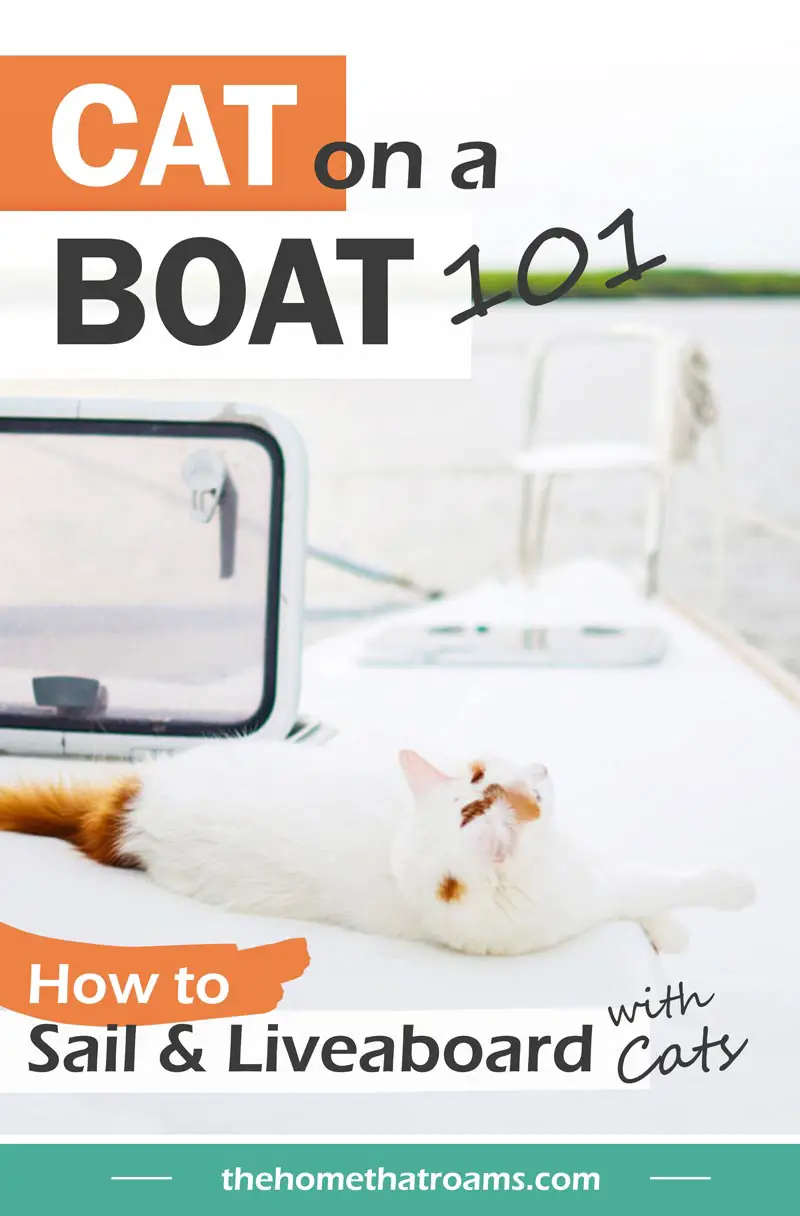
Morgan, the founder of The Home That Roams, has been living nomadically for over five years. She began her journey traveling across the U.S. in a motorhome and cruising on a liveaboard sailing catamaran. Currently, she lives full-time in a travel trailer, sharing resources on RV living and boat life to help others downsize their lives and thrive in an alternative lifestyle.
Love this site!
Thanks so much! Glad you are finding it helpful.
Leave a Reply Cancel reply
Your email address will not be published. Required fields are marked *
Sign Me Up!
Learn how to live on a boat.
Get weekly tips on how to start traveling full-time on a boat.
View our privacy policy .
Privacy Overview

- Cat Behavior
- Health & Care
Cats on Sailboats: How Safe Is It? Considerations & Safety Tips
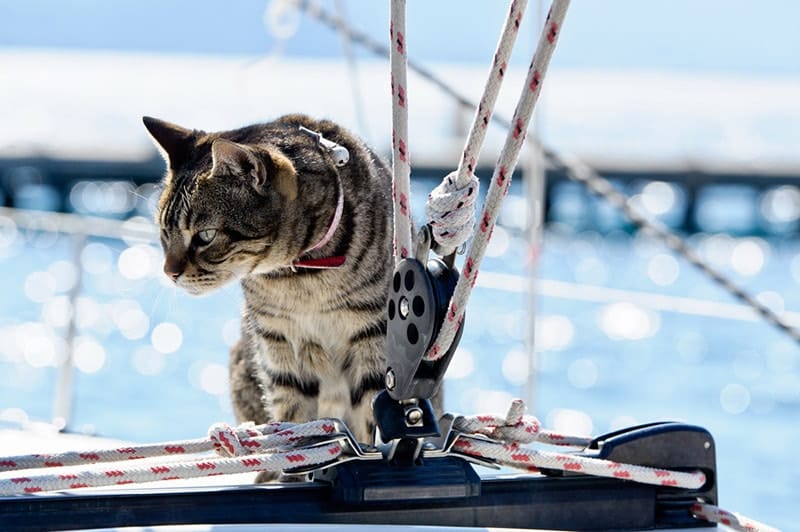
Image Credit: Nikiforov Alexander, Shutterstock
Last Updated on January 24, 2024 by Catster Editorial Team
Some people really like to push the envelope when it comes to their cats. The increasing number of people who are training their cats to wear a harness and walk on a leash have managed to prove that many cats can do well in unusual situations, as long as they are set up for success before entering that situation.
But what about training them for a life (or a few days at least) at sea? It’s not a secret that most cats don’t like water, but some people want to take their cats on sailing trips. Is this safe or practical?

- Is Sailing With Cats Safe?
Sailing with your cat can be safe, but it’s imperative that you take some big precautions to keep your cat safe and in the boat. The best starting point is starting with a cat breed that is known to commonly like water, like Bengals, Turkish Vans, and Maine Coons. Keep in mind that each cat is an individual, so you may still end up with a water-averse cat, even in a notoriously water-loving breed .

- What to Know Beforehand
There are multiple steps that you should take before your cat should even set foot on a sailboat, like verifying the rules of the marina or areas you’ll be traveling to and training your cat to wear a harness and leash , collar with a tag, and a lifejacket made for a cat.
If you’re planning to take your cat on your liveaboard sailboat, it’s extra important to verify rules and regulations because many marinas don’t allow pets at all or only allow dogs. Your cat should also be fully vaccinated and cleared by a vet before they go on your sailboat.
Other parts of keeping your cat safe on a sailboat involve getting your cat used to the boat itself, as well as the sights, sounds, and smells your cat is likely to encounter on your boat. Your cat should also be familiar with embarking and disembarking protocols. If your cat will be entering and exiting the boat in a carrier, they’ll need to be comfortable with the carrier. If you’re planning on walking your cat on a leash off and on the boat, they should be fully comfortable with this and should always be kept from having the opportunity to jump into the water or escape on the dock.

- Why Is Sailing With Cats a Trend?
A large portion of people who take their cat on a sailboat also live on that boat. There are a lot of reasons that someone might choose to live on a sailboat, from a love of the water to differing living expenses compared to purchasing a home. Many people enjoy the companionship of a pet, and people who live full-time on a sailboat may be more prone to loneliness than the average person, especially if they spend periods of time at sea.
Cats are considered by many animal-loving sailors to be a great option for a sailing companion. Cats are compact, often more so than dogs, so they’re a good size for the limited living space available on a sailboat. They also often require less exercise every day, at least not in the same way that many dogs require exercise.
Cats often can get their excess energy out through activities like scratching, climbing, and hunting, all of which are activities that can be tweaked to be done on a sailboat safely. Don’t release mice on your boat or anything, but playing with toys often mimics hunting for cats, appeasing their instincts.
Cats also have less waste than dogs and are more likely to quickly learn to use a litter box . Dogs can be trained to use a box or a pad, but it isn’t instinctual for them and may take time to train. Just keep in mind that any pet waste regulations in the area will still apply to waste from your cat’s litter box.
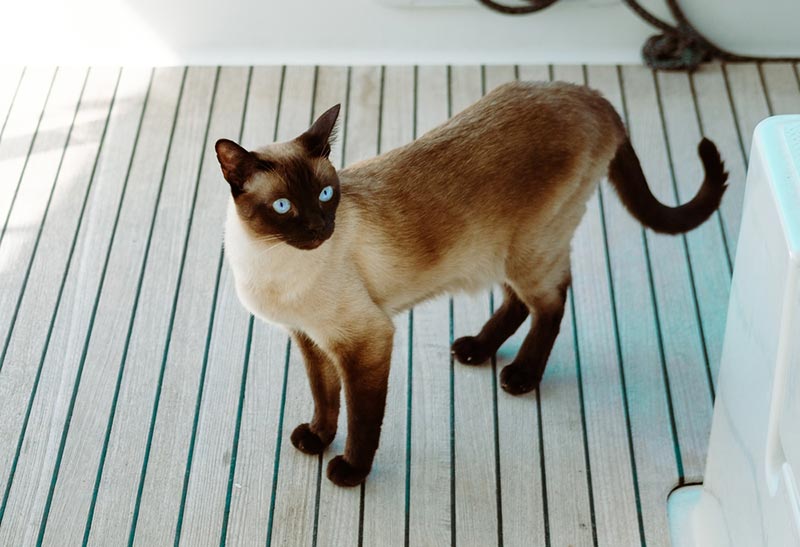
- In Conclusion
Assuming people continue to live on sailboats, then it’s very likely that the trend of having cats on sailboats is here to stay. People are looking for more ways to enrich their cats’ lives by taking them on adventures, and there are few things more adventurous than going sailing, especially for a cat.
Don’t expect to wake up tomorrow and have a cat that’s willing to be your sailing companion, however. It may take time; however, you never want to force your cat to do things they do not want to do.
- See Also: Can a Cat Ride on a Motorcycle Safely? Facts & Tips
- Cats On Liveaboard Sailboats – A Complete Guide | Life of Sailing
- A guide to boating with cats – Adventure Cats
Featured Image Credit: Nikiforov Alexander, Shutterstock
About the Author
Crystal Uys
Crystal is a passionate cat mom to Ivy. She loves to learn and share her knowledge about all things feline with people around the planet.

10 Pet-Friendly Hotels in St. George, Utah (2024 Update)

Does Health Monitoring Cat Litter Work? Vet Reviewed Facts & FAQ
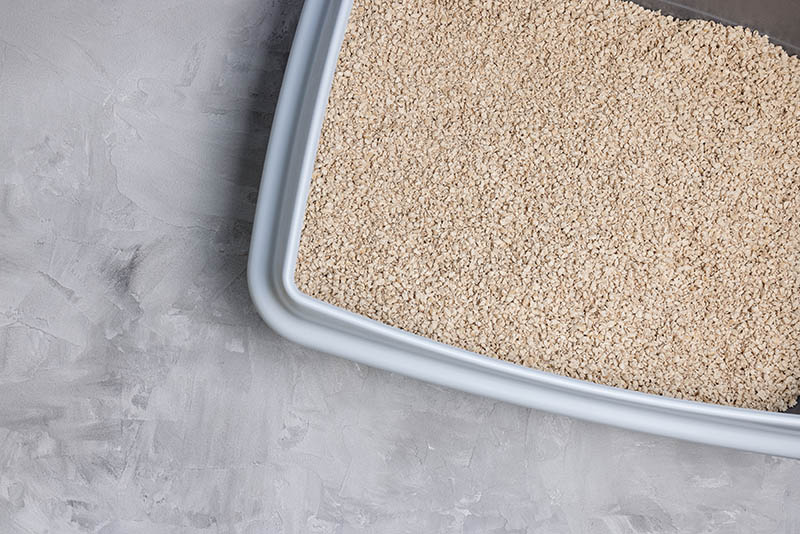
Can You Use Kitty Litter for Oil Spills? Alternative Uses, Tips & Tricks
Get catster in your inbox.

It’s Hip to Be Square: A Brief Look at Cats & Boxes of All Kinds

Does Your Cat Like to Ride on Your Shoulders? Olga’s Reluctance

What Is Apoquel for Cats Used For? Our Vet Explains
© pangolia pte. ltd. all rights reserved..


Sailing With A Cat Onboard – Complete Guide
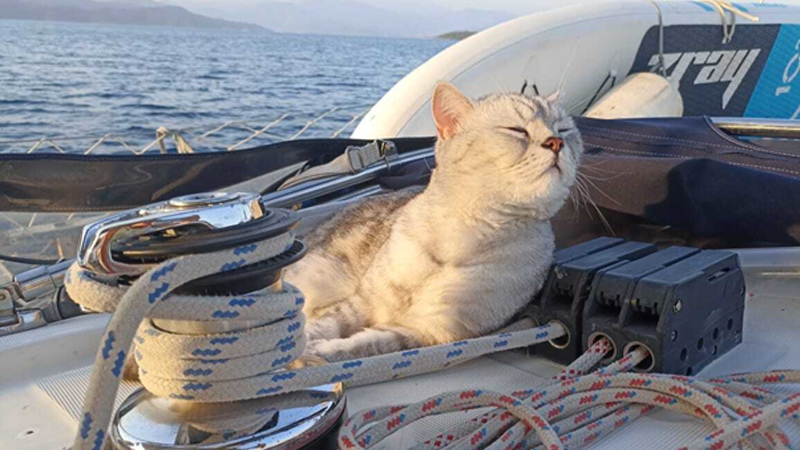
Everything you need to know to sail with a cat and help your furry feline safely and comfortably adapt to life on a sailboat
Cats are one of the most adorable and affectionate pets to have as a companion at home. Well, that may vary from one cat to another. But once you get attached to a cat, there is no turning back!
It follows you everywhere you go, even when you go sailing during the weekend. Most people feel it is dangerous to take a cat sailing on a boat, but if you set the right conditions for the cat, it is pretty comfortable having one onboard.
Getting to sail the waters with your beloved cat is what most cat lovers dream of doing. They can live safely and comfortably on sailboats if you ensure all safety measures are taken. What are the measures? Together with Zeboats , the leader in online used boat sales, we have make ready for you the main.
Can Cats Adapt To Life On Sailboats?
Cats can easily adapt to life on sailboats and do not require much attention regarding exercise. Cats do not need much space to lead a healthy life. They offer excellent company, especially if you are sailing alone.
The cat can be a source of emotional support when you sometimes feel under the weather. Humans have kept them on ships and boats for decades, but there are specific obligations you need to meet to keep one on your boat.
Here are some essential safety measures you should take care of before inviting your furry friend onboard.
Safety Measures For Cats On Sailboats
It would be a stupid mistake to make if something untoward were to happen to your cat because you did not invest your time in thinking about your cat’s safety on a boat.
Taking care of the small details can make all the difference in determining your cat’s safety.
Purchase a Life Vest When you take your pet cat outside for a walk, you put the harness on them before you head out. This prevents the cat from wandering away and coming across other animals in the park.
Similarly, getting your cat a life jacket to wear on a boat is essential. It will help them stay afloat if they fall off the boat. It is unlikely to happen, but one can never take the chance with a cat’s curiosity when they see the open water.
They can go to the boat’s edge and be mesmerized, not knowing that rough turbulence can send them to the water. You can look for life jackets for cats online, and if you do not find one, you can always purchase a life jacket that people buy for puppies.
Take Your Cat Swimming Most animals can swim naturally, but cats can take some time to be comfortable in the water. Take your cat for a swim in shallow, warm waters before you transition to the boating life.
It is essential to understand your cat’s level of ability to swim, especially with a life jacket on. They need to get used to the idea of swimming with the help of the life vest since it will make them float.
While making your cat test the waters, stay within a close distance to ensure that the cat does not overexert itself and exhaust all its energy.
Install Rope Ladders There are some cats that love to swim as much as they do walking on land. If your cat is also one of those swimmers, it will serve you well to keep a rope tied into knots or a net hanging from the side of the boat.
Wooden ladders will also work fine, but they can use their sharp nails to hang on to the rope better. Whenever your cat wants to return to the boat after a soothing swim, it can latch on to the rope or net and climb back up easily.
Metal ladders should be the last option for your cat, as they can be slippery sometimes. Your priority should be setting up a rope ladder or a net, which the cat can easily scale.
Setting up a Litter Box You need to set up a litter box on the boat’s deck so the cat can go about its business whenever necessary. After defecating and peeing, cats tend to cover them up since they are very clean-oriented animals.
Ensure that you secure the litter box on some support system, so it does not shake or move around when the cat is doing its business. They cannot relieve themselves properly if the litter box keeps moving about.
The best way to ensure that the cat’s poop does not fly around and dirty the boat is to buy an enclosed box. This will help you avoid always having to clean the deck or the cabin.
What To Pack For Your Cat Before Sailing Out To Sea
There are various essentials you need to pack for your cat before sailing out on your boat. Since you cannot expect to buy provisions for your cat on the sea, you must stock up so that you do not face any issues later on.
Let us looks at some of the necessary provisions required for your cat.
Cat Feed Ensure that you pack the required quantity of cat food when you plan to go on a boating adventure with your cat. Always carry a little more than what your cat normally in case the boat breaks down temporarily.
Medication Motion sickness is common for cats or other animals when they go to the sea. It is important to carry medication for motion sickness in case your cat feels nauseous constantly.
However, the best way to relieve your cat of motion sickness is to take it to the deck to get some fresh air. That usually does the trick. If it continues for too long, consider feeding the medication or returning to land.
Carry Proper Documentation It is important to carry your cat’s passport if you are crossing international boundaries or if you are made to prove that you are the cat’s owner.
Overall, it is important to make your cat feel safe at sea; in that process, you will create a better bond that nothing can break.
Love the boat life? Check out these picks for your boating lifestyle:
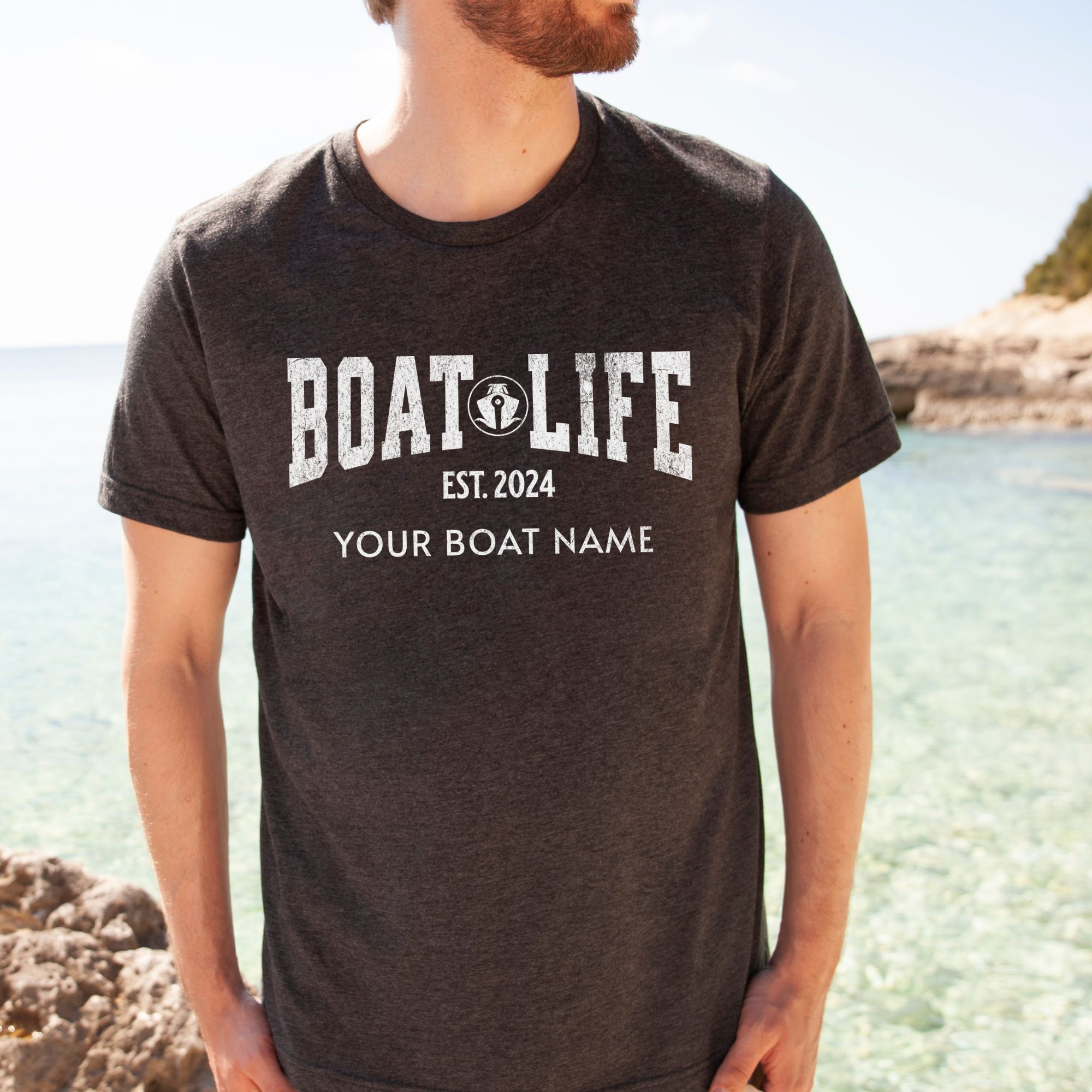
Boat Life Custom Boat Name & Est Year T-Shirt

Girl Obsessed with Boating Women’s Tank Top

Big Yacht Energy Boat Shirt

Guy Obsessed with Boating Men’s Tank Top

Editorial Staff
Related posts.

How to Exercise on a Sailboat
July 26, 2023

5 Ways Clevis Pins Are Used In Sailing Boats
September 7, 2022

Benefits of Using Solas Boat Propellers On Your Boat
April 7, 2020

Cats On A Boat: The Ultimate Guide
If you’re wondering whether it’s possible to keep your cats on a boat then you’re not alone. We’ve met many a sailor with at least one furry friend on board.
Before we got Tiny Cat, our Greek rescue kitten, we decided we would never have a cat onboard. We thought cats needed outside space to explore, and that they would hate life on a sailboat.
Tiny Cat pounced into our lives and although we did try and rehome her (thus the name Tiny Cat – we were never meant to keep her!) we couldn’t stand to give her up. She had become family. So we started searching for ways to keep cats happy on a boat. It turns out they absolutely can have great lives at sea.
But there are a few things to consider assigning yourself a new first mate. We take a look at keeping cats on a boat in this helpful guide, after having Tiny Cat on board with us for four years now.

Tiny Cat even has a book written about her. You can check out her story and buy a copy of Tiny Cat Adventures here !
Our Own Cat On A Boat

As an Amazon Associate, we earn from qualifying purchases. We also earn from other affiliate programs. This means we may receive a small commission on products purchased through our links at no extra cost to you.
We are big cat fans (who isn’t!?) but we weren’t at all sure about having cats on a boat. We thought they would miss having outside space to roam around in, that it would make travelling from country to country in our sailboat really hard and that they’d constantly be falling overboard and we’d be diving in after them!
When a two week old kitten showed up outside our boat at a Greek boat yard we did everything we could to encourage her to leave before we gave in and fed her. She was the size of the palm of my hand and looked as though she had never eaten. We decided to feed her up, make her strong and set her free. But the cat had different plans.

After many failed attempts to get her used to boatyard life and many long discussions about how impractical it would be to have a cat on a boat, our hearts won over and we threw caution to the wind, deciding to keep her.
We’d called her Tiny Cat, not wanting to give her a real name as we weren’t meant to be keeping her. And no matter how hard we tried to call her something else, Tiny Cat had just stuck. And so it was that Tiny Cat became our newest, cutest crew member and we became proud owners of a cat on a boat.
Cats On A Boat

Here are our experiences (positive and negative) about living with cats on a boat for anyone like us, who is doubtful about whether or not it can work. We’ve received so much useful advice from others, and even if we haven’t followed it for Tiny Cat we’ve shared it here in case it works for your cat.
We’ve also added the ultimate boat cat shopping list at the end so that you don’t have to trail around random foreign shops for hours trying to find the right equipment. Just order it all at once while you’re in a marina, at home, or near a post office and you can tick one of the main problems we had off your list!
Like people, cats all so different, so it might take a little trial and error at first to work out what suits your cat on a boat best! One thing we’re sure of though – you won’t regret it! Good luck – we can’t wait to hear how it all goes!
Jump To: Cats On A Boat
Keeping boat cats safe at anchor
Keeping boat cats safe underway
Your boat cat in a marina
Boat cat food
Cat litter on a boat
Boat cat claws
Toys for cats on boats
Taking your boat cat to the vet
Cats on boats and sea sickness
Checking in to new countries
Flying home with a cat
Boat cat community
Shopping list

Keeping Your Cats On A Boat Safe At Anchor
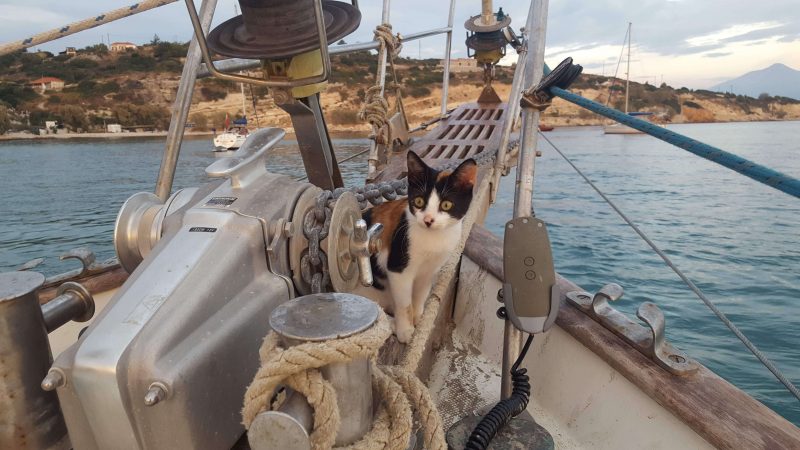
It seems that if a cat’s going to go for a swim, it will most likely happen at anchor. While the boat’s underway, Tiny Cat tends to be a little cautious and stays in the cockpit or down below.
At anchor, however, the boat is her playground and she becomes a bit of a demon! She hasbeen for a swim (accidentally) twice now, both times when she jumped into the tender to catch a fish that had jumped in there.
There are a few steps you can put in place to try and keep them safe while at anchor. Try and learn how your cat behaves on board before you decide on the right methods for you!
Teach Your Boat Cat To Swim

Most cats can swim naturally, they sort of paddle their legs and stay afloat! But not all cats like to swim.
We had grand ideas of getting Tiny Cat in the water at a young age and teaching her to swim, but one dip in the water showed us swimming was not for her. She now has a healthy fear of the water, and will peer in at a distance but is aware that the sea is not where she wants to be!
On the flip side, if you know your cat can swim then you can be more confident they’ll be able to get themselves to safety. We’ve met people whose cats regularly go for a dip and pull themselves out again.
Show Your Boat Cat How To Climb A Ladder
While at anchor, make sure you always trail something in the water for them to climb up. You can use a DIY rope ladder or something already designed for purpose. But make sure it’s weighted slightly at the bottom so it doesn’t fly away from them as they try to get a grip.
You should then test it to make sure they know it’s there and can use it. On a calm day take your cat for a swim and show them the ladder. You might want to ask a friend to take them in so they don’t hate you too much afterwards!
We did this when Tiny Cat was really small and when she did fall in the water she immediately climbed up out of the water using the ladder.
One of the times she fell in the ladder was actually in a different place (We’d temporarily moved it and it just happened to be the time she fell in!) She just swam around the boat till she found it and climbed back in. It was quite amazing to watch!
Keep an Eye On Your Sailboat Cat

We don’t let Tiny Cat onto the deck unless we’re around. That way, if she falls in then we’ll know about it and be able to help her out if she’s in trouble. If you get them a collar with a bell it’s much easier to keep track of them, but the ringing in the night drove us crazy so we abandoned that idea.
Keeping Your Boat Cat Safe When Sailing

When Tiny Cat was very small she didn’t leave our side, and certainly didn’t want to explore anything other than the safety of the cockpit. Now she’s older and more confident she loves to roam a little, and we’re starting to have to put strategies in place to keep her safe at sea.
Train Your Cats On A Boat To Wear A Harness
If you can, get your cat used to wearing a harness . While we’re sailing we can let Tiny Cat roam the cockpit on a lead so there’s no danger of an emergency COB situation!
Use A Basket To Keep Them Out Of The Way

We also keep her cat basket in a corner of the cockpit. It’s sheltered from the nip of the wind but still amongst all the action, so she often chooses this as a place to rest while we’re on passage.
If the weather starts getting at all rough, or we’re in any sort of ’emergency’ situation, we just throw her in the basket and zip it up to keep her safe and out of the way.
Lines Aren’t A Game!
The other thing you need to watch out for is cats in ropes! Tiny Cat thinks chasing the furling line is an awesome game, but we are terrified of her getting a claw stuck as it runs loose. If she’s getting too boisterous underway, into the basket she goes!
Opt For A Tiny Life Vest
It’s also possible to get life vests for cats (or small dogs), but we haven’t found one that fits Tiny Cat. If they’re tied in with a harness then hopefully they don’t need a life vest anyway!
Cats In A Marina Or Town Quay

Cats love to explore. But usually their house stays in one place. We didn’t think Tiny Cat would get off the boat without us, but once she’d worked out we were going to a neighbouring boat for drinks she somehow got out a top hatch and appeared in their cockpit!
We realised then that we would have to put a bit of work into training her if we wanted her to be safe while we were next to land.
Note: Always make sure cats are welcome at a marina before you book it. Some marinas don’t allow cats and it’s important to know beforehand so you don’t lose your deposit!
Teach Them To Come When Called
This one’s easy because cats love food. Train her to know that when you call her name and she comes, she gets something yummy. This didn’t take long to work for Tiny Cat, and it’s been a big help for finding her when she decides to play hide and seek on board as well!
Teach Cats To Only Leave The Boat With A Harness
We haven’t managed this, but a great piece of advice we got was to teach your boat cat to only leave the boat when they’re in their harness. That way you have complete control over their comings and goings!
Get Them A Collar
Because Tiny Cat is almost always on our boat we didn’t even think of getting her a collar. Then we saw a story about a sailor who found a kitty hiding in their boat, and he knew it must have an owner because of the collar, and we realised people would think Tiny Cat was a stray if they found her and wouldn’t think to search for an owner!
We bought her a fishy collar which she wears all the time now.
Talk To Your Neighbours
Adam and I are incredibly guilty of feeding random cats bits of our dinner – I think a lot of cat lovers are! But if your cat learns to go begging on other people’s boats then who knows which cubby hole they’ll choose to fall asleep in and where they’ll wake up!
If you’re staying somewhere with boat neighbors then it might be a good idea to ask that they discourage your cat from climbing aboard their boat. Not feeding them will take away any incentive. Some boat owners spray roaming cats to keep them away, but a loud shout will usually do the job!
Cat Food On A Boat

This is one of the biggest problems we’ve found with having Tiny Cat on board. She’s incredibly fussy and although we’ve tried so hard to get her eating anything she just refuses to.
Basically, food is a bit of a pain when having cats on a boat, but here are a few pieces of wisdom we’ve learnt along the way.
Cats can be incredibly fussy. We find it hard to find the food she likes best while sailing, as every supermarket sells a different brand. If your cat is as demanding as ours then stock up on their favourite food whenever you can so you always have some on board just in case.
Sensible Storage

Buy a large air-tight container like this to store any dry food. In the humidity of the boat, it goes off so quickly, and also tends to attract unwelcome visitors!
Clear Up Immediately After Cats On A Boat
Wet food is all Tiny Cat will eat, and she will not eat it all, no matter how small a portion we give her. So unless we stand over her and clear up immediately there is always a little wet food left out attracting flies and other bugs.
Use A Slip Proof Mat
Place your food and water bowls on a slip-proof mat while underway. That way, if the boat goes flying, their food hopefully won’t!
Cat Litter On A Boat

Alongside food, cat litter on a boat is a nightmare. I won’t sugarcoat it for you! Not only is it a heavy, bulky item to lug back to the boat and store but cat litter is also super absorbent and will soak up any moisture from anywhere.
As with dry cat food, you’ll want an air-tight container for your cat litter as it will attract bugs.
A litter tray is also not a small item to be lying on the floor of your already tiny sailboat. And I won’t mention the smell.
We have put a lot more time than we’d like to admit into researching the best litter trays and we’ve invested in a Breeze litter tray . It’s incredible, and worth every penny.
The Breeze system has a special grate in the bottom and a litter pad in a drawer under it. You use non-clumping litter so that the urine passes through and into the tray. Then you change the pads roughly once a week for one cat, and scoop the poop as with a normal litter tray.

The real benefits are…
- Breeze takes far less litter than a normal litter tray, so you can basically store a whole seasons worth of litter and not have to buy more as you go.
- Because the litter is solid it doesn’t absorb moisture in the same way.
- There is a lot less mess and a lot less smell! It’s also much lower maintenance than a normal litter tray.
The problems are….
- The actual Breeze brands of refills for the pads and litter aren’t the cheapest, but we have found a few hacks along the way which we’ve shared below!
- It can take cats a little time to get used to the different texture of the litter. People suggest mixing your old litter with the new for a bit until your cat gets used to it.
Instead of the Breeze pads you can use puppy pads , or even nappies (though we have to admit that the Breeze ones did hide the smell for a lot longer). Instead of the non-clumping litter you can use any non-clumping cat litter, or we even read that one lady uses dried beans! We’ll give it a go and let you know if it works!
Update: We’ve been using dried beans for years now and it works an absolute treat!
Boat Cat Claws

Unless you live in a marina, your boat cat probably isn’t getting outside as much as other cats. Without trees to climb and scratch their claws get very sharp, and unless you want tiny holes in all your clothes you’ll want to get a couple of things to help them out!
Firstly, get a scratch post for them. Something like this is perfect for cats on boats because it doesn’t take up any space at all and sticks to a range of surfaces.
Next get a pair of cat nail scissors and trim the sharp ends of their claws every now and again. This step really saved us when Tiny Cat decided that climbing us was her favourite new game to play!
Toys For Cats On A Boat
This sounds like a bit of a silly thing to consider, but if your cat is young then getting a few well chosen toys will make a big difference. When we first got Tiny Cat we were no where near a vet, so I tried making her a few toys. They weren’t very entertaining for her, so then we bought some little balls for her to chase. These were a big hit for her, but terrible for us. In such a small space it’s very hard to keep any cat toys under control!
We would recommend getting a couple of small toys that can be used in a tiny space and won’t get in the way if accidently left out. This laser pen is brilliant , and we also loved these toys on sticks as they’re easy to use in a tight companionway.
Getting Vet Care For Your Cat While Sailing

There are a surprising amount of vets in the world and it actually isn’t as hard as we expected to find them. They’re usually pretty cheap as well! That being said, on passages we do sometimes worry what we would do if something happened to Tiny Cat. We have some basics on board from the vet, but ultimately it is a little bit of a risk and one you might not want to take if your boat cat is older and more fragile.
Cats On A Boat And Seasickness

We didn’t realise that cat seasickness was a thing until we had a cat on a boat! We think Tiny Cat got quite sea sick the first few times we took her out for a sail – she went a little listless and took herself off on her own.
Cats are quite good at working out what they need so see where your cat decides to sit it out and let them get on with it. Try to make your first few sails with your liveaboard cat short ones in calm weather to get them used to the motion of the boat at sea.
Tiny Cat got used to it very quickly, but other cats don’t and for some, sea life just isn’t for them. We’ve heard you can ask your vet about medication for seasickness but we have no first hand experience of how effective this is!
Checking Your Cat Into New Countries

Cats are actually easier to check into new countries than dogs a lot of the time, because it’s much easier to quarantine cats on a boat. Every country has different laws about bringing pets into their country, so it’s important to check what these rules are before turning up.
From what people say, Australia and New Zealand are the hardest places to bring boat cats and the most expensive. There are high charges in other countries too, so make sure you check that out before sailing there.
You’ll need to make sure your boat cat has a pet passport before taking it to any new country. This can be quite expensive and take a little while so make sure you start the process asap.
Flying Your Cat Home

Again, how easy it is to fly your cat home with you depends on the country you’re flying into.
Flying within the EU is actually pretty easy. You can take your boat cat with you onto the plane and they then tuck under the seat as you fly. We have some cat calming tablets – I’m not sure if they make a difference or not but she loves them so that’s something! You can also get cat calming collars which we haven’t tried yet but get great reviews.
To get to the UK is a different process altogether! Your cat is only allowed to fly into Heathrow in the hold, and they will only accept a certain number of new animals a day. You have to book your flight, contact the airline provider and pay them around £700, they then contact Heathrow to find out if they have space for your cat that day. If they don’t you have to book a flight for another day and start the process all over again until you just happen to find a day that works.
It’s the craziest thing we’ve ever heard! I’ve done a lot of research into getting a cat into the UK and will share my findings in a different post for anyone that’s desperate!
Cats On A Boat Community
There are many, many people out there who are sailing with cats on their boat. It’s far more common that Adam and I realised. Because of this there is a wealth of advice about how best to care for a cat on a boat. The other great thing is that the boat cat community is pretty darn passionate about their cats, and everyone else’s, so they’re super helpful and will answer any questions you have quickly and in detail.
We’ve learnt the most from Facebook group communities – just search ‘cats on boats’ and you’ll find several large groups you can join.
FAQs About Keeping Cats On A Boat
How many cats can you keep on a sailboat.
I guess this is kind of up to you and how big your sailboat is, but I would try and remember that they’ll all need to use the toilet! And I can tell you now that one cat using the litter tray on board is quite enough for Adam and I! We met a couple with four cats onboard their 40ft catamaran, and the cats were perfectly happy.
The more cats you have on your boat, the more moving creatures there are to keep an eye on, so our advice is always to start with one if you don’t have any yet. That way you can get used to what it’s like with a cat to look after on your sailboat and make an informed decision about whether or not to get another. If you’re planning on bringing your cats with your from home then just make sure the boat is set up well for the number of cats you’re bringing.
What Are The Benefits Having A Boat Cat?
The main and most obvious reason to have a cat on a sailboat is companionship. If you’re an animal lover it can be hard to move onto your new home and not have your ‘creature comfort!’ with you to make it feel like a real home. Cats are an extra crew member. They make you laugh, they give you a cuddle (if you’re lucky), and they’re entertaining. Plus it’s been proven that being around animals improves your mood!
If you want a more practical reason to keep a cat on a boat, then they’re great at pest control! Cats will make sure you don’t suffer the same fate we’ve seen many cruisers have to deal with – rats and mice on board. If you’re trying to persuade a hesitant partner then try this excuse!
Should I Choose An Indoor Or Outdoor Cat For My Sailboat?
If you’re bringing an indoor cat with your from home onto your sailboat then you’re probably wondering how you’ll keep it inside the boat. Honestly, this will completely depend on so many different factors.
If you anchor out year round then it won’t be a problem. Your cat will basically be an indoor cat, especially if your cat is used to having a balcony to laze around on.
The main issue will be keeping your cat onboard if you go into marinas and on town quays regularly. If you sail in a cold climate where you’ll want to keep the windows and hatches closed year round then this won’t be too much of a problem, but if you will be sailing in warm climates then you’ll need to think it through a bit more carefully. You’ll want to keep hatches and windows open to ventilate the boat. One solution is to use mosquito hatches and window covers, but Adam and I find they still significantly stifle the breeze.
For that reason we’ve chosen to let Tiny Cat roam when we’re in marinas. The negatives to this are the fact that she can pick up ticks and fleas, and that she probably isn’t as safe. We have to pick winter marinas a little more carefully – for example we make sure they aren’t near any main roads. We also make sure we leave a ladder in the water for her in case she falls in, but there’s always a risk she’ll fall when roaming and won’t be able to get out.
For us the risks are worth the reward of seeing her so happy with her freedom during the winter months. But it’s a decision you’ll have to make based on the needs of you and your cat.
How Do I ‘Cat-Proof’ My Sailboat?
Most boats are already pretty cat proof, but there a few things you’ll want to check. Make sure they can’t get into the bilges or engine compartment. You should also check there are no open wires anywhere that they can chew through. Careful with access to cupboards that contain any dangerous chemicals and make sure everything is stowed away properly when you’re underway so nothing falls on them. Cats love to explore sailboat cupboards, so make sure they’re not trapped inside before you leave the boat!
Cats On A Boat Shopping List
Aside from plentiful supplies of your cats favourite foods there are a few things that it’s worth investing in to make your boat cats life (and yours) a little easier! I’ve put it together in this handy shopping list so you can get it all at once while you’re close to a post office or tucked up in a marina.
Purina Tidy Cats Litter Tray
Purina Tidy Cats Breeze Litter System Refills
Cat Harness
Food Storage
Slip Proof Mat
Scratch Pad
Calming Tablets
Cat Carrier
Nail Clippers
Cat Laser Toy
Calming Collar
Hopefully you’ve found some of this information about cats on boats useful, and you feel a little more confident about having your cat on board! We would love to hear your boat cat stories in the comments section below so let us know how they’re finding life aboard!

Similar Posts

The Boat Is Sinking!

The Best Shallow Draft Liveaboard Sailboat 2024

The Best Books On Sailing For Beginners

Making Your Sailboat Feel Like Home: Must Have Home Comforts

Can You Live On A Boat On Land And What’s It Really Like?

What Is A Catamaran? All Your Questions Answered 2024
- Pingback: All you need to know about boating with cats - Aw Kitty
- Pingback: The Adventures Of Tiny Cat - Two Get Lost
Thank you for sharing your experience with a boat cat!! Very helpful. We will be living aboard our 45foot Carver starting this Spring 2023. Charley our 2.5 year old cat will live with us. Charley has never used a litter box. He is a inside/outside kinda of cat. He lets us know when he needs to go out, plus he loves to hunt! People tell me “oh, he will use the box” well he has been inside for 8/9 hours and we have the box out, but nope. So this issue will be a challenge. Any suggestions?
Leave a Reply Cancel reply
Your email address will not be published. Required fields are marked *
- Search Search Hi! We’re Emily, Adam and Tiny Cat, liveaboard sailors travelling the world on our 38ft sailboat and writing about it as we go. We hope we can inspire you to live the life you’ve always dreamed, whether that’s exploring the world or living a more simple way of life in a tiny home. Find out more. Patreon
- Privacy Policy

How to Sail with a Cat (The Ultimate Guide)
By: Author The Fluffy Kitty
Posted on Last updated: February 10, 2023
Categories Cat Travel
If you’ve ever wondered how to sail with a cat, or if it’s even possible, then you’re in the right place. Because today we’re going to answer the how, what and why of sailing with your kitty!
We love taking Yoda out on all sorts of adventures .
We can show him the world and give him a “once in a 9 lives” experience, helping to build his confidence and curiosity , as well as getting to spend more time together as a family .
While cats aren’t typically known for their love of water, a trip over the waves from the comfort and safety of a sailboat can be a brilliant bonding experience for cat and pet parent alike.
Whether you are a seasoned sailor, intermediate level or something of a beginner, if you’re looking to take your feline friend out on the water this is for you.
We have a few handy tips to teach you how to sail with a cat and to ensure the safest and most fulfilling trip for you and your cat.
What can you expect from this blog? We’re glad you asked!
How to Sail with a Cat – Key Takeaways
- The essential need-to-knows about sailing with a cat . Including: clicker training your cat, acclimating your cat to being onboard, researching marina rules and regulations and more.
- What you’ll need to take with you to keep your cat calm and comfortable onboard. Such as: food and water, toys, treats, cat crates or carriers, a closed litter tray, cat life jacket and harness, a pet passport and more.
- How to keep your cat safe whilst at sea — like investing in a net, hook or installing a ladder on the side of your boat. And what to do during cooler or hotter temperatures.
- Ensure your cat is not distressed, upset or at risk . Adjust or shorten your journey if they are presenting with stress behaviors.

Sailing With a Cat – The Essentials
Training your cat for boat travel.
Before taking your cat onboard a boat, it’s important that they’ve reached a good level of training .
They should be able to recognise your voice and their own name , meaning you can call them back to safety should you run into danger.
To increase the effectiveness of your kitty’s training, you could implement clicker training for your cat. This will help to build on their skills and good behaviors, through the use of a small clicker device and positive reinforcement.
By rewarding good behaviors , your cat will learn to associate the required behavior with a positive outcome. The goal is that they will then be more inclined to maintain these good behaviors .
🐾 Check out this clicker training kit to get you started.
Keeping your cat safe on open waters
Your cat’s safety is the number one priority whilst onboard and particularly when out on open water .
We’ll cover the basic safety measures later in this article, but a good place to start is to purchase an appropriate harness and life jacket for your cat. As well as getting hold of a long net and hook that you can use to scoop your cat up, should they fall into the water.
It’s also important to ensure that your cat can swim .
Cats don’t particularly like or enjoy being in the water, but swimming is a necessary skill they must have in order to keep themselves safe if they find themselves overboard .
Here’s how to teach your cat to swim .
Don’t dive in too quickly
It’s vital to gradually acclimate your cat to onboard life .
Allow them to get used to the boat while it’s stationary . Give them the opportunity to learn the smells and sounds and new sensations that come with being in a new environment.
You want your cat to associate the boat with safety , so building up their confidence and comfort in this space is the first step to sailing with your cat.
Once you feel your cat is used to the boat environment, you might try short trips out . This will give you the opportunity to gauge how your kitty reacts and adjust accordingly.
Should this process go swimmingly (pardon the pun) you can start to lengthen journeys . Regularly take your cat out so that being onboard begins to feel like second nature to them.
In no time at all, your kitty should be setting sail with you on all sorts of wild adventures. The best first mate anyone could ask for!
Know the rules and regulations
There will be varying pet policies depending on the marina you moor in.
So when planning your journey, make sure that your stop points allow for pets . Also, make sure to research facilities for cat litter and waste disposal and appropriate drinkable water sources to refill your supplies if needed.

What You’ll Need to Go Sailing with Your Cat
Food and water.
This one goes without saying really – you gotta pack the right snacks!
Make sure you have a solid supply of food and water for both your cat and yourself. Always pack more than you think you’ll need in case of emergencies. It’s the number one way to maintain a tight and happy ship.
Your cat may have various digestive sensitivities , and boat travel is known for causing digestive disruption (hello, sea sickness!) So take a few food options for your cat to cover whatever state their tummy is in whilst at sea.
Consider investing in a sensitive stomach cat food if you know your kitty is a little more delicate.
Toys and treats
On calmer days, your cat may need a little extra stimulation . Bring a small selection of fun toys and tasty treats , to help keep your cat entertained when there isn’t much going on.
Many people find scratching boards or posts to be great cat toys to take on board.
These will keep your kitty stimulated and entertained whilst also having a calming effect.
They can also help to comfort your cat, if they’re feeling a little anxious on the journey.
Making sure your cat is comfortable in this new, and at times unpredictable, environment is another top priority as a pet parent.
Some of the best ways to provide comfort for your cat whilst sailing include:
- Setting up a cat crate or carrier. This will act as a cozy and familiar safe space that your cat can retreat to if they become anxious or overstimulated. Read more for our top recommendations on portable cat carriers .
- Taking some calming cat treats, catnip toys or pheromone sprays to help create a calmer environment for your cat onboard.
- Packing appropriate medicine and calming aids. Sailing can cause sickness and unease for both cats and humans alike. Talk to your vet before sailing with your cat to ensure you are equipped with the necessary medicine, first aid , vaccinations and treatments so that your kitty is in ship shape before setting off.
- Creating a calm space in which a cat can do their toileting business on the boat is super important. We’d suggest a closed litter tray like this one to avoid unwanted messes or discomfort for both you and your cat whilst sharing the onboard space.
Things can get chilly out at sea. And just because most cats have a layer of fur — this doesn’t mean that they won’t get cold.
Be sure to take plenty of blankets and even cat sweaters (if your cat tolerates wearing them, of course!) to keep your cat warm and snuggly on the colder days and nights.
The sea air can be particularly chilly. And on the flip side, during hotter days where the sun reflects off the water, things can heat up pretty quickly.
Be prepared for a variety of weather and temperatures when out on the water.
Harness and life jacket
Finding an appropriate harness, leash and life jacket for your cat is one of the most important requirements before taking your cat out on a boat.
The open water poses all sorts of dangers and challenges , so take every precaution to keep your cat safe . Being over-cautious may save your cat’s life, and as the saying goes — it’s better to be safe than sorry.
Don’t leave your cat unattended at any point and make sure to keep them clear from the sides of your vessel.
Pet passports and travel documentation
If you are planning a slightly longer adventure and intend to cross international waters , make sure you have appropriate travel documentation for both yourself and your cat.
There are different rules about bringing animals into other countries . This means you’ll need to research the rules of entry before you set sail, to avoid being turned away.
- What Is a Pet Passport & Does Your Cat Need One?

Cat Sailing Safety Onboard
Water safety.
As we’ve previously mentioned, it’s important to invest in
- A proper cat life jacket (complete with handles to allow for your pet to be carried or hooked out of the water)
- Cat harness (appropriately fitted, so it won’t slip off, and a bright color for greater visibility)
- Leash (made of durable, good quality material. Like this one )
These are the best precautions to take to ensure the safety and security of your cat when onboard.
Cat life jackets are slightly less popular than dog life jackets, but we would recommend checking out the following brands in XS sizes for your kitty:
- Outward Hound
- Paws Aboard
- Baltic Cat Life Jacket
For harness recommendations, take a look at our article on The 5 Best Cat Harnesses For Adventurous Felines here.
Nets, hooks and ladders
Should your cat accidentally fall overboard, you’ll need something to retrieve them.
Cats can’t hold onto rescue hoops or inflatables , and so we’d recommend purchasing a long net strong enough to scoop up your cat and bring them to safety. Something like this animal capture net .
A pole hook is also an excellent option, as you can hook onto the handles of your cat’s life jacket and harness to pull them back onboard. Make sure the pole hook is extendable and can hold a heavy weight, like this one .
It’s also a good idea to attach a ladder over the side of your boat. This gives your cat the option to grab on and climb back onboard if they are able.
Secure objects that could fall on your cat
Boats are known for rocking with the waves, and with this comes the risk of objects falling on your cat, trapping them or causing injury and distress .
Correctly secure all pieces of furniture and objects in place, to avoid at-sea accidents.
Health and hygiene
Keeping up with the hygiene of your boat, particularly when living with an animal, is paramount.
Regularly clean the space and remove hair , sanitize surfaces and correctly dispose of litter and waste. This will help to ensure both you and your fur baby remain in peak health for your journey.
Ventilation and onboard temperature control
As we’ve mentioned above, things can run very hot and cold when out at sea. Strong winds and rainstorms can make temperatures plummet , while the afternoon sun can reflect off the water and get everyone pretty hot under the collar.
Ensure your boat has appropriate ventilation for the hotter temperatures to keep your cat comfortable and reduce the health risks posed by extreme heat .
Likewise, a good supply of blankets and plenty of kitty snuggles will keep both you and your cat warm and cozy during those cooler temps.
Health warnings to look out for
It’s crucial to keep an eye on your cat throughout the journey and to adjust the route and length of the journey accordingly . Especially if it becomes evident that your cat is in distress .
If they seem out of character, present with stress responses and behaviors , become ill or start presenting with physical symptoms that increase in severity, find the nearest stop point and seek medical attention .

How to Sail With a Cat – The Conclusion
To summarize, with the proper preparation and planning, it’s possible to sail with a cat… and have fun doing so!
Here’s the key points to takeaway from this article:
- Train your cat verbally or with clicker training. This means your cat is more likely to listen to you when out traveling in new environments.
- Acclimate your cat to onboard life . Start slow and allow them to explore the stationary boat . When you’re confident that they’re happy you can build up to longer and longer journeys.
- Pack all the essentials: food, water, toys, treats, home comforts, toilet facilities, medicine and hygiene products …if you think you might need it when out on the water, pack it!
- Things can get precarious out at sea, so take all the appropriate safety measures for you and your kitty.
- Life jackets, harness and leash, nets and pole hooks and ladders are all excellent safety precautions to keep your fur baby comfortable and protected.
The bottom line is this…
As long as your cat is safe and happy to be onboard, sailing can be a beautiful bonding experience for you and your cat. It can also make for an extremely refreshing and restorative adventure .
What ways do you keep your cat happy and safe when sailing? We want to know! ⛵️
- Cat Training Game
- Clicker Training Kit
- Cat Training App
- Cat Harness
- Leather Harness
- Cat Collars
- AirTag Holders
- Cat Training Bootcamp
- Our YouTube
- Cat Breed Directory
- Cat-Friendly Places
- Adventure Cats
- Bengal Cats
- Cat Behavior
- Clicker Training Cats
- Correcting Cat Behavior
- Enriching Indoor Cats
- Talking Buttons
Cat on a Boat - Training, Gear and Tips to Sailing with a Cat

Cats are perhaps the last animal you'd imagine bringing on a boat. Because it's generally accepted that cats hate being near water.
Well, cats not only make great companions aboard a boat, but they also have been doing this for centuries!
In this article, I'll discuss the feasibility of keeping cats on boats, hygiene, dealing with the litterbox, the possibility of seasickness, safety, and some of the steps you can take to make your boat more suitable for cat companionship.
Can You Take a Cat on a Boat?
Many sailors keep pets on board because they are entertaining, efficient, caring, and loving. Of those, many of them are cats because they can be happy in smaller spaces, they have great balance and they are smaller (so you also need less space for food storage).
Keeping a cat healthy and happy on a boat can be quite simple if you remember a few basic steps. Also, not all boats will keep your cat equally happy, so we are also going to cover that later in this article.
You should be able to take your cat with you if the vessel is equipped with the necessary facilities for their comfort and protection, including enough living space, enough ventilation, a constant temperature, a secure enclosure, and a place to do their needs, aka a clean litter box.
Cats on Boats History
With the age of sailing ships, where rodents constantly threatened food stocks, cats became an indispensable part of the crew and thus spread around the globe with European travelers.
Sailors would bring cats of all fur colors along on ships to prevent mice from getting into food stores. This led to a group not particularly known for being warm and fuzzy, pirates, to develop lore about cats bringing good luck.
A cat deciding to wander onto a ship was seen as a sign that fortune was smiling upon you and the cat leaving was seen as a bad omen. Many pirate wives would keep cats around as they believed that owning a cat would ensure their husbands would return home safely.
While contemporary sailors still appreciate a fine mouser bringing them luck, they also appreciate the feline companionship of their cat commodores.
Sailing Around the World with a Cat
Spending the day sailing the water on a boat in the sunlight can be one of life's greatest pleasures. I consider my cat a family member, and in the same way, I take her with me when I travel by plane , it is only natural for me to also take her with me on sailing trips, particularly when talking about a multi-day trip as the alternative would be to leave my cat behind , with someone.
However, a few things to remember before deciding to bring cats along for the ride. You want your cat to feel secure and at home on your ship, so make sure she has everything she needs to become used to being around water.
Of all the ways I can travel with my cat , I consider sailing one of the best ones...
L isa Clark has been sailing around the world on a fiberglass boat with her cat Amelia since she adopted the abandoned kitten in November 2013.

Why are There Cats on Boats?
Ship cats have been a part of many different types of ships throughout history, including those used for business, exploration, and even warfare. There are several reasons cats have been brought aboard ships, but the most common is keeping rodents in check. Vermin on ships can damage ropes, timber, and electrical cables.
Some sailors think a cat's sharp vision might guide them to avoid a shipwreck at night.
Can Cats Liveaboard Boats?
Many live-aboard families choose cats as companions. Cats are great sailing pets, much better than dogs. Cats have a lower activity need, and many may adjust well to life aboard a vessel with less attention and special care than a dog. Cats have long been a part of ships due to their adaptability and entertaining companionship.

Living Aboard with a Cat on a Boat
As mentioned earlier, living with a cat on a boat is possible, and many cat lovers are doing it. However, here are some things to consider if you want to bring your cat with you on your boat:
I would like to separate the cat´s needs into 3 big groups:
- Food & Water
Entertainment
- Health & Hygiene
Food Aboard
Cats are not very good at drinking water, they absorb most of the hydration through food. Particularly on a sailing vessel, cats will get dehydrated food will just make matters worse.
Consider switching your cat to a wet diet when on a boat, so in case they are not very regular at drinking water, they still have a healthy hydration level in their bodies.
Regarding food, if you leave the dock, consider always packing enough food for 10-20% more days than you are going out. Things happen and you should ensure that your cat can eat throughout the trip.
While cats need less activity than dogs, they still need mental and physical stimulation.
Try to provide an environment where your cat can thrive, with enough scratching, climbing, and hiding spots. Usually, boats don't lack those, but satisfying your boat will help keep your cat healthy and your boat intact.
Health and Hygiene
See a vet before you go to ensure your cat is healthy enough to travel.
Another safety consideration is leaving your cat roaming around the boat. If the boat is underway, the cat should wear a harness or a lifejacket and attach it to a lifeline, so in case it fell on the water, it'd be easier to get back up. When not underway, those measures are still recommended, but if the cat is walking around without a harness or a floating device for cats , there should be always someone paying attention to the cat.
Do Cats Get Sea-Sick?
Just like humans or dogs, cats may become seasick. They will likely prefer some time alone, so let your cat go through the process without forcing them to do anything in particular. If they throw up, add extra liquid to their meal to avoid dehydration.
Cat symptoms of sea sickness include:
- Frequently licking their lips
- Lip smacking
- Drooling a lot
- Making sounds of pain or anguish, such as whining
- Anxiety, boredom, or a sudden lack of activity
The sea sickness medicine Dramamine is safe for cats to consume, speak with your veterinarian before administering it to your cat.

Sanitation of Sailboats with Cats on Board
Boats are usually small spaces that clutter quickly and can get dirty with ease. Luckily, they tend to be equally easy to clean.
A liveaboard cat doesn't have to mean a messy space... unless you need to fit a litterbox!
Managing the LItterbox Aboard a Sailboat
Regarding the litterbox, it's important to have a clean litterbox always available to your cat. We use flushable (biodegradable) litter so that we can dump it overboard (always according to local regulations ). We use World's Best Litter and are very happy with it!
Try using a very tall litterbox so that the litter stays inside. Top-entry litterboxes work best for sailing environments, although some sailors have built-in litterboxes into a cabinet, for extra coolness.
Do Cats Like More Sailboats or Motorboats?
Cats in general enjoy smooth rides and mild noises, which does not sound like a motorboat at all.
If you are at a point where you want to buy a boat and you want to take your cat with you and you don't know if you should get a sailboat or a motorboat, the answer is, get a sailboat. Not only because they are classier and cooler, also because of sailboats:
- Have displacement hulls that cut through the water instead of jumping waves, making them a more comfortable ride.
- They run on wind vs. engines, so you and your cat can enjoy navigating with almost zero noise.
- Sailboats have more vertical space than motorboats, giving your cat a natural playground to play on.
I Took My Bengal Cat on a Sailboat Circumnavigation Trip
Let me tell you about when our two cats and I explored Long Island with nothing but the sun and the breeze. Leaving Santos, we entered the dark hours of nighttime sailing before we knew it. The cats enjoyed exploring the boat, and after 36 hours of nonstop sailing, we arrived at Harihan, the most beautiful spot in the world, to do absolutely nothing. Coy and I became snuggly monsters and realized why we weren't ready for the storm.
To ensure our safety and the stability of the anchor during the storm, we had to go outside. To recharge our batteries, we stopped for a little rest. Coy and I went for a stroll on the beach on day four after deciding to take a day trip there. The approaching storm made us think it was time to go back so we could adjust the sails.
On the fifth day, we were all pretty tired, so we took turns being captains, and the cats chose a rocky place to live. Before we knew it, another beautiful sunset and day had come and gone.
The storm finally arrived when we thought it would never come. After arriving back in New York, everyone on the crew agreed on one thing: we needed a holiday from our holiday.
Prepare Boat for Sailing With a Cat
One of the most important things to do before setting sail with your cat is to prepare the boat. The process includes ensuring your sailboat is secure for cats by "cat-proofing" it.
How do You Cat Proof a Boat?
Before bringing a cat on board, you must take steps to cat-proof your sailboat. You should "cat-proof" your boat by getting rid of or blocking your cat's access to any places that could be dangerous.
Be careful first to close up any holes leading to the bilge. Most sailboat bilges are damp, unclean, and cramped, which creates problems.
Cats are known to eat and damage electrical panels and wires, so it is important to secure them.
Your cat will be fine there if you keep the rest of the boat open, safe and accessible. Protect cabinets shut, and consider installing netting over deep cubbies to keep your cat from becoming tangled or stuck behind a panel or bulkhead.
Keeping a Cat Safe While Sailing
Cat safety on a sailboat is simple. Temperature, water, and the natural environment are the most important problems. Here, we'll discuss some of the special considerations that must be made for your pet when living aboard a sailboat.
- Teach your cat to swim. You want to make sure it can swim if it falls overboard.
- Cat life jackets : Using a specific cat life jacket is an excellent start. In an emergency, these lifejackets would also come in handy.
- Leashes and harnesses allow your cat to enjoy the sailing deck safely. A leash is often fastened to the railing or the stay wire on liveaboards. Your cat will have twice as much room to roam when they are on a leash and harness.
- Climate and Temperature: The same temperature rules apply to sailboats and cars. The boat should never become too hot, especially if you have a cat. Maintain comfortable temperatures within the ship by turning on the heat and air conditioning.
Conclusions on Boating With Cats
Sailing with cats gives company at sea, bonding possibilities, and many chances for images of beautiful adventure cats enjoying the yacht life. Having a cat aboard your boat can put the wind in your sails.
Stay Wild, Stay Safe, We'll See You Outdoors!
Albert & Mia
Leave a comment
Please note, comments must be approved before they are published
This site is protected by reCAPTCHA and the Google Privacy Policy and Terms of Service apply.
Adventure Cat Articles you might Like View all

Learn how to teach your cat tricks or to go on adventures using clicker training and positive reinforcement!

Discover our favorite Amazon picks. From training your cat to keeping your home smelling fresh and taking your cat outdoors!

Follow us on Instagram for daily tips and beautiful images of Mia enjoying the outdoors!

Cats on Boats: Everything You Need to Know
Sailing cats can be great onboard companions.
Having cats on boats is a great way to bond with your four-legged buddy while still doing something you enjoy. If you are thinking about taking your cat on a boating trip, both of you will benefit from what can be a positive experience.
If your sailing cat isn’t already used to being on a boat, though, you will need to take steps to get your furry best friend to the point where they can comfortably join you.
Read on to discover how you can take your cat boating and what you will need to pack for them.
Getting Cats on Boats

Going boating with pets requires some training to get them used to being on an unfamiliar surface. Boats are not stable, so your cat may be anxious or unsure of its footing. Additionally, when you need to get off the boat, your cat may feel out of its comfort zone that you are not there.
As their trusted friend, it’s up to you to make sure of a few things before you get your cat on a boat:
- Can your cat swim? Unfortunately, accidents can happen that may result in your cat going overboard. To ensure that a small accident doesn’t turn into a bigger one, make certain your cat knows how to swim before you decide to take them onto the boat.
- Is your cat comfortable being on a boat? Cats are usually home-based pets, preferring to lounge on the couch or catch a glimpse of sun by the window. Do you think your cat would adapt comfortably to life on a boat? Would they be okay to walk around on the outside deck and in the cabin?
- Is your cat a quick learner? Don’t rush when you’re training your cat to be on a boat. Even if your furry best friend is a quick study, taking your time makes the transition from land to boat much easier.
The Potty Issue
Training your cat to do their business on board may be tricker than home since they are used to their litter box and its familiar location.
For successful potty training onboard, bring the litter box your cat uses at home – they will be used to the smell and will most likely have better success. As well, make sure you have a plan for waste disposal, especially if you intend to go on a multi-day trip.
What to Bring For Cats on Boats
Just as humans need supplies when going sailing, cats also require the same consideration.
If you want to take your cat with you, you’ll need the following things:

- Rope ladder . In the event that your feline friend tumbles off the boat, you can throw them a rope ladder to claw into and pull themselves back up onboard.
- Large net. This may also help rescue your cat out of the water if they go overboard.
- ID tag. An ID tag should have your phone number and address on it in case your cat gets lost during the trip.
- Food and water bowls. A water bowl is always necessary, especially during hot days, but a food bowl may also be necessary if you are going out for longer than a few hours.
- Food. Like the humans on the boat, your pet will need a supply of food big enough to last the whole trip. Keep extra dry cat food onboard in case of emergencies.
- Fresh water. It’s important to bring a supply of fresh water for your cat since drinking from other sources may make them sick.
- Sunscreen. If your cat has very short hair or bald areas – such as the area around their nose – they may require sunblock to avoid getting sunburned.
- Rug or mat. Boat surfaces can get hot in the summer. A rug or a mat offers your cat a safe and comfortable place to lie down.
How to Keep Your Sailing Cat Safe
Safety needs to be considered when having cats on boats. Among the other safety equipment and supplies you pack for a boating trip, you should include some basic medical and safety supplies for your cat too, such as:
- Life vest. Even if your cat knows how to swim, a lifejacket is still needed to ensure their safety.
- Overboard plan. Just like you have an overboard rescue plan for humans, you will also need one for your cat. This may include training your cat to respond to a specific set of commands and getting them used to wearing a lifejacket.
- Fishhooks and bait. If you plan to go fishing , make sure your hooks and bait are safely stowed so that your cat doesn’t get hurt.
- Seasickness medication. Cats can get seasick, too. Fortunately, they can usually take the same seasick medicine that humans take for this problem. If you want to be certain, however, ask your veterinarian before heading out on the boat.
- First aid kit. Pet first aid kits are available at most pet stores, and they include items that are specific to animals – unlike human first aid kits. If your cat is on any medication, be sure to also include that in the kit, where it will be safe.
- Shade . Like humans, cats can be susceptible to heat stroke or heat exhaustion. Ensure there is somewhere shady they can rest in extreme heat.
Finding Pet-Friendly Marinas

Although most marinas are pet-friendly, not all are, so ensure you check ahead if you’re planning to dock at different marinas during your trip. You should also familiarize yourself with their rules concerning pets. It’s simple to plan your marina stops using the internet, since most marinas will have a website that may include information about their pet policies.
At Van Isle Marina, we love pets. We understand that the boating lifestyle can mean taking your beloved animal onboard to share in your memories.
Whether you’re looking for a permanent base or a stopover for one night, your four-legged friend is welcome at our Sidney, BC marina. Contact us today for more information about our moorage rates.
Blog Headlines
- What is a Yacht? (History, Types of Yachts, Styles and Sizes) January 15, 2024 - 10:35 am
- Essential Off-Season Haul-Out Services for Your Boat August 10, 2023 - 4:34 pm
Media and Galleries
Click HERE for more videos and photo galleries including our Historic Galleries .
Click HERE for a photo tour of our marina.

- Destinations
- Navily news
- Recrutement
- Captain’s advice
- Environment
- Your stories
- Download Navily

Sailing with a cat on board
Cats have a reputation for hating water. But what do they really think about it? Is sailing with a cat that complicated? What if this water was full of fish for your furry friend’s next meal! From the safety of a boat deck, cats are in fact truly reliable sailing companions.
Take Jessie, the adventurous feline who has been sailing with her human Lyn since she was adopted as a kitten. We had the chance to interview Lyn about her experience on the topic of sailing with a cat. How does she ensure smooth sailing with her furry skipper on board? Keep reading for some tips and tricks from our own in-house expert! Who knows, maybe next time your beloved Whiskers will join you as well!
You can follow Jessie’s journey on her Instagram account @jessie_the_sailing_cat
Want to sail with your dog instead? Here is Thais, Beto and Google’s story on bringing your dog on board .
Sailing with Jessie: The interview
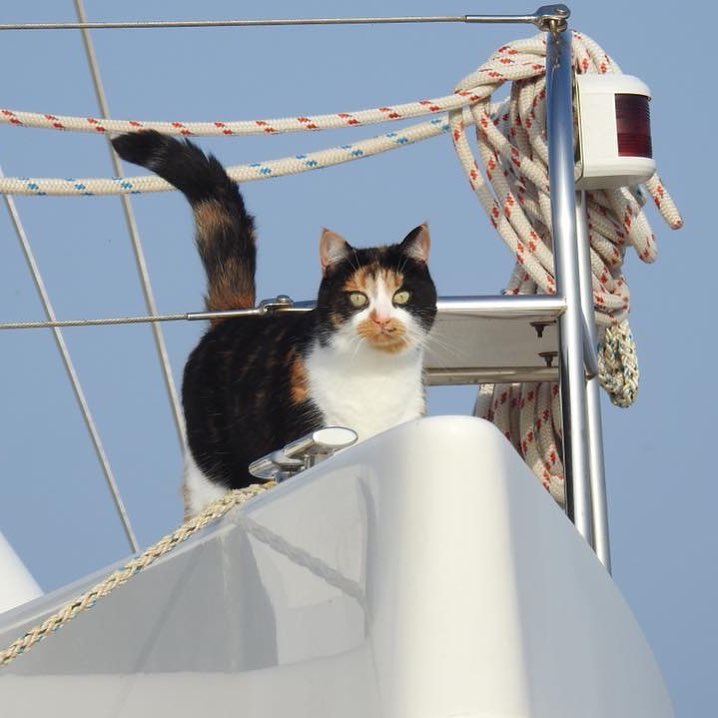
How long have you been travelling with Jessie?
“We have had Jessie since she was 8 weeks old and she has always been a ‘boat cat’. For the first 6 months we cruised on the inland waterways of England in our Princess 32 river cruiser. Following this, we had a Sealine 365 Flybridge cruiser for coastal cruising on the East Coast of the UK. Jessie always came with us.
In 2017 we became full time liveaboards on our Broadblue 385 sailing catamaran and of course took Jessie with us. We left the UK in July 2017 and have sailed almost 4,000 nautical miles with Jessie throughout the Mediterranean. So Jessie has been on boats since she was 8 weeks and we’ve been sailing with a cat for almost 7 years!”

Did you have any hesitations when you decided to bring her on board?
“We didn’t really have any fears about bringing Jessie on board as she had experience with us on our previous boats. Our main worry is her falling overboard, but she is very good and knows how to stay safe. She does have a life jacket, but she is not entirely comfortable wearing it as it is quite restrictive. Whilst we are underway, she is always safely tucked inside the bedroom.
However, when we are at anchor, her favourite time of the day is just after the sun has set, when she likes to wander around the deck. To allay our concerns about her falling overboard, we have a Safety Turtle . It attaches to her collar and sets off an alarm when it is submerged in water. However, having lived on board the catamaran for 3 years now, Jessie knows her ‘safe’ routes around the boat and onto the different roof levels and is really careful. We are extremely vigilant and either stay with her or check on her regularly.
In addition to this, we do have other safety systems in place. Inside the boat, her basket is fastened securely so that it does not fall or move when the seas are rough, giving her absolute security.”

Was there a transition period? How did you manage it?
“No, we didn’t have an adaptation period really. When we moved on board the catamaran full time, we all moved on board at the same time! Jessie loved it immediately. She has a 360º view of her surroundings and we are always moving to different places. This keeps her from becoming bored! She loves to sit and watch the birds and the fish jumping alongside the boat.
Jessie also loves that we are with her all the time now, rather than going out to work and leaving her at home alone. She has her own routines and gets upset if they are disrupted!”
What essentials do you recommend to someone who is considering bringing their cat onboard?
“We have the basics such as her litter tray, a plentiful supply of wet and dry food and her favourite toys, cushions and blankets. In addition, we have a special water filtration bowl for her that is powered by 12v (USB). We also have a separate veterinary first aid kit for her, including ear drops, eye drops and special swabs for minor wounds.”
Do you have favorite brands for Jessie’s supplies?
“We find that we can get good quality Purina food products in most countries and try to keep a variety on board at all times. Our water bowl is from Cat It . It is excellent because of its low power consumption and ability to run off 12v.”
Are there any issues with customs when sailing with a cat?
“So far our main cruising has been within the EU so we have had no major issues with customs. However, we did experience some challenges when entering Guernsey in the Channel Islands. This was because we had visited France before entering Guernsey, where they are very strict on rabies control. We had to complete a customs form before entering the country and they advised us that we would not be able to dock in a marina.
However, we had problems with our windlass which meant we were unable to anchor. We were therefore permitted into the marina on the condition that we did not allow Jessie off the boat. This wasn’t a problem as she doesn’t routinely leave the boat anyway. But the customs officials were extremely vigilant and visited us regularly throughout our 3 day stay. One even advised us that Jessie was not allowed to be visible on deck and should be kept locked below at all times, otherwise they may take her away and quarantine her. We resolved this by leaving!”

Any pro tips for dealing with the dreaded litter box?
“We have tried a variety of litter boxes and litters and learned through observation of our cat’s behaviour and the general impact on the surroundings. This led us to design our own solution that has now been tried-and-tested over a period of 8 months and that has proved very successful.
Our bespoke system eliminates smells, reduces litter consumption and contamination and most importantly has earned approval from our discerning Jessie. Basically, we use a silica type cat litter on a “run through“ arrangement with two stacked trays. This way solids are removed and disposed of as they occur. The starboard hull of our catamaran has a workshop at the bow. We keep the litter tray on the floor wedged to prevent movement.
If we are on passage, going to the litter tray can be a bit daunting for Jessie. However, she does let us know when she wants to go and we give the necessary support. Sometimes that support is just moral. Other times, physical support in the form of a firm hand either side of her to stop her swaying is needed. No smells, no mess, cheap to run and a happy cat.”
We’re dying to know, can cats get seasick?
“Jessie has always been an indoor cat, so she has had no contact with other animals and has always been very healthy. She has never displayed any signs of seasickness. She gets plenty of fresh air and, although we drink desalinated water from the water maker, we ensure that Jessie always has bottled spring water to drink. Finally, She also has plenty of space to move around and loves to have a play ‘fight’ every evening to keep her hunting skills honed!”

Do you recommend special visits to the vet for a cat on board?
“We make sure all vaccinations and medications are in place prior to leaving, including a full health check. If you’re sailing with a cat, in each harbor you visit, you should always know where the nearest vet is located.”
What’s your favorite Jessie story?
“We do spend a large portion of our cruising life at anchor, so it is rare for us to go into a marina. However, once when we were in a marina, a boat docked beside us with 3 cats on board! All of a sudden, we heard a lot of commotion on our deck and rushed to investigate. We realized that we had other cat visitors on board and Jessie was busy herding them off ‘her’ boat!”

Any last anecdotes you’d like to share?
“When we had our flybridge cruiser, there was an occasion where Jessie was extremely insistent to get our attention. She made lots of fuss, trying to get us to follow her. Eventually, her Dad followed her up onto the fly bridge where she showed him that there had been some water ingress!
Also, she is very attuned to the wind. Her ‘benchmark’ seems to be 15 knots of wind. Anything above this and she will retreat to her basket in the bedroom. The minute the wind drops below 15 knots, she immediately joins us in the saloon. We don’t even have to look at the wind instruments as her assessment is so accurate… Sailing with a cat really has many benefits!”

Partager :
- Click to share on Twitter (Opens in new window)
- Click to share on Facebook (Opens in new window)
You might also like

Leave A Reply
Leave a reply cancel reply.
This site uses Akismet to reduce spam. Learn how your comment data is processed .
The Logbook & Navily
Navily, what is it? A community coastal guide for sea lovers 💙
⚓️ Find and share the best mooring spots.
⚓️ Book your berth in one of our 700 partner ports around the world.
So, are you on board?
The Logbook is the Navily blog: an influx of exclusive content on different topics. Accounts, tips and other surprises… ⛵️
Derniers articles
- The best anchorages in the Azores
- Safetics: Road and Sea Safety, a Similar Fight
- Ilha do Fogo : A marine sanctuary beckoning boaters in Mozambique
- Tentaclaus’ Christmas Tales
- Christmas Magic in Sanary-sur-Mer
Popular Posts

- Captain's advice
- Navily life
- Our marinas
Discover more from Navily The Logbook
Subscribe now to keep reading and get access to the full archive.
Type your email…
Continue reading

Living aboard a narrowboat with a cat
You might have seen from our logbook entry for April 2019 that we have welcomed a cat aboard our narrowboat and are living with our very own ship’s cat. Since we spoke about our cat Tebay we’ve received plenty of messages on Instagram and emails questioning the wisdom of having a cat on a floating home surrounded by water, worried for the safety and happiness of a cat in that situation, well we’re here to tell you that not only can it be a safe place it can also be an excellent home for your cat and an exciting, enriched and happy life for them to lead. In this article we’ll discuss how we prepared the boat for our newest arrival, how we integrated him to boat life over the first 4 weeks and how we continue living aboard a narrowboat with a cat harmoniously.

Preparing your narrowboat for a cat
We’re going to try and keep preparations here as simple and to a minimum so that we cover the essentials you will need to do in order for your cat to have everything they need to survive and thrive aboard your narrowboat. Don’t let this list of preparations stop you for any additional ideas you have for your cat, after all we all know we want to spoil them with toys and treats!
Litter tray
Fill a litter tray with 2 inches of unscented cat litter. You’re going to need somewhere for your cat to do its business unless you plan on having an actual poop deck and so a litter tray is essential and not only for that reason. Litter trays form the centre of a cats territory as it is a big box that smells like your cat and so making sure you have this set up and especially that you don’t use scented litter will help your cat to not only have a facility they need but will help them to understand your boat as its safe territory.
Food and Water

Set up a feeding station with two bowls, one for food and one for water. Like any creature a cat will need food and water, we won’t tell you what types to buy and how much to spend as this is really up to you but what we will say is that you should have your two bowls set up in a prominent but safe place, located away from the litter tray, after all you wouldn’t like to s**t where you eat and neither would your cat.
Scratching post
Add a scratching post to your boat. Cat’s claws need to be worn down regularly and we’re guessing you won’t want that to be on your sofa or curtains and that’s why we recommend a scratching post for your narrowboat. These come in all kinds of shapes and sizes and which one you get really depends on how much room you have available. The best one we found was this wall mounted post which is fantastic for narrowboat living as it screws straight into the wall of the narrowboat, sits perfectly under the gunwales and takes up no floor space which anyone who lives on a narrowboat knows is at a premium.
Ensure your boat is safe
Add an escape route for your cat. Although you will want to keep your cat inside the boat for at least the first 4 weeks to enable them to realise your narrowboat is their home now there is always a chance they will escape and find themselves in the canal, it’s simply a hazard of cats on the cut. And while cats are good swimmers they struggle to get out of the canal due to the high sides and boats with nothing to get purchase on to get back out again. We simply added an old bit of carpet to the outside of our mooring so that should Tebay fall in (which he has done many times) he can at least climb out back to safety using the carpet (which he has also done thankfully)
Catify your narrowboat

Add hiding places and viewing places for your cat. Look at your narrowboat through the eyes of a territorial cat and you will soon realise that you might need to make some additions to your interior to help your cat feel safe and at home. Consider adding ledges or vantage points for your cat to be able to climb to to survey their territory or adding places for them to be able to hide. For us we cleared a space for Tebay to be able to sit on our cupboard and see out of the front window, we added a hammock attached to the window so he can sit above us all and keep an eye on us and then bought a pop up tunnel so he can slink about unseen by us. These three simple changes mean he feels in control of his boat and we can also clear them away if we need to make room for other activities such as playing!
First day on the narrowboat
How exciting, they day has arrived for your cat to come to your narrowboat, you’ve followed the above steps to prepare and now you’re eagerly awaiting their arrival. Unfortunately it’s not as simple as opening your doors and letting your cat in as you’re most likely going to be getting a nervous and slightly disorientated cat into the boat and so here are some tips to make the first day on the narrowboat a stress free and successful day for both you and your new cat.
Set up a safe space
When you’re bringing a cat into a house it is much easier to set up a quiet and warm room for your cat with everything it needs so that it can feel safe and start setting up it’s new territory, however you may not have this luxury on a narrowboat, I know we didn’t. Tebay arrived to us in the morning and we had decided that we would avoid the bedroom at the stern of the boat until it was time for our bedtime. Although there was no door to close it still gave our cat a space where he knew he could go to if he felt scared where we wouldn’t be. We had some food and water back there and avoided disturbing him in there as much as we could despite wanting to be around him as much as we did!
Let them come to you
It is so tempting when you get a new cat to stroke and play with them, follow them around and try to coral them into doing things however especially on the first day you will want to give them plenty of space and let them come to you rather than chasing them around. When they arrive in their pet carrier sit on the floor and open it up, let them take their time to come out and sniff you and the area and don’t be upset if they run away and hide from you, they will come round in time.
Temper your expectations

Day one will be a strange and stressful day for your cat so don’t be surprised if they don’t eat as much as you would have hoped or if they hide from you all of the time, this kind of thing can last for a few days, a week or even a month depending on the cat and is all totally normal. Don’t expect everything to be all go right from the off! We were very lucky that Tebay is the most inquisitive and also affectionate cat we have seen and so within an hour he was already marking us as part of the family and was jumping all over us playing in his new home.
The first few weeks
Congratulations to both you and your cat in surviving your first day together on the narrowboat however integration continues for the next few weeks. As we have said it might take your cat a few weeks to really settle in so be patient. Here are some things to consider in the following weeks.
Keep your cat indoors

It’s vital that you don’t let your cat out and about for at least the first few weeks (for us we waited a full month). This is to be sure that they have had a chance to establish the narrowboat as their territory and for them to realise that they live there now. If you let them out too soon you may find that they simply don’t come back because they don’t see the narrowboat as their home yet so it’s always better to play it safe. We kept Tebay in the boat for the first 4 weeks despite his meowing to be let out to explore, by that point he had explored every inch of the boat, sniffed every surface and smeared his scent over everything including us and so he was comfortable that he was at home now.
Introduce play time

Introduce play time – Play time plays a key role in the happiness of your new cat especially if they are being kept in a small boat for the first 4 weeks. Playing with a cat serves a number of purposes, it helps them scratch their hunting itch which is one way to calm down a cat who might be a little bit violent, it tires them out which helps them to sleep through the night and it strengthens the bond between you and the cat through play. We have a variety of toys including this feather wand which Tebay loves to pounce on, balls for him to play by himself when we are out and a laser pointer for him to chase endlessly once he’s tired us out of swinging the wand all evening.
Slowly allow your cat to explore

After you have kept your cat for a few weeks and you are ready to start letting your cat out you need to remember that it is a big and scary world out there and so you want to make its first forays into the nearby world calm and stress free. Try to keep the interaction with other people and pets to a minimum the first few times they go out and give them time to expand their territory without being startled too much and taking a step back. Slowly you will notice the circle you cat explores grow and grow as they become more confident. For us this was a scary prospect, Tebay is under a year old and is very inquisitive so we were worried about him getting too excited and losing his way home. He hasn’t yet and always likes to know we’re nearby, whether that’s running back to the boat to make sure it’s still there or popping his head up from the bushes to make sure me or Olivia are still within sight. He seems fine but it still worries us so we invested in a cat tracking device which sits on his collar, we got a Tabcat tracker which is extremely light so it doesn’t encumber him and allows us to be able to locate him when he decides to hide in the bushes. It’s been a great buy because it gives us piece of mind even if we haven’t had to use it yet!
Enjoy your time together

One sure fire way to make sure you’re cat has a happy life in these first few weeks and even beyond is to make sure you enjoy your time together, yes cats have a mind of their own and can do some frustrating things at 3am but you have to remember that they feel the same about some of our habits! Once you get into a routine with them you will find them great company and they will feel the same, soon you will find yourself one of the cat family and they will show you their affection, whether that’s through slow blinks at you, chatting to you through meows, sleeping with/on you or even licking and grooming you.
Here’s what we bought…
To try and help we put together an Amazon list of the gear we bought to help make Tebay an adventure cat. Click the photo below or head over to https://www.amazon.co.uk/shop/theserollinghills
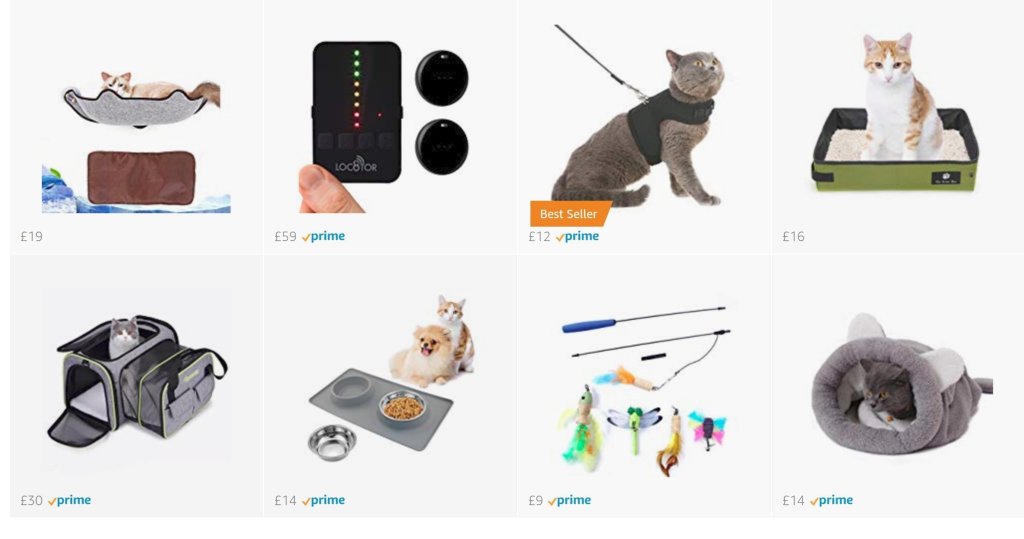
You may also like

Narrowboats: Obvious things you need to be told
Some things are so obvious that they need no explanation. Other things are so obvious that people THINK they need no explanation […]

How to have a cinema on a narrowboat
We love nothing more than getting cosy and enjoying a night in with Netflix and a bowl of popcorn and so we […]

How to get FREE Wifi on a narrowboat
So you know how to get internet onto your narrowboat thanks to our article “How to get internet on a narrowboat” which […]

The true cost of buying a narrowboat
Boy do narrowboats cost more than you think, I guess that’s why BOAT stands for Bung On Another Thousand, I just wish […]
- Mews & Info

- JessiCat Etsy Accessorati Store
- CaM Amazon Reco
- Friends of CaM Animal Rescue

A Guide to Sailing with Your Cat
Sharing is caring!
When your cat loves being by your side, you want to take your beloved pet with you everywhere you go. Taking your cat out on the open water might seem risky, but with careful preparation, your kitty can even accompany you on your summertime adventures. Use this guide to sailing with your cat to ensure a safe trip.
Don’t Leave Home Without Your Cat’s Essentials

Whenever you travel or move with cats , you should never leave home without your cat’s essentials. As you pack for your afternoon on the boat, bring along a litter box, fresh litter, a water dish, and plenty of food. Once you unpack on the boat, make sure your cat knows where all of its supplies are to help it get comfortable.
Test Your Cat’s Tolerance for the Water

While many cats have a natural aversion to water, other cat breeds love water and won’t hesitate to jump in and go for a swim. Before you head out on the boat, make sure you know how well your cat tolerates water so you’ll know whether to expect any escape attempts. Try introducing your kitty to water via a shallow kiddie pool or a bathtub, and stay nearby to help your cat get out of the water safely.
Get a Cat-Sized Life Vest
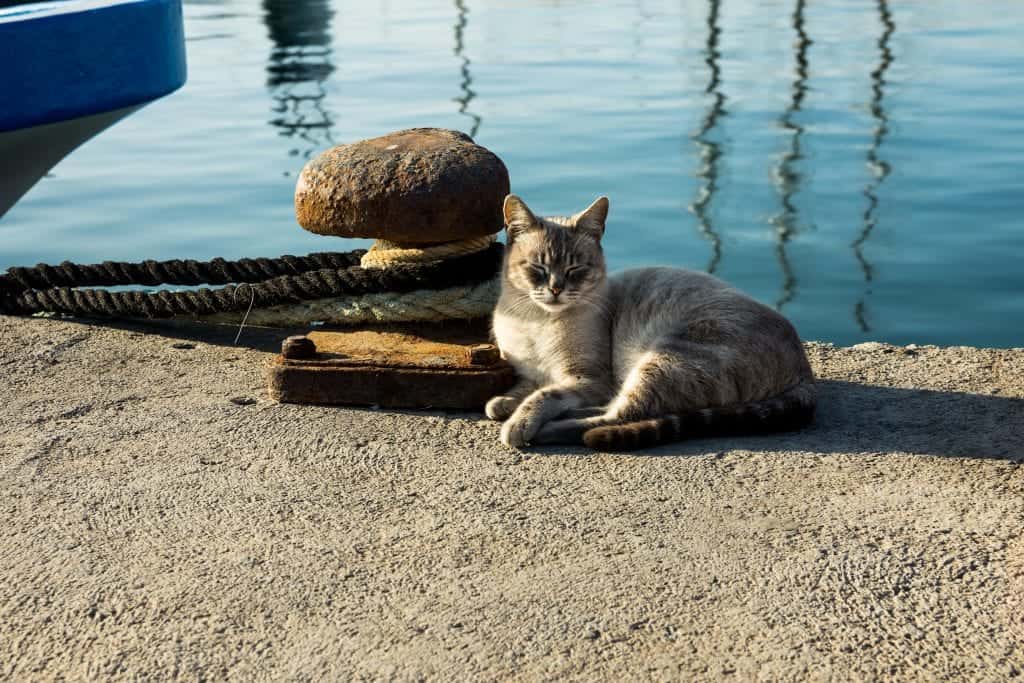
Don’t go out on the water without suiting your cat up in a life vest, as this is an essential safety device for your kitty. You might not find many options designed specifically for cats , but vests made for small dog breeds will fit most cats. Leave plenty of time to get your cat used to the life vest before your first afternoon out on the boat. You may need to let your pet play with the life vest and try it on a few times before it’s ready to wear the vest for an extended period.
Know How to Alleviate Nausea

Like humans, cats can become seasick and succumb to nausea. You might not be able to assess your cat’s tendency to get seasick before heading out on the open water, but you can take steps to alleviate the symptoms if they arise. Bring some catnip along for the boat ride, as this herb is a great cure-all for cats. You can ask your vet for a prescription medication as well, which may help alleviate both anxiety and nausea.
Keep Your Cat Nearby

No matter what type of boat you have, you might be surprised to find out just how many hiding places your cat discovers. If your sailboat has more than one deck or a couple of enclosed areas, your cat could easily slip out of sight. To ensure that your cat is always safe on the water, make sure you know where it is at all times. Double check before closing doors and cupboards, and keep your kitty nearby whenever possible.
Why leave your kitty at home when it could join you for a sunny afternoon on the water? By following this guide, you’ll ensure that your cat can enjoy a fun outing while staying safe!
Share This Story!
About the author: jessicat.
Related Posts

Single Kittens Meet for the First Time, and It’s Hilariously Awkward

Chicago Cats are a Meowdel for How Cities Can Help Feral Felines
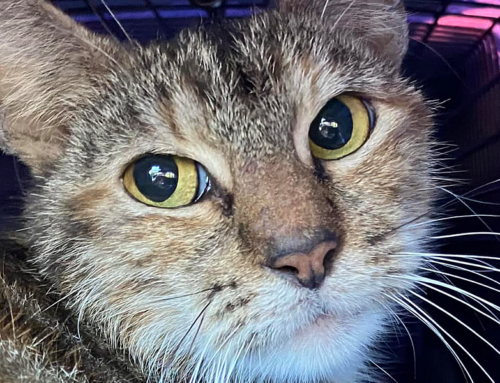
Two Often Misinterpreted Ways a Cat May React to Fear and Stress

‘They are Alive!’ Cara Delevingne Overjoyed as Firefighters Saved Cats from Devastating Home Fire

Magical Kitten ‘Tarot’ Draws the Luckiest Card and Avoids Disaster

Meowgical ‘Alice’ the Kitten Leaves a Purrmanent Impression on Everyone

Did You Know There’s a Page Entirely Dedicated to Chirping Cats?

Billi the Talking Cat Holds Mom Accountable for Her Promise
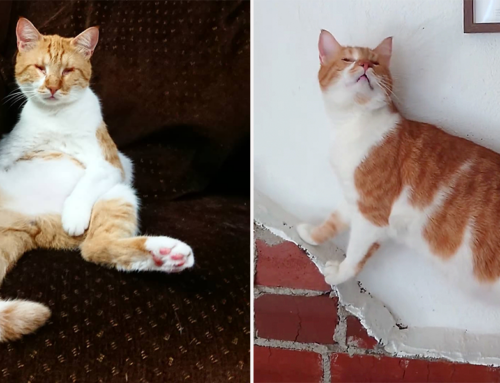
Follow This Adorable Blind Cat Exploring His New Surroundings
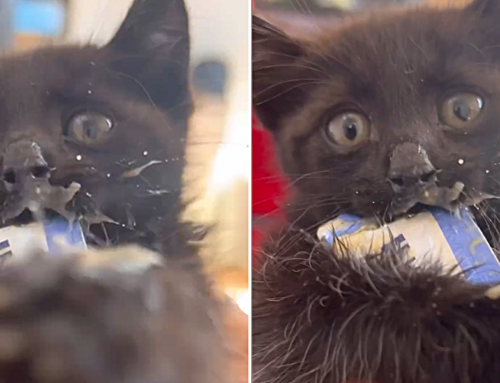
The First Time You Try Your New Favorite Food: Kitten Edition!
50 years ago I had a re-homed Lilac-Point Siamese who had been left behind when her family emigrated. She’d been a “shop counter cat” and customer greeter so was entirely at ease with strangers and would talk to anybody. She was also completely happy travelling in a car. She used to divide her journeys into sleeping on the front passenger’s lap and standing between the seat cushion with forepaws on the instrument panel commenting on the passing scenery. No cat-carriers 50years ago! So we took her on a sailing holiday to Salcombe in south Devon, England with our 14 foot dayboat. The Salcombe estuary has many wooded areas inaccessible except by boat so it was possible to take her walking with very little risk of encountering anyone with a dog. She loved jumping down to the beaches from the boat and walking in the woods, where she would run ahead, calling back to us to hurry up or pausing to climb a tree. This activity would last about 10 minutes then she would slow down and wail to be carried. After a suitable rest the cycle would be repeated. All went well until one day we took her back to the boat before she was ready to go home. She stood on the side-bench, forepaws on the gunwale looking back at her beloved woods then without warning sprang overboard and struck out for the shore! No small animal buoyancy jackets back then but she seemed fine – swimming strongly – we were the ones upset! Luckily there was no wind so we were using the outboard motor and I was able to quickly come alongside her and scoop her back on board! She didn’t seem at all bothered by the experience which made me wish I’d left her a bit longer and taken some photos before rescuing her! After that, no more sailing and the rest of her outings were long walks on Dartmoor. Suki is long gone now, but a cat who will live forever in my memory.
Awe, such a special cat and beautiful memories <3
Leave A Comment Cancel reply
By using this form you agree with the storage and handling of your data by this website. *
This site uses Akismet to reduce spam. Learn how your comment data is processed .
Terms and Conditions - Privacy Policy
Boating with Cats: Cruising and Living on a Boat with a Cat

Everyone always talks about taking ol’ Fido for a trip out to the lake, but no one really mentions boating with cats. Maybe it’s because cats are a little less outdoorsy than their canine counterparts. But hey, that doesn’t mean you can’t take your furry feline for a boat ride.
But before you strap her in her seat and rev up that motor, it’s important to know a few things to keep both you and your cat safe on the waves. And what exactly does that entail? Here’s what you need to know.
Can You Take Cats Onboard a Boat?
The short answer is yes, you can. There are presently no regulations or boating rules that say you can’t take your cat out on a boat. But that doesn’t mean you can just take her out anytime you want to without preparation or training.
Aside from getting your cat ready for the trip, you’re going to want to buy a few things to make the trip more comfortable and enjoyable for your feline. This is especially important if you plan on making this a regular experience for your cat.
Tips for Boating with Cats

The thing about cats is that they’re not really designed for water. Sure, they can swim , but that doesn’t mean they like it. And then of course there’s the predicament of getting them out of the water and back in the boat.
That means you’re going to have to exercise whatever techniques are at your disposal to make sure your cat stays safely on board throughout your trip.
Acclimate your Feline
Although you might be excited to bring your furry friend out to your favorite spot, it’s important that you take the time to acclimate them to your boat. That means letting them explore the vessel while it’s parked safely in your driveway.
Let your cat explore the boat. Take them on a little tour and see how they respond. If they feel a little anxious, provide care and comfort by reassuring them of your presence. It also helps to repeat the process in case they aren’t too comfortable the first time around.
As they get used to the conditions on your boat, you can gradually introduce them to other elements of the boating experience. For instance, you can dock your boat at the local marina and sit on board with your cat while the waves move your boat about.
While no one wants to see their cat fall overboard, there’s no harm in testing out how well they swim. This should prevent drowning accidents that no one wishes for, but would be nice to be prepared for nonetheless.
You can test this safely at home in a tub or a small outdoor pool. Get your cat to swim a few minutes everyday to get them used to the movement and the water. You can also take them to a nearby shore (make sure they’re on a leash!) and see how they respond to gentle waves.
Train to Climb
It’s one thing to know how to swim and another to get back on board. After all, what good is it for your cat to know how to swim if you can’t pull them back into your boat?
There are a bunch of options you can use to train your cat to get back on board. Pet ladders are common, but these ladders are mostly designed for dogs . Some cat owners use rope ladders since they’re easier for cats to cling to as opposed to steel step ladders .
Use a Flotation Device
Yes, there are flotation devices for cats, but your feline probably won’t feel too comfortable wearing one right out of the box. So make sure you try to get them used to that, too.
Get your cat to wear their PFD especially when you’re on your boat or around water. You might also want to watch them swim with their flotation device on so you can see whether it makes it more difficult for them to swim. If it does, you might want to consider a different design.
When all Else Fails
A long handled net big enough to scoop your cat out of the water might be a handy tool to have on board in case they’re in a panic. Some cats lose their cool if they’re too worried or anxious, which isn’t unlikely if they’re tossed overboard. A net should let you fish them out of the water and back to dry safety.
Do Cats Get Seasick?
Yes, cats do get motion sickness . Unlike dogs who tend to enjoy long rides either in cars or boats, cats tend to do poorly when placed in a moving vehicle. The nausea they feel is often exacerbated by the anxiety and stress of being in a strange new environment.
Some of the symptoms of seasickness in cats include:
- Excessive drooling
- Pacing and restlessness
- Loud meowing or hissing
- Obvious discomfort
- Acting 'on edge'
The best way to ease their anxiety would be to provide them a safe, quiet place to stay while you’re underway. A cat carrier would be the perfect little nook for an anxious cat to feel more comfortable and secure especially when they’re in a new environment.
Other than that, you’re going to want to take them out on shorter trips first. This makes it easier for your cat to get used to the conditions out on the water so they’re ready to take on longer excursions.
Related: Can Seasickness Kill You?
The Essentials for Having a Cat On Board

There’s a whole lot more to boating with cats that you’re probably going to discover on your own, especially since all cats have different personalities. But in general, you’re going to want to take these snippets of wisdom with you when you set sail:
Never Leave Them Out of Your Sight
Curiosity could very well kill the cat especially on a boat. Since cats like to explore by nature, they could get themselves into dangerous situations if left unattended.
Make sure they’re always within view when you’re on board and underway. If you ever find the need to do something that you can’t take your cat with you to do, keep them in their crate until you get back.
Keep a Leash Handy
Your cat should never be without a leash when you’re out in the open water. Tethering them to your wrist or to a central element of your boat should prevent them from accidentally falling overboard.
It also helps to get a leash that attaches to a body harness or vest instead of a collar to add an extra layer of safety.
Visit your Vet
There’s no harm in consulting with your vet before you set out on a trip. Depending on your cat’s needs and your vet’s orders, you may have to consider buying some anti-motion sickness medication specifically for your cat in order to keep stomach pain and nausea from boiling over.
Your vet might also be able to provide you vital information for safety that could save your cat’s life down the line.
Offer Comfort
If there’s anything or anyone on board that can really keep your cat from getting anxious, it’s you. See to it that you really take cues from their actions and body language, and make sure there’s no shortage of comfort and petting.
Some cats prefer being locked in a gentle hug while they’re still getting used to the conditions on a boat just to know you’re there for them and that everything is fine.
Don’t Forget Essentials
Your cat’s needs don’t take a break when you’re on a boat. Living on a boat with a cat means providing all of their needs right where they can access them. Set a safe space for a small kitty litter box and some food that they can come back to when your boat is parked or docked.
Make sure you find a secure place for it all in storage since aggressive waves could easily toss them around and make a mess.
All Paws on Deck!
No one really talks about cruising with cats, but it is possible with some practice. If your feline isn’t a natural sailor, you can get them acclimated to the conditions on your boat and out on the water so they feel more comfortable next time around.
And while boating with cats might take a little extra preparation than boating with a dog, it’s definitely a rewarding experience to have your best buddy on board for snuggles and cuddles whenever you want them.
Related Posts

What is a Duck Boat (and What Does it Look Like?)

What is a Cigarette Boat? (And Why is it Called That?)

Where is it Legal to Tie Up Your Boat? [The Rules]

Hydroplane Boat Speed: How Fast Do Hydroplane Boats Go?


Meet Our Customers
Welcome to Sailrite’s "Meet Our Customers” page where we feature fascinating interviews and interest pieces submitted by our customers. This page enables us to spotlight our loyal and creative customers and tell their stories. From tales of complete canvas refits to testimonials about how Sailrite products and services have greatly enhanced and improved their DIY lifestyles, these stories are sure to inspire you as much as they inspire us.
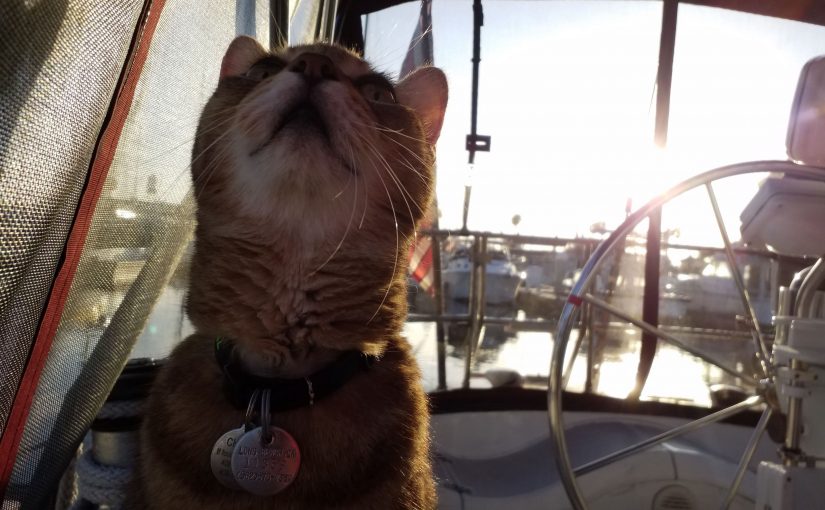
Sailing With Pets: How to Cat-Proof Your Boat
After marrying in 2008, Luisa Mixon and her husband, Seth, set their eyes to the sea. Like many Sailrite® customers, their dream was to buy a sailboat, learn to sail, and eventually gain enough experience to live completely on board. When they envision their retirement years, they see themselves sailing wherever their hearts, and the wind, take them. Their journey towards making this dream a reality has been one of excitement, hard work and ingenuity. They grow closer to reaching it every day.
Before becoming sailors, Luisa and Seth would often browse used sailboat websites and peruse sailboat shows, window shopping and gathering ideas for the type of boat they would purchase when the time was right. Most of the searching was just for fun, as actually owning a boat had always seemed far on the horizon. Then one day at the end of May 2018, something amazing happened that would catapult them into a new life sailing and sewing: They found their dream boat for sale in Long Beach, California.

“The boat — a 1989 Ericson 38-200 named Astral — was beautiful and in excellent condition, so we ended up buying it. Less than a month later we were proud owners of a sailboat even though we didn’t know how to sail! Crazy, right?”
The couple then chose a marina in San Pedro, California, so the boat would be closer to their home, and learned the ropes from a few neighboring sailors. By August they had completed their first solo sailing trip and had fallen in love with life on the water. To complete the crew, the next step was to make the boat safe for Luisa’s two rescue cats, Charlie and Astro. You see, these aren’t your average felines. Charlie, a 13-year-old tabby, needs special medicine every 12 hours and Astro, a 10-year-old Bombay, requires special food for medical reasons. Considering that both animals warranted extra attention and could not be left alone for extended periods of time, it just made more sense to bring them aboard. But in order to do that, the living area of the boat had to be completely “cat proof” first.

In preparation for this project, Luisa had already been following the videos of other sailors who had completed tons of DIYs for their boat. One of these was Project Atticus, a couple who sail abroad for months at a time and sew their own projects using the Sailrite Ultrafeed® LSZ. After looking at the Sailrite website and YouTube channel, Luisa finally felt she had the confidence to start a project of her own: a new bimini and screened-in cat enclosure. Naturally, the next step was to choose a dependable sewing machine and gather supplies.
“I had never touched a sewing machine in my life, so I was eager and nervous to start. We wanted the best for our boat, a machine with excellent quality that would last a long time, so I ordered the Sailrite Ultrafeed LSZ and every single material and tool that was suggested in the videos. It was so exciting!”

Now fully prepared, the real work could begin. With their marina being so close to Catalina Island (around 20 nautical miles), Luisa and Seth decided to challenge themselves and plan a Thanksgiving sailing expedition. This meant that the new bimini and enclosure would have to be done quickly. Being from Colombia, Luisa’s DIY adventure came with a new set of hurdles, all of which she was able to overcome.
“My first language is not English, and I had never sewn before, so the hardest part was my pace completing the projects. I had to go slow watching the videos, understanding the English. And because I wanted my project to be perfect, or at least close to perfect, I had to go back and forth, checking to make sure I was doing things right.”
Luisa took a week off work and toiled for 16 hours each day to sew her own bimini and screened-in enclosure with help from Sailrite. She soon developed a love for the work and was extremely satisfied when the finished product fit perfectly. By the end of it all, she had created a lasting addition to Astral that would come in handy on future expeditions with her four-legged first mates.
“My cats love to be on the boat … once it’s at anchor and they’re placed in the enclosure, they’re very happy. They love to see the seagulls, seals and fish. It’s amazing for them and I’m happy if they are safe and happy!”
This slideshow requires JavaScript.
Luisa and Seth initially eased into their sailing journey, hoping to gradually acclimate their furry companions to life aboard. They started staying overnight at the marina on weekends and then practiced anchoring twice at White’s Island, staying for four nights each time. Luisa’s confidence with the Ultrafeed has allowed her to create several other useful projects for the boat. Along with the bimini and cat enclosure, she’s created screens for the windows below deck, modified her V-berth cushions and sewn a generator cover. She has her sights set on sewing new sheet bags and sail covers, with many more DIY sewing endeavors on the to-do list.
The plan for this sea-faring couple is to eventually move aboard Astral permanently. They’ve been placed on a waiting list, as it can take years to get the liveaboard slip, but the faster this happens, the faster they can retire and start exploring the open ocean. As for now, the pair are simply enjoying the journey that brings them closer to their dream.

“In the meantime, we are sailing every Saturday and doing boat projects on Sunday. We work regular jobs Monday through Friday but we are practicing and learning more about sailing every day … reading books, watching videos, and continuing to sail to Catalina and White’s Island. We want to enjoy our boat to the fullest before we cast off!”
Sailrite is your one-stop DIY shop! We are a passionate crew of do-it-yourselfers who strive to equip you with the supplies and how-to knowledge you need to tackle your next project. Do you want to learn upholstery, leatherwork, canvaswork, hobby sewing, bag making or more? We have the fabric, tools, hardware, sewing machines and notions you need to master any DIY. And even if you’ve never sewn before, our tutorials and how-to videos are designed for beginners and experienced crafters alike.
Start your DIY journey today: www.sailrite.com
Share this:
- Click to share on Twitter (Opens in new window)
- Click to share on Facebook (Opens in new window)
18 thoughts on “Sailing With Pets: How to Cat-Proof Your Boat”
WHAT A WONDERFUL STORY OF TEAMWORK AND A LOVE FOR THE SAME THING. SAILING LOOKS LIKE A GREAT PROJECT. GOOD LUCK WITH YOUR SAILBOAT AND YOUR GREAT LOOKING CATS. BEST REGARDS, JOAB IRWIN
Sailing seems to be an endless project, which has given us a new purpose in life, and we are so happy to bring our furry babies with us. It’s so rewarding. We thank you for your kind words!
Enjoy reading your story. I am living with my husband and my 2 cats on a 38’ ft catamaran. My cats are 13 and 11yrs old and they ask some special care too but we enjoy to have them on board. Good luck in your project.
Thank you Nathalie! We can’t wait to untie the lines and continue our adventures 🙂
Fantastic job guys, good luck in your ventures.
Thank you Adrian 🙂
I have cats on my Ericson sailboat and we liveaboard. I just bought my LSZ sewing machine and I’m working on all my canvas projects. I wold like more info on the cat enclosure that they made so I can make one, too.
The couple essentially made an enclosure for their boat with lots of screens for the windows. Here’s a project we did that is similar: https://www.sailrite.com/Installing-Zippered-Window-with-Removable-Screen-Video If you have any more questions, please email [email protected] and our customer service team members will be happy to offer DIY advice and suggestions for your project.
Thank you so very much for this response. I will be remaking my Bimini and dodger so I will have the info to make my cat enclosure at the same time I do this. I think that will make this easier than retrofitting a screened in porch fir them.
Hi Seth and Luisa, thank you so much for sharing. Really enjoyed this article and all the pictures. Do y’all have a YouTube channel we can subscribe to. Would love to follow y’alls adventures. Luv from Alvin and Rita
Hi Rita and Alvin, thank You for reading our story 🙂 We don’t have a YouTube channel (yet?) perhaps when we untie the lines we would have more time to work on it, for now, we just have an Instagram account (Sailing_SVAstral) where we share some of our sailing adventures. You are welcome to follow us there! <3
Loved your story, I am a professional canvas fabricator and sailmaker and am thrilled when someone takes on a project and does a great job! I was a live aboard with my husband, sans cat, but add toddler! Some of my best memories! Congratulations!
Hi Heidi, I never imagined all the hard work and dedication canvas project can require. Even the simplest project (that people think it looks easy to do) requires time and hard work, Ohh and so far I haven’t deal with sails :-O I appreciate your comment. Thank you!!
You go girl! I lived aboard with my Dachsund, he looked so cute rushing around the deck in his life jacket. Cats are easier, you have to dinghy ashore for the dogs. Joy
Hi Joy, Dachsunds are adorable!! So far we have only cats, and we’ll be that way for a while. Please give that bundle of love of yours a kiss from us and our cats 🙂
I LOVE this! Our teenager cat “Dinghy” will be moving onboard with us Fall 2019 and this has given me confidence to make a cat enclosure for him. THANK YOU FOR SHARING!!! I would love any other suggestions and tips from other live aboard cat owners as well! (like…do they get seasick too?)
Thank you! We aren’t liveaboards yet, however, I can tell you they love the boat and their enclosure! When we take them out, which is usually when staying at anchor for few days, Charlie the tabby, he gets seasick sometimes, he pukes and goes to the litter box right after the boat starts moving /sailing, then he just lay down and waits till we are at anchor to start checking the view (through the enclosure)! Astro, on the other hand, has never been seasick. We are on Instagram as @sailing_svastral. You can check us out as we go on our adventures and feel free to ask questions about the enclosure 🙂
Fair winds and following seas the best to you both! I’m very happy with my LSZ-1 Never thought of cats and sailing….I’m learning also
Leave a Reply Cancel reply
Your email address will not be published. Required fields are marked *
Notify me of follow-up comments by email.
Notify me of new posts by email.
- Nov 13, 2021
Sailing with Cats
I occasionally get asked what it's like living with cats on a sailboat, so I figured I'd put together a bit of a list to cover some of the more common questions I get asked about sailing with some cats on a yacht.

I don't intend for this to become a penultimate 'how-to guide for boating with cats', just a sort of loose rundown of some things that I get asked about and some others that I think might be of interest.
I'm also not encouraging people to take cats on yachts or boats, but if you must, or just can't leave them behind - here is what we did, and how it's worked out for us, so far.
Living with cats on a yacht...
If you're living on a yacht, or want to, and also decide to bring cats into the mix - there's a few things you may want to take into consideration...
Life on the water
Getting your cats used to life on the water, I feel, should be a gradual process...there's a lot of new sounds that happen on a boat that they're probably just not used to, such as the constant sound of water, passing boats, waves, the engine - even just the movement of the boat can take a little getting used to for some cats.
So, before we even left the dock, I gave them about a month to get used to everything.
They spent the first week was spent sniffing around and inspecting everywhere that could be inspected, and by the second week, they were pretty chilled about the new environment having found their 'spots' in various places...
They didn't even want to know about the outside world until the third week.
By the fourth week, they had been introduced to most of the sounds and then the final test of actually going sailing, which they didn't exactly like at first.
Around this time I also used to run the engine for about an hour a day just to get them used to that sound - the first time they heard it they weren't sure what to think of it, but again, they didn't like that too much either.
But after a short time of learning that the engine was a bit loud but essentially harmless and the heeling of the yacht, although tough to walk in, was also harmless - they were fine about life on the water.
Now a few years in, they couldn't care less about all the noises - and are now as 'at home' on the water as they were on the land, but I think gradually introducing them helped them make the transition.
But some cats do take to it right away, but if your cat has any kind of nervous disposition, please consider doing it gradually - Look, once you get your cat onboard - you'll know what kind of cat you have!
Cats need Space
Our yacht is 35ft in length, and with 11.5ft of beam (width) I'd say there's quite a bit of space onboard - this vessel can, technically, sleep 9 people - but I wouldn't like to try it!

Unless your cats sleep together, they're gonna need their own space somewhere onboard - at nights, well, my cats go to the warmth and generally sleep in whatever cabin I sleep in.
But during the day, or when I'm not sleeping - they have their own little spaces they find to claim as their own.

I think its important, that they have a space, or spaces where they're comfortable and relaxed or just a place they can go that they can rely on when they get a little stressed or something has disturbed them, like strange noises from outside the boat...
...plus they need some space for when the 'zoomies' strike!
But extra care should be taken to ensure that they cannot get into anywhere they might come to harm, like into the engine room, or into chemicals or cleaning products. Cats can squeeze themselves through quite small openings like access panels to through-hulls that lead into other potentially dangerous spaces.

This was something I thought I could deal with by brushing them regularly to minimize shedding, and vacuuming regularly. Although brushing them helps - I'm slowly losing the battle.
I think getting a powerful vacuum is essential to get as much of it as possible, but I think even with the best tools at your disposal, you're not going to get it all, over time - it wins.
I have just accepted that there will always be a certain amount of cat hair, and I guess it doesn't really bother me so much anymore - but if it's something that bothers you, then it's something to think about.
Cat box / Litter tray

Onboard, the cats use litter trays and they seem to prefer certain brands. There is a lot of debate around whether to use the crystals or some of the lightweight cat litters - I will not wade into that, as my cats use fullers-earth(clay) cat litter.
I'm glad they like it - it's cheap, widely available - and it sinks.
The fact that it sinks is important. I had used some of that lightweight stuff once as I couldn't get any of their usual stuff - rather than clean the box with the little shovel, I just tipped the contents of their box over the side and a 50ft 'cat litter slick' appeared in the harbour - you don't do that twice. It was all-natural stuff, so it didn't do any harm, but it sure looked a mess!
The downside to clay cat litter is that it's heavy. I don't mind that it's heavy but you have to get it on the yacht - and that usually means carrying it. The longer the pontoon, the longer the haul. Stock up when the shop is nearby!
Keeping it dry can also be an issue depending on your boat, but for us, it's never really been an issue. Also, If you are moving around, you will also need to carry a stock of it - so stock up when you can...the further-flung you go, the less likely you are to be able to buy some. We've had as much as 200kg of cat litter onboard at one time, and try to keep a 'float' of 50kgs - about a month's supply.
Running out of litter is a smelly disaster, and one that's best avoided on a small boat - you've been warned!
If you have picky cats, that prefer a specific special brand of cat food, we recommend stocking up on it wherever possible. buy as much as you can sensibly store. Finding it another store is always possible - and when you do find it - they may only have a small stock of it.

Stocking up will save you the bother, and possibly, a long walk to a store that sells the precious foodstuff that your cat has to have - If I know we're going to be moving around for a while it's not uncommon for us to have 3-5 months of cat food onboard.
It sounds like a lot, but it saves so much bother in the long run, for us anyway...
Sailing with cats on a yacht
Having your cat, or cats, onboard while you're sailing is awesome and terrifying at the same time. Sure, it's nice to have them there, and they're great company - but just the slightest error in judgment can have tragic consequences.
I remember reading that a person in the water, in a bright orange vest, in moderate choppy seas can only be clearly seen at a distance of around 20ft, much further, and they get lost in the chop of the waves and become sporadically visible for a few seconds before being lost to view again by waves. The small or even the largest domestic cat has even less chance, and at night - almost no chance.
With us sailing in the North Sea, that water is cold - that water is death as far as I'm concerned - so I've set things up with that in mind, to minimize the probability of anything or anyone falling overboard...
So how do you keep them safe?
Netting the safety rails
To net, or not to net? Some people don't like having the netting on the rails, whereas others think it looks good, others just appreciate that nothing gets lost over the side.
Whether you are sailing or not, I like the netting as it limits the number of places they could actually fall over the side - so it gives me fewer places to have to keep an eye on, plus I like that it actually makes a bit of a barrier to the outside world when we're in a marina.

We've had instances with dogs, loose on the pontoon. Some dogs are ok and don't bother the cats - but the odd dog will have that instant reaction and try to chase them, but the netting prevents them from boarding. So I like the netting for keeping the cats on, and for keeping intruders off!
Not putting dogs down in any way at all, they're just doing what they do, and are popular sailing pets that aren't always on a lead, so they will be around in certain marinas, it's just another factor to take into account when deciding to net, or not...

We've found netting to be very effective, cheap, and easy to install and would recommend it for sailing vessels - But cats will find the gaps and pop their head out from time to time...
Above or below decks?
I get asked if the cats come on the deck while we're sailing, the truth is both yes and no.
When conditions are glassy calm, sure - I'll let them up on deck, and if it is that calm they want to come up. If conditions are choppier, Phoebe will tend to be in her bunk or near her food bowls, while Chloe will be on my lap in the cockpit.

If conditions are fouler, they are both down below in their bunks where it's safe and warm and have no interest in coming topside, this is both by their choice and my preference. This is, of course, an ideal arrangement that just happens to work for us and also makes the most amount of sense.
Cat Safety Gear
I have seen a lot of different types of life vests for cats, and I don't recommend any of them, there may be some good ones out there - but I haven't seen them. The ones that I have seen seem cumbersome and uncomfy for the cat to wear - and the last neoprene life vests I tried to get my cats to wear, one of them at least, managed to get caught up in a deck fitting!
Both of my cats hate them and end up spending their time trying to get out of them, this being the case I tried harnesses with much more success. They won't help them float, but the harness does allow them to be tethered to the boat, so they can't fall off, and they don't seem to mind wearing them as much.
That being said - they are rarely in their harnesses, it's only the odd occasion when they want to come on the deck while we're sailing. I don't make them wear them when we are tied up in a marina. Although I have seen folk who keep their cats in harnesses and on tethers at all times , and I guess that works for them, luckily our cats are relatively well-behaved and don't tend to go wandering off.
I think most of the stuff you see on the nautical market for sale for cats, as far as I can see, is mostly just for aesthetics or to give 'peace of mind' to the owner, but I feel they do little for the actual safety of the cat.
All I can say is that harnesses worked for us, but I would encourage you to try different methods to see which one works best for your cat, on your boat.
The best tools cats have - is their claws. I would recommend that you don't trim your cat's claws as they will need them onboard for keeping their grip. Get a scratching post so they can keep their nails in tip-top shape!
Do cats get seasick?
Yeah, as I understand it, yes they can. Cats are as susceptible as anything else to seasickness, but as we live on the yacht full time I think we're quite used to the motion of the sea by now - and we've had no instances of feline seasickness, so far...and we've done a good few thousand miles.
I think a gradual introduction helped with this as well, for both the cats and myself - I think just about anyone will get seasick if you just go from land to the open ocean...your body just takes some time to adjust, and I think that's true for cats, dogs, rabbits, or people...
I think if conditions were right, even my seasoned girls would, no doubt, get seasick - as I probably would. No one is immune to seasickness, it's all down to your bodies' acclimation to the sea, but again, if conditions are right - even the most seasoned weather-hardened sailor will eventually succumb to some form of seasickness at some point.
Assuming you are sailing on the sea, salt is something to consider also. We have an elderly cat on board with some health issues and although the amount of salt on the deck itself is probably harmless, over time, prolonged exposure can't be good, right?
Whenever we've been out sailing, I almost always rinse the deck with fresh water before I let the cats out on deck. If you've been out for any real amount of time - a few days or more, all the spray from the bow and every bit of seawater splashed on deck crystalizes and becomes like grit on every surface, and that 'grit' is super salty! in some places it forms like frost.
I only include salt on this list as one day I happened to notice my cats licking their feet and making some faces as they did so...so the salt was def sticking to their feet and was understandably unpleasant to lick! From then on I made it a policy to always rinse down the decks...
The salt, also, if it gets in their fur seems to generate little tufts that can't be brushed out. Phoebe, our elderly cat who has the longest fur seems to be most affected by this and gets little knotty tufts in her belly fur from laying down on an unrinsed salty deck...
Cat Medication
Now, this has been a real pain in the ass for us. Our elderly cat, Phoebe, occasionally needs some medication, and as long as we have it - all is well. But running out, and getting more meds from a new vet can be an expensive affair.
I have records for both cats, and even if the issue is well documented they will still want an 'initial consultation fee' plus the cost of the meds, or they might want to re-run tests or scans altogether - all to get the medication that only costs a few dollars. We run everything on a very tight budget and just can't afford to shell out like that each time we need a repeat prescription...
And I'm not talking about anything crazy either, our issues have been centered around antibiotics, and on one occasion, some anti-inflammatory medication...but even something as simple as eye drops can be a hassle.
I understand their policy, and why they do it - but it's a situation that can be avoided with a bit of planning - as it can run into hundreds, if not thousands very quickly.
The best policy would be to get good health insurance for your pet - looking back, I think it probably would have worked out cheaper in the long run for us - but she's a bit old to get a practical plan now, but hindsight is 20/20.. blah blah blah.
Our advice is to talk to your vet and get any medications you need in advance or arrange to have them sent to wherever you are to avoid any additional expenses. I feel it's best to carry what you need - and don't delay in replenishing stock as it's used by your pet.
You never know what unforeseen issues can delay the mail, such as a mail strike or a pandemic - but best to avoid new vets if possible, from a 'cost perspective' that is. stocking up on what you need will save you a lot of time/money and save your pet from having to wait for medication, but again - insurance would possibly alleviate this issue.
Tracking Chips

These are a no-brainer, get your pet chipped. If they were to get lost or somehow get separated from the boat through any unforeseeable event - that chip is probably the best chance you ever have of getting your pet returned to you.
A lost, or stray animal, upon getting to a shelter is usually scanned for a chip. If your pet has no chip - it just goes into the system like a regular cat, and depending on what kind of shelter your pet has been handed into will decide its fate from there...
Cats on Sailboats
In conclusion, can you live on a sailboat with a cat? Yeah, it's totally possible, but you'll need or want to make a few adjustments to keep them safe. And all of this is in no way all you have to do, all cats are a bit different and have slightly different requirements, you'll have to customize your boat to both the needs of your cat and your own preferences to keep everyone happy...

We've been living and traveling for almost 3 years on this yacht and I have no regrets in taking them with me, and they seem to like it - I definitely get to spend more time with them and it's certainly more interesting than just looking out the window of an apartment.
I had been worried about Phoebe as she was 15 when we moved aboard - and I thought that being an older cat she might have the hardest time adjusting, but she was super casual about the whole affair - I think she's pleased to be spending her twilight years on a yacht.
Sure, they generate a bit of anxiety from time to time, and would it be easier without them - sometimes, but I couldn't have left them behind and am very pleased they were able to make the adjustment.

If you feel there is something important that I've missed out, or something that should be included, or just have a question about sailing with cats, please feel to send us a message through our Facebook page and we'll do our best to get back to you in a timely fashion!
Happy Sailing!
Recent Posts
0058 - An update, and the Rain...
0057 - A 'quick' recap of 2022
0056 - The Tale of Phoebe Alexandra
- May 4, 2022
Three Cats on a 30-Foot Sailboat (and Why My Cats No Longer Live Aboard)
St. Croix, like many places in the world, has a feral cat problem. Everyone on St. Croix who wants a cat has at least four. Everyone who doesn't want one has at least one.

And so I found myself, a lover of cats, with seven formerly feral cats at the time that I sold my farm to move onto a boat. Luckily, the person who purchased the farm was willing to take on some of the cats, and so I left the farm and moved onto a boat with exactly one cat per 10 feet of boat. I would've taken them all if it had been remotely reasonable.
I was very worried about how my three mostly outdoor cats - Cooper, May, and Melee - would do on a boat. They were all born in the bush and had never been solely indoor cats. They'd been allowed to roam freely outdoors most of their lives.
Would they jump off the boat and try to swim to land? Could they even swim? Would they be miserable and depressed at their new circumstances? And, ugh - a litter box?
I transported them all in cat carriers via dinghy to their new home at anchor and released them inside the cabin. I'd closed off all exits so no one could bolt into the water (Cooper had been known to literally climb the concrete walls of the vet's office, so my fears weren't without merit).

They explored inside and were equal parts confused and curious, but adjusted relatively quickly. I kept them locked inside for a couple days before letting them on deck, where they stayed for only a moment before going inside.

I'd purchased a cheap rug and cut it into strips that I hung off the side of the hull as a way to climb up if they went overboard. I knew that, in an anchorage with a sometimes swift current and big swell, the carpet might do very little to help them, but it gave me some peace of mind. I had to accept the fact that if they went over in bad conditions, it might end sadly.

As it turned out, though, they never seemed to consider the idea of jumping. In fact, they spent most of their time inside (unless we were on deck), except at night when they would make rounds from the companionway and across the top of the deck to the hatch, where they would jump in on top of us as we slept. Then they'd return to the companionway only to repeat over and over. I never figured out why they only liked to go outside at night (except that they slept all day). Either way, I lost some significant sleep to a certain 15-pound cat landing on my face throughout the night.

When I began the floor painting project in December 2019, I decided to move the cats to my parents' house (to complete the project and so I could do some traveling). Normally chill Melee put up a real fight getting into the cat carrier (and very nearly won); she shed a significant amount of fur and I shed a significant amount of skin before I finally wrangled her in. She growled for about a day straight and hasn't been in a cat carrier since. But after another dinghy ride, they made it back to land for the first time in four months, where they happily settled into indoor cat life with much more square footage than the boat had to offer.
Covid happened, and a series of unplanned events led to the cats still being there in May 2020 when I hauled my boat out. And so the cats stayed at my parents' house while my boat was on the hard for 15 months. I couldn't imagine having three cats in a fiberglass dust coated boat in the boatyard, and I was thankful that they (and I) had a place to stay while I did a full restoration on my boat.
As my boat neared the launch date, we all had concerns about bringing them back to the boat again after so much time off the boat. The transition to the boat had been relatively smooth the first time, but I wasn't sure it would be a second time. The dynamics between the three cats was never wonderful in the small space of the boat; two cats were often at odds with one another at any given time. I don't think the cats ever disliked the boat, but it was clear that they were happier in the house, with more space (and more food - my parents grow big cats). I wasn't sure Melee or I would survive getting her back in a cat carrier. I debated taking just Cooper, but he's a very social cat, or just Mae, but I was afraid she'd be lonely when I was off the boat. I also do a significant amount of traveling not on my boat, which would mean a lot of back and forth between the boat and land for the cats. And so we decided they'd remain, instead, at my parents'. It wasn't an easy choice, but it's one we made with the wellbeing of the cats at the forefront of considerations.

I don't think having cats on a boat is inherently a good or bad thing. Some cats are happy to live out their days on the water; some have never known anything else; some would prefer staying on land. Mine were somewhere in between, I think, but I think lean a bit more toward land kitties than sea cats.

If you're thinking about bringing your feline family member aboard, I learned a few things that were key to having cats on board that might be helpful to you:
A dedicated litter box space is essential. I put mine inside the chart table cabinet and cut a hole in the side so they could go in and out (so I could still close the cabinet from the front). Consider how you'll secure it while underway or in a rolly anchorage. A dedicated space keeps the spread of litter at bay; otherwise, it will be all over the boat. And litter in the bilge is no bueno. I'd highly recommend a mat that removes litter from their paws next to/underneath the box as well.
Cats, especially younger ones, need toys to keep them active on a boat. Mine liked this one . If they're accustomed to being outdoors, or even by windows with activity outside, they will likely be a bit under-stimulated on a boat.
Be sure to feed them a healthy diet. If they've been outdoors, they've probably been getting some nutrition from hunting and foraging. Lots of cat foods lack those kinds of things. If you have plants on board, make sure they're not toxic to cats, because they may try to eat them.
Give them small spaces to get away and feel safe, but make sure they can't access any place that's dangerous (like the engine room) or where they may get stuck. There were many times that I had difficulty locating my cats on my 30-foot boat, but once I learned their favorite spots, I knew where to look and appreciated that they hiding spots.
Cats will scratch. If you don't want it to be your cushions, get a scratching pad (I've had lots of different kinds; my cats always prefer cardboard ones like these . ). If they do scratch the cushions, try this tape . It's ugly and will also make you not want to sit on your cushions, but it did seem to deter mine from scratching. Do not declaw your boat cat; if it goes overboard, it will need those claws to be able to climb back onto the boat.

My boat cat experience is limited to about four months at anchor, not in a marina, which I think can be a very different situation. I know people whose marina cats explore off the boat, but remember that not everyone loves cats, and not everyone will welcome your cat aboard (even though your cat might welcome themselves aboard anywhere they please). I've had some very angry boat friends when a marina cat used their cockpit as a litter box...repeatedly.
Having pets on board (of any type) is rarely convenient, but anyone who's ever had a pet knows that they're often worth the extra effort. When I sail with Jerrad, we take his dog, Gidget; it can be time intensive and expensive to make sure she has everything required to enter a country. In some places, it's very easy to clear in with pets, but don't ever assume it will be - make sure all your paperwork is in order! I never sailed anywhere with my cats on board, but if you do choose to, you'll need to make sure to have all required vaccines, veterinary appointments , etc. Failure to do this can have really bad outcomes when traveling (like having your boat being turned away, or worse).
Cats can be really great boat pets; a friend of mine has a cat that is a good swimmer, loves dinghy rides and trips to land. Even cats that started out life as feral cats, like mine, can make the transition. So much of what makes an animal a good boat pet has to do with the temperament of the animal, its needs and your ability to meet those needs. Generally, the more you can be with your pet, the happier it'll be; on a boat, that's even more important.

Sometimes I miss having boat kitties, but more often I'm grateful that my parents were willing to give them a home that seems to be a better fit for them.

This post contains Amazon Affiliate links to some boat cat related items. I do make a small amount of money if you purchase the items following those links and I appreciate the extra income, but I also appreciate you visiting your local pet store and supporting local businesses, too, when possible.
- Pets on Board
Related Posts
Painting Catalina 30 Cabin Sole with Kiwi Grip
Quick & Inexpensive Sailboat Update That Can Be Done in a Day (or Two)
How I Became the Owner of a Catalina 30
❤️So proud of the life you’ve made.
HEATHER MAYNARD - CATALINA 30 BLOG

Create a free profile to get unlimited access to exclusive videos, sweepstakes, and more!
What Happened to Cat Baugh on Below Deck Season 11?
Find out why the stew decided to leave St. David early.

Season 11, Episode 7 of Below Deck saw the departures of two St. David crew members (SPOILER): Jared Woodin and Cat Baugh .
How to Watch
Watch Below Deck on Bravo Mondays at 9/8c and next day on Peacock . Catch up on the Bravo App .
While Captain Kerry Titheradge fired Jared for not knowing his distances, for being ill-equipped to be a Bosun on a mega-yacht, and for his behavior during crew nights out, Cat chose to leave the boat on her own.
The stew took an emotional phone call from a friend shortly before she decided to quit, and she opened up about leaving the boat in an interview on the episode.
After the episode aired on March 18, Cat's former boss, Kerry, shared an update on how she's doing today.
Here's What You May Have Missed on Bravo:
One Crew Member Was Fired and Another Left During an Explosive Below Deck: "Not Acceptable”
Meet Below Deck Season 11's Late Addition, Deckhand Dylan Pierre De Villiers: "My Jaw Is on the Floor"
Captain Kerry Titheradge Teases "Twists and Turns" on Below Deck Season 11
What was Cat Baugh’s experience on Below Deck ?
During the first crew night out, Cat opened up to chief stew Fraser Olender about how she didn't feel like she was fitting in with the rest of the yachties. Plus, her conflict with fellow stew Barbara "Barbie" Pascual , also made things difficult for Cat.
On Season 11, Episode 7, Cat received a phone call from her friend, Megan.
"I'm sorry, I know you can't talk, but she's not answering, and no one else is awake right now," Cat's friend said on the phone. "Do you have, like, a couple seconds? I'm freaking the f-ck out."
Cat didn't share much further context for the phone call, but it did encourage her to make the decision to head back home.
"So, I got a call from my friend, Megan," Cat explained in an interview on the episode. "This is a situation I really can't talk about, but my friends are my family, so it feels really sh-tty not being able to be there for her."
Why did Cat Baugh leave Below Deck ?
After Cat hung up the phone, she had an emotional conversation with Fraser about her place on the boat. He chatted with Captain Kerry about how he thought it would be best for Cat to leave. Kerry later spoke to Cat, and he encouraged her to take time to focus on her mental health.
"My number one job is to take care of my crew and their health," Kerry said in an interview. "I'm well aware of mental health. She's got to go, now."
Just a short while later, Cat packed up her belongings, and she left the St. David crew for good.
"I wish I could have stayed. But, the thing is, there's no way I could have," Cat said in her final interview of the season. "This is too much. I need to be with the people [who] need me, and also, on this boat, I'm at a breaking point. I need to protect my mental health. It's like my support system is at home, not here."
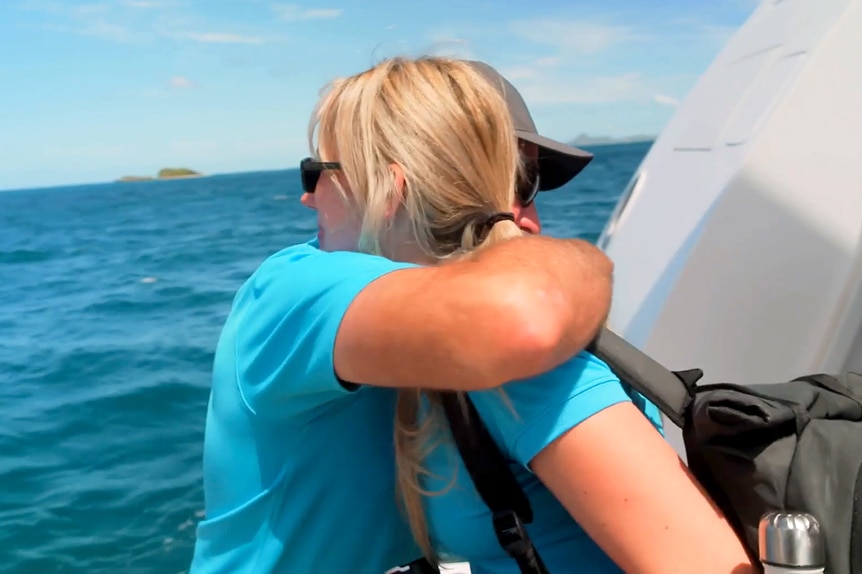
Captain Kerry Titheradge shares an update on how Cat Baugh is doing today
During an interview with Entertainment Weekly , Kerry opened up about how Cat was "really struggling" prior to her departure.
"I could just see it in her face. I didn't need to know what was going on. It didn't matter what it was. To her, it was catastrophic," he said. "And that's something else I've learned on my journey is that it's real to that person who's going through it. It doesn't matter if it doesn't affect you or how insignificant it may seem. It's real to them..."
Captain Kerry Titheradge Just Promoted This Crew Member to Bosun
Kerry has been in touch with Cat recently as well.
"She's having a hard time seeing herself where she's at. But she said she's in a pretty good headspace. And I've shown her support — I say, look, if you need someone to talk to, I'm always here," the captain concluded.
Watch new episodes of Below Deck Season 11 on Mondays at 9/8c on Bravo. Stream episodes the next day on Peacock .
RELATED: Shop Below Deck Buys That Are Way Cheaper Than Chartering a Yacht
- Kerry Titheradge
Related Stories

Get a Glimpse at Below Deck Alum Cat Baugh's Life Today

One Crew Member Got Fired and Another Left on Below Deck

Captain Kerry Just Promoted This Crew Member to Bosun

Who Captain Kerry Is Confronting in the Middle of the Night

Barbie Opens Up About Her Relationship with Her Ex-Husband

Watch Captain Kerry's Girlfriend Make Her Below Deck Debut

Captain Kerry Gushes About His Two Kids

Below Deck Season 11 Trailer Introduces a New Captain: Watch

All About Grenada: Details on Below Deck Season 11 Location

Captain Kerry Opens Up About His Girlfriend
Captain kerry teases below deck season 11, 11 things you don't know about captain kerry titheradge.

Latest Videos

Kerry Titheradge: “Time to Do Some Captain Sh*t”

The Crew Puts on a Murder Mystery Party

Fraser Olender: "We're in Deep Sh*t"
Recommended for you.

We Have a Major Update on Tom, Katie, and Katie

Kyle Says She Will Spend Christmas with Mauricio

Kim Richards Just Shocked Kyle with a New Update
Kitten season is out of control. Are warmer winters to blame?
The trend is bad news for shelters and wildlife alike..
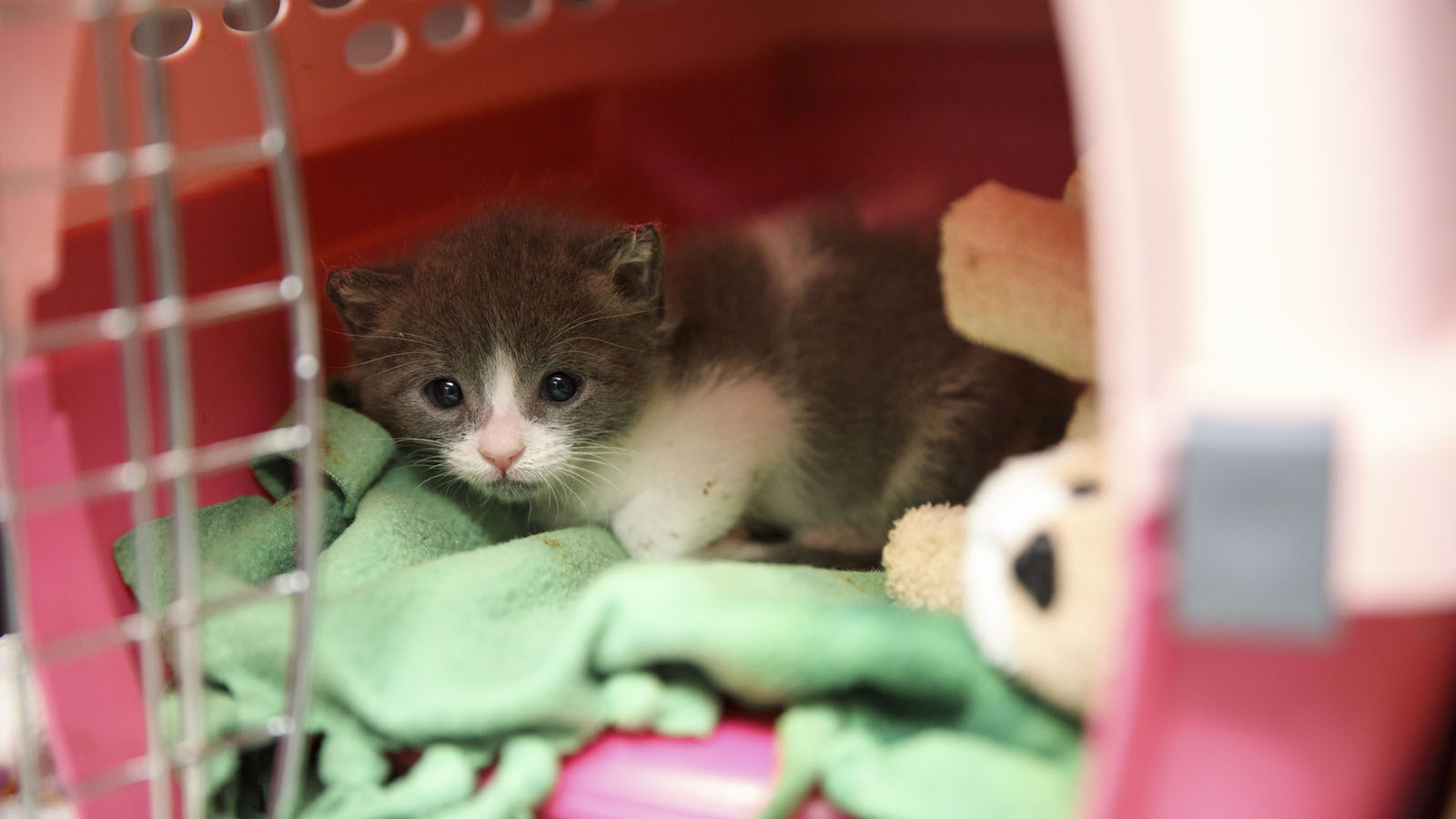
It’s almost that magical time of year that the Humane Society of America likens to a “ natural disaster .” Kitten season.
“The level of emotions for months on end is so draining,” said Ann Dunn, director of Oakland Animal Services, a city-run shelter in the San Francisco Bay Area. “And every year we just know it’s going to get harder.”
Across the United States, summer is the height of “kitten season,” typically defined as the warm-weather months between spring and fall during which a cat becomes most fertile. For over a decade , animal shelters across the country have noted kitten season starting earlier and lasting longer. Some experts say the effects of climate change, such as milder winters and an earlier start to spring , may be to blame for the uptick in feline birth rates.
This past February, Dunn’s shelter held a clinic for spaying and neutering outdoor cats. Although kitten season in Northern California doesn’t typically kick off until May, organizers found that over half of the female cats were already pregnant. “It’s terrifying,” Dunn said. “It just keeps getting earlier and going later.”
Grist thanks its sponsors. Become one .
To support our nonprofit environmental journalism, please consider disabling your ad-blocker to allow ads on Grist. Here's How
Unweaned kittens rest inside terrariums at the Best Friends Animal Society shelter in April 2017 in Mission Hills, California. A chart helps workers keep track of their behavior, weight, and care schedule. Patrick T. Fallon / The Washington Post via Getty Images
Cats reproduce when females begin estrus, more commonly known as “going into heat,” during which hormones and behavior changes signal she’s ready to mate. Cats can go into heat several times a year, with each cycle lasting up to two weeks. But births typically go up between the months of April and October. While it’s well established that lengthening daylight triggers a cat’s estrus, the effect of rising temperatures on kitten season isn’t yet understood.
One theory is that milder winters may mean cats have the resources to begin mating sooner. “No animal is going to breed unless they can survive,” said Christopher Lepczyk, an ecologist at Auburn University and prominent researcher of free-ranging cats. Outdoor cats’ food supply may also be increasing, as some prey, such as small rodents, may have population booms in warmer weather themselves. Kittens may also be more likely to survive as winters become less harsh. “I would argue that temperature really matters,” he said.
Others, like Peter J. Wolf, a senior strategist at the Best Friends Animal Society, think the increase comes down to visibility rather than anything biological. As the weather warms, Wolf said people may be getting out more and noticing kittens earlier in the year than before. Then they bring them into shelters, resulting in rescue groups feeling like kitten season is starting earlier.
Regardless of the exact mechanism, having a large number of feral cats around means trouble for more than just animal shelters. Cats are apex predators that can wreak havoc on local biodiversity. Research shows that outdoor cats on islands have already caused or contributed to the extinction of an estimated 33 species . Wild cats pose an outsized threat to birds, which make up half their diet. On Hawai ʻ i, known as a bird extinction capital of the world , cats are the most devastating predators of wildlife. “We know that cats are an invasive, environmental threat,” said Lepczyk, who has published papers proposing management policies for outdoor cats.

Scientists, conservationists, and cat advocates all agree unchecked outdoor cat populations are a problem, but they remain deeply divided on solutions. While some conservationists propose the targeted killing of cats, known as culling, cat populations have been observed to bounce back quickly , and a single female cat and her offspring can produce at least 100 descendants, if not thousands, in just seven years.
Although sterilization protocols such as “trap, neuter, and release” are favored by many cat rescue organizations, Lepczyk said it’s almost impossible to do it effectively, in part because of how freely the animals roam and how quickly they procreate. Without homes or sanctuaries after sterilization, returning cats outside means they may have a low quality of life, spread disease, and continue to harm wildlife. “No matter what technique you use, if you don’t stop the flow of new cats into the landscape, it’s not gonna matter,” said Lepczyk.
Rescue shelters, already under strain from resource and veterinary shortages, are scrambling to confront their new reality. While some release materials to help the community identify when outdoor kittens need intervention, others focus on recruiting for foster volunteer programs, which become essential caring for kittens who need around-the-clock-care.
“As the population continues to explode, how do we address all these little lives that need our help?” Dunn said. “We’re giving this everything we have.”
A message from
Support nonprofit news today
Grist is the only award-winning newsroom focused on exploring equitable solutions to climate change. It’s vital reporting made entirely possible by loyal readers like you. At Grist, we don’t believe in paywalls. Instead, we rely on our readers to pitch in what they can so that we can continue bringing you our solution-based climate news.
Grist is the only award-winning newsroom focused on exploring equitable solutions to climate change. It’s vital reporting made entirely possible by loyal readers like you. At Grist, we don’t believe in paywalls. Instead, we rely on our readers to pitch in what they can so that we can continue bringing you our solution-based climate news.
Dogs are sniffing out a legacy of pollution on the Blackfeet nation
Rain comes to the arctic, with a cascade of troubling changes, climate change and boat strikes are killing right whales. stronger speed limits could save them., why is the idea of the anthropocene so contentious, big oil faces a flood of climate lawsuits — and they’re moving closer to trial, santander has invested hundreds of millions of dollars in lng buildout in the gulf, here’s what happened when two climate reporters tried to ditch natural gas, with its new tailpipe rules, the epa eyes an electric future, california’s concerning embrace of a new forest biomass industry, modal gallery.
Does Cat quit Below Deck?

Does Cat quit on Below Deck? It’s a question Below Deck fans can’t help but ask as Season 11 nears the halfway point.
Stew Cat Baugh hasn’t had the easiest time on Below Deck, even with Fraser Olender and Captain Kerry Titheradge working hard to ensure she’s good.
This week, we saw Cat call home and cry over not vibing with the St. David group.
Thanks to the previews for next week’s episode of Below Deck, the rumor mill is buzzing that Cat will quit the hit-yachting show.
After all, it certainly doesn’t seem like Fraser will fire her, despite Cat lacking as a stew.
View this post on Instagram A post shared by OMFGRealityTV (@omfgrealitytv)
The entire season, Cat has felt on the outs even though others like Xandi Olivier and Fraser have gone out of their way to help her.
Based on the previews, Xandi is still losing it over Cat still not cleaning cabins correctly. It’s been three charters, and at this point, there shouldn’t still be this many issues with Cat’s performance as a stew.
All signs point to Cat quitting for her own mental health or Fraser giving her the option to resign instead of firing her.
This type of yachting doesn’t appear to be the right fit for Cat, who can’t really handle the pressure that comes with working on a boat like the St. David. Maybe she needs to focus on day charters close to home in Orange County, California.
Captain Kerry has previously stated that Below Deck Season 11 has a high crew turnover. The captain even feels like it broke a Below Deck record.
We feel confident that Cat doesn’t last the season, and as mentioned before, Fraser won’t fire her. That leaves Cat quitting, and it’s a safe bet she does it soon, like after or during the next charter.
Another emotional breakdown from Cat? Ugh. Get her off this damn boat. #BelowDeck pic.twitter.com/k0GZHNyptD — Dennis Velez, M.A. (@TheDennisVelez) March 12, 2024
Cat Baugh isn’t the only Below Deck Season 11 crew member in trouble
Below Deck spoilers reveal that Captain Kerry has a major decision to make about Bosun Jared Woodin after his recent action. Jared’s drunken behavior not only woke up Captain Kerry but also had deckhand Kyle Stillie feeling a bit threatened.
Like Cat, Jared hasn’t had the easiest time on the St. David yacht.
Jared, too, struggled with his job, especially when it comes to calling distances. Not being able to contact Jared has affected Jared’s mindset, too, and rightfully so.
All of this, plus his drunken behavior, has really forced Captain Kerry to make a decision about the bosun. Those wondering if Jared does get fired can find out here.
In the meantime, make sure to keep watching Below Deck to find out if Stew Cat Baugh opts to leave.
Below Deck airs Mondays at 9/8c on Bravo. Seasons 1-11 are streaming on Peacock.

IMAGES
VIDEO
COMMENTS
June 15, 2022. Cats are fun, safe, and friendly companions to countless liveaboard sailors. Caring for a cat on a sailboat can also be easy. Cats can live safely and comfortably aboard sailboats with proper space, ventilation, climate control, and safety precautions. Most cities and marinas allow cats aboard, and they're easy to care for if ...
Cat Food On Board. If you're cruising on your boat, you'll probably want to stock up on cat food just as you would other essential food items. When we buy cat food, we get an 18-pound bag of dry food along with many cases of wet food. To keep your cat's dry food fresh, it must be in a sealed container.
Your cat should also be fully vaccinated and cleared by a vet before they go on your sailboat. Other parts of keeping your cat safe on a sailboat involve getting your cat used to the boat itself ...
Cats can easily adapt to life on sailboats and do not require much attention regarding exercise. Cats do not need much space to lead a healthy life. They offer excellent company, especially if you are sailing alone. The cat can be a source of emotional support when you sometimes feel under the weather. Humans have kept them on ships and boats ...
Tiny Cat checking the anchor. It seems that if a cat's going to go for a swim, it will most likely happen at anchor. While the boat's underway, Tiny Cat tends to be a little cautious and stays in the cockpit or down below. At anchor, however, the boat is her playground and she becomes a bit of a demon!
Sailing With a Cat - The Essentials Training your cat for boat travel. Before taking your cat onboard a boat, it's important that they've reached a good level of training.. They should be able to recognise your voice and their own name, meaning you can call them back to safety should you run into danger.. To increase the effectiveness of your kitty's training, you could implement ...
Before bringing a cat on board, you must take steps to cat-proof your sailboat. You should "cat-proof" your boat by getting rid of or blocking your cat's access to any places that could be dangerous. Be careful first to close up any holes leading to the bilge. Most sailboat bilges are damp, unclean, and cramped, which creates problems.
Food. Like the humans on the boat, your pet will need a supply of food big enough to last the whole trip. Keep extra dry cat food onboard in case of emergencies. Fresh water. It's important to bring a supply of fresh water for your cat since drinking from other sources may make them sick. Sunscreen.
Jessie always came with us. In 2017 we became full time liveaboards on our Broadblue 385 sailing catamaran and of course took Jessie with us. We left the UK in July 2017 and have sailed almost 4,000 nautical miles with Jessie throughout the Mediterranean. So Jessie has been on boats since she was 8 weeks and we've been sailing with a cat for ...
Jun 24, 2013. Cruising Kitty. Cats make great cruising companions, but life on a boat can be challenging for them. Follow these tips to make sure your feline friend is safe and secure on board: Cats quickly find their sea legs, but falling overboard is always a possibility. Hang a carpet or towel off the stern to serve as a boarding ladder.
Cat Training, Feeding and Outdoor - FREE Blueprint:https://www.outdoorbengal.com/pages/download-free-ebookThis summer we circumnavigated Long Island on the S...
Ensure your boat is safe. Add an escape route for your cat. Although you will want to keep your cat inside the boat for at least the first 4 weeks to enable them to realise your narrowboat is their home now there is always a chance they will escape and find themselves in the canal, it's simply a hazard of cats on the cut.
Whenever you travel or move with cats, you should never leave home without your cat's essentials. As you pack for your afternoon on the boat, bring along a litter box, fresh litter, a water dish, and plenty of food. Once you unpack on the boat, make sure your cat knows where all of its supplies are to help it get comfortable.
Unlike dogs who tend to enjoy long rides either in cars or boats, cats tend to do poorly when placed in a moving vehicle. The nausea they feel is often exacerbated by the anxiety and stress of being in a strange new environment. Some of the symptoms of seasickness in cats include: Lethargy. Excessive drooling.
After marrying in 2008, Luisa Mixon and her husband, Seth, set their eyes to the sea. Like many Sailrite® customers, their dream was to buy a sailboat, learn to sail, and eventually gain enough experience to live completely on board. When they envision their retirement years, they see themselves sailing wherever their hearts, and the wind ...
It is our cat Pac's sixth birthday on the 10th of May so to celebrate, we thought we'd make this week's vlog all about the life of a boat cat 🐈 Having moved...
Whilst not common, cats can live on boats. In this guide I talk about cats and houseboats, canal boats, narrow boats, sailboats, and seasick cats.
Hello ! We are known on Instagram as @Ragamuffin_Pumpkin_MarineWe moved onto the boat in September. This is a video compilation of our adventures thus far. T...
I occasionally get asked what it's like living with cats on a sailboat, so I figured I'd put together a bit of a list to cover some of the more common questions I get asked about sailing with some cats on a yacht. I don't intend for this to become a penultimate 'how-to guide for boating with cats', just a sort of loose rundown of some things that I get asked about and some others that I think ...
St. Croix, like many places in the world, has a feral cat problem. Everyone on St. Croix who wants a cat has at least four. Everyone who doesn't want one has at least one. And so I found myself, a lover of cats, with seven formerly feral cats at the time that I sold my farm to move onto a boat. Luckily, the person who purchased the farm was willing to take on some of the cats, and so I left ...
Whip the Adventure Cat is the cutest cat living on a sailboat! In this video you'll get to see what "boat life" is really like...from Whip's perspective! He'...
After Cat hung up the phone, she had an emotional conversation with Fraser about her place on the boat. He chatted with Captain Kerry about how he thought it would be best for Cat to leave.
Cats are apex predators that can wreak havoc on local biodiversity. Research shows that outdoor cats on islands have already caused or contributed to the extinction of an estimated 33 species .
We want to share our GTFO plan to retire early and sail the world (on a Neel 51 trimaran). In this video, Ann & Dennis talk about sailing with cats.Please c...
Like Cat, Jared hasn't had the easiest time on the St. David yacht. Jared, too, struggled with his job, especially when it comes to calling distances. Not being able to contact Jared has ...
Cat Who Lives On A Boat Loves Visiting New Places | This cat has been sailing around the Atlantic with her parents her whole life and she loves to swim. You ...